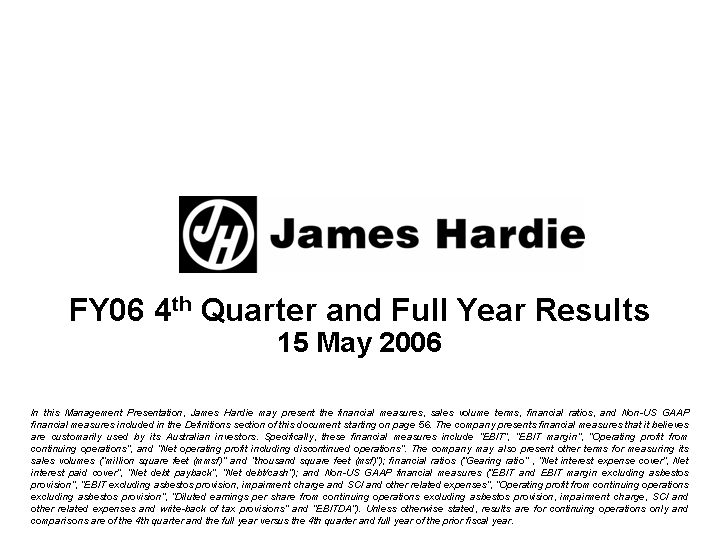
| Key Information | Year Ended 31 March | |||||||||
| 2006 | 2005 | |||||||||
| US$M | US$M | Movement | ||||||||
Net Sales From Ordinary Activities |
1,488.5 | 1,210.4 | Up | 23 | % | |||||
Operating (Loss) Profit From Continuing Operations After
Tax Attributable to Shareholders |
(506.7) | 127.9 | Down | — | ||||||
Operating (Loss) Profit Including Discontinued Operations
Attributable to Shareholders |
(506.7) | 126.9 | Down | — | ||||||
Net Tangible Assets per Ordinary Share |
US$0.20 | US$1.35 | Down | 85 | % | |||||
| Dividend Information |
| • | A dividend of US 4.0 cents per share/CUFS is payable to share/CUFS holders on 6 July 2006. A dividend of US 4 cents per share/CUFS was paid on 16 December 2005 and a dividend of US 6 cents per share/CUFS was paid on 1 July 2005. | |
| • | Record Date is 14 June 2006 to determine entitlements to the dividend payable to share /CUFS holders on 6 July 2006 (ie, on the basis of proper instruments of transfer received by the Company’s registrar, Computershare Investor Services Pty Ltd, Level 3, 60 Carrington Street, Sydney NSW 2000, Australia, by 5:00 pm if securities are not CHESS approved, or security holding balances established by 5:00 pm or such later time permitted by SCH Business Rules if securities are CHESS approved). | |
| • | This dividend and future dividends will be unfranked for Australian taxation purposes. | |
| • | This dividend is subject to Dutch withholding tax of 25%. Many Australian resident holders may reduce the withholding tax rate to 15% deduction if they are eligible and have completed and lodged a current special Form A before dividend record date with the Company’s registrar, Computershare Investor Services Pty Ltd, Level 3, 60 Carrington Street, Sydney NSW 2000, Australia. Holders with 25% withholding tax may be eligible to reclaim a portion of the tax after payment date. For withholding tax information see: www.Jameshardie.com (select Investor Relations, then Shareholder services then Tax Information) or contact Computershare. | |
| • | The Australian currency equivalent amount of dividend to be paid to CUFS holders will be announced to the ASX on 15 June 2006. | |
| • | No dividend reinvestment plans are available for this dividend. |
| Movements in Controlled Entities during the year ended 31 March 2006 |
| The following entities were incorporated: LGTDD Pty Ltd (6 September 2005), James Hardie Retail Inc (20 December 2005), Asbestos Injuries Compensation Fund Ltd (4 January 2006), James Hardie International Finance Holdings Sub I B.V. (13 March 2006) and James Hardie International Finance Holdings Sub II B.V. (13 March 2006). | ||
| The following entity was sold: James Hardie Fibrocementos Limitada (9 July 2005). | ||
| The following entities were liquidated: on 23 August 2005: James Hardie Australia Finance Pty Ltd, James Hardie FCTA Pty Ltd, James Hardie NSW Investments Pty Ltd and Snidloh Pty Ltd; on 14 October 2005: James Hardie Tech Pty Ltd, James Hardie Aust Investco Pty Ltd and James Hardie Aust Investco (Services) Pty Ltd; and on 29 December 2005: Ecanif Pty Ltd. |
| Audit |
| The results and financial information included within this Preliminary Final Report have been prepared using US GAAP and have been subject to an independent audit by external auditors. |
| 1. | Media Release | ||
| 2. | Management’s Analysis of Results | ||
| 3. | Management Presentation | ||
| 4. | Consolidated Financial Statements |
| James Hardie Industries N.V. is incorporated in The Netherlands with corporate seat in Amsterdam. The liability of members is limited. |
15 May 2006
|
Analyst and Media enquiries about results, please contact Steve Ashe on Tel: 61 2 8274 5246; Mob: 61 408 164 011 |
| US$ Million | Q4 FY06 | Q4 FY05 | % | FY06 | FY05 | % | |||||||||||||||||||
| Change | Change | ||||||||||||||||||||||||
Operating (loss) profit from continuing operations |
$ | (650.9 | ) | $ | 46.3 | — | $ | (506.7 | ) | $ | 127.9 | — | |||||||||||||
Asbestos provision |
715.6 | — | — | 715.6 | — | — | |||||||||||||||||||
Operating profit from continuing operations
excluding asbestos provision |
64.7 | 46.3 | 40 | 208.9 | 127.9 | 63 | |||||||||||||||||||
Impairment of roofing plant (net of tax benefit
of US$5.4 million) |
8.0 | — | — | 8.0 | — | — | |||||||||||||||||||
SCI and other related expenses (net of tax
benefit) |
2.5 | 2.1 | 19 | 16.5 | 22.3 | (26 | ) | ||||||||||||||||||
Write-back of tax provisions |
(20.7 | ) | — | — | (20.7 | ) | — | — | |||||||||||||||||
Operating profit from continuing operations
excluding asbestos provision, impairment charge,
SCI and other related expenses and write-back of
tax provisions |
$ | 54.5 | $ | 48.4 | 13 | $ | 212.7 | $ | 150.2 | 42 | |||||||||||||||
2
| US$ Million | Q4 FY06 | Q4 FY05 | %+\(-) | FY06 | FY05 | %+\(-) | |||||||||||||||||||
Net sales |
$ | 389.8 | $ | 316.4 | 23 | $ | 1,488.5 | $ | 1,210.4 | 23 | |||||||||||||||
Gross profit |
139.5 | 121.3 | 15 | 550.8 | 426.4 | 29 | |||||||||||||||||||
SCI and other related expenses |
(2.7 | ) | (3.7 | ) | (27 | ) | (17.4 | ) | (28.1 | ) | (38 | ) | |||||||||||||
Impairment of roofing plant |
(13.4 | ) | — | — | (13.4 | ) | — | — | |||||||||||||||||
Asbestos provision |
(715.6 | ) | — | — | (715.6 | ) | — | — | |||||||||||||||||
EBIT |
(662.6 | ) | 64.6 | — | (434.9 | ) | 196.2 | — | |||||||||||||||||
Net interest income (expense) |
0.7 | (0.6 | ) | — | (0.2 | ) | (5.1 | ) | (96 | ) | |||||||||||||||
Income tax benefit (expense) |
11.0 | (17.9 | ) | — | (71.6 | ) | (61.9 | ) | 16 | ||||||||||||||||
Operating (loss) profit from continuing
operations |
(650.9 | ) | 46.3 | — | (506.7 | ) | 127.9 | — | |||||||||||||||||
Net operating (loss) profit including
discontinued operations |
(650.9 | ) | 46.3 | — | (506.7 | ) | 126.9 | — | |||||||||||||||||
3
4
5
6
Telephone:
|
61 2 8274 5246 | |
Mobile:
|
61 408 164 011 | |
Email:
|
[email protected] | |
Facsimile:
|
61 2 8274 5218 |
7
| US$ Million | Q4 | Q4 | FY06 | FY05 | |||||||||||||
| FY06 | FY05 | ||||||||||||||||
EBIT |
$ | (662.6 | ) | $ | 64.6 | $ | (434.9 | ) | $ | 196.2 | |||||||
Asbestos provision |
715.6 | — | 715.6 | — | |||||||||||||
EBIT excluding asbestos provision |
53.0 | 64.6 | 280.7 | 196.2 | |||||||||||||
Net Sales |
389.8 | 316.4 | 1,488.5 | 1,210.4 | |||||||||||||
EBIT margin excluding asbestos provision |
13.6 | % | 20.4 | % | 18.9 | % | 16.2 | % | |||||||||
8
| US$ Million | Q4 | Q4 | FY06 | FY05 | |||||||||||||
| FY06 | FY05 | ||||||||||||||||
EBIT |
$ | (662.6 | ) | $ | 64.6 | $ | (434.9 | ) | $ | 196.2 | |||||||
Asbestos provision |
715.6 | — | 715.6 | — | |||||||||||||
Impairment of roofing plant |
13.4 | — | 13.4 | — | |||||||||||||
SCI and other related expenses |
2.7 | 3.7 | 17.4 | 28.1 | |||||||||||||
EBIT excluding asbestos
provision, impairment charge
and SCI and other related
expenses |
$ | 69.1 | $ | 68.3 | $ | 311.5 | $ | 224.3 | |||||||||
| US$ Million | Q4 | Q4 | FY06 | FY05 | |||||||||||||
| FY06 | FY05 | ||||||||||||||||
Operating (loss) profit from continuing operations |
$ | (650.9 | ) | $ | 46.3 | $ | (506.7 | ) | $ | 127.9 | |||||||
Asbestos provision |
715.6 | — | 715.6 | — | |||||||||||||
Operating profit from continuing operations
excluding asbestos provision |
$ | 64.7 | $ | 46.3 | $ | 208.9 | $ | 127.9 | |||||||||
| US$ Million (except share and per share data) | Q4 | Q4 | FY06 | FY05 | |||||||||||||
| FY06 | FY05 | ||||||||||||||||
Operating (loss) profit from continuing operations |
$ | (650.9 | ) | $ | 46.3 | $ | (506.7 | ) | $ | 127.9 | |||||||
Asbestos provision |
715.6 | — | 715.6 | — | |||||||||||||
Impairment of roofing plant (net of tax) |
8.0 | — | 8.0 | — | |||||||||||||
SCI and other related expenses (net of tax) |
2.5 | 2.1 | 16.5 | 22.3 | |||||||||||||
Write-back of tax provisions |
(20.7 | ) | — | (20.7 | ) | — | |||||||||||
Operating profit from continuing operations
excluding asbestos provision, impairment charge,
SCI and other related expenses and write-back of
tax provisions |
$ | 54.5 | $ | 48.4 | $ | 212.7 | $ | 150.2 | |||||||||
Weighted average common shares outstanding
(Millions) — Diluted |
467.0 | 463.2 | 465.0 | 461.0 | |||||||||||||
Diluted earnings per share from continuing
operations excluding asbestos provision,
impairment charge, SCI and other related expenses
and write-back of tax provisions (US cents) |
11.7 | 10.4 | 45.7 | 32.6 | |||||||||||||
9
| • | expectations that the conditions precedent to the Final Funding Agreement will be satisfied; | ||
| • | expectations about payments to a special purpose fund for the compensation of proven asbestos-related personal injury and death claims; | ||
| • | expectations concerning the company’s Australian Tax Office amended assessment; | ||
| • | expectations that the company’s credit facilities will be extended or renewed; | ||
| • | projections of operating results or financial condition; | ||
| • | statements regarding plans, objectives or goals, including those relating to competition, acquisitions, dispositions and products; | ||
| • | statements about future performance; and | ||
| • | statements about product or environmental liabilities. |
10
| US GAAP - US$ Million | Three Months and Twelve Months Ended 31 March 2006 | ||||||||||||||||||||||||
| Q4 FY06 | Q4 FY05 | % | FY06 | FY05 | % | ||||||||||||||||||||
| Change | Change | ||||||||||||||||||||||||
Net Sales |
|||||||||||||||||||||||||
USA Fibre Cement |
$ | 325.6 | $ | 247.2 | 32 | $ | 1,218.4 | $ | 939.2 | 30 | |||||||||||||||
Asia Pacific Fibre Cement |
57.2 | 58.2 | (2 | ) | 241.8 | 236.1 | 2 | ||||||||||||||||||
Other |
7.0 | 11.0 | (36 | ) | 28.3 | 35.1 | (19 | ) | |||||||||||||||||
Total Net Sales |
$ | 389.8 | $ | 316.4 | 23 | $ | 1,488.5 | $ | 1,210.4 | 23 | |||||||||||||||
Cost of goods sold |
(250.3 | ) | (195.1 | ) | 28 | (937.7 | ) | (784.0 | ) | 20 | |||||||||||||||
Gross profit |
139.5 | 121.3 | 15 | 550.8 | 426.4 | 29 | |||||||||||||||||||
Selling, general & administrative expense |
(63.4 | ) | (42.4 | ) | 50 | (209.8 | ) | (174.5 | ) | 20 | |||||||||||||||
Research & development expense |
(7.0 | ) | (5.2 | ) | 35 | (28.7 | ) | (21.6 | ) | 33 | |||||||||||||||
Special Commission of Inquiry (SCI) &
other related expenses |
(2.7 | ) | (3.7 | ) | (27 | ) | (17.4 | ) | (28.1 | ) | (38 | ) | |||||||||||||
Impairment of roofing plant |
(13.4 | ) | — | — | (13.4 | ) | — | — | |||||||||||||||||
Asbestos provision |
(715.6 | ) | — | — | (715.6 | ) | — | — | |||||||||||||||||
Other operating loss |
— | (5.4 | ) | — | (0.8 | ) | (6.0 | ) | (87 | ) | |||||||||||||||
EBIT |
(662.6 | ) | 64.6 | — | (434.9 | ) | 196.2 | — | |||||||||||||||||
Net interest income (expense) |
0.7 | (0.6 | ) | — | (0.2 | ) | (5.1 | ) | (96 | ) | |||||||||||||||
Other income (expense), net |
— | 0.2 | — | — | (1.3 | ) | — | ||||||||||||||||||
Operating (loss) profit from continuing
operations before income taxes |
(661.9 | ) | 64.2 | — | (435.1 | ) | 189.8 | — | |||||||||||||||||
Income tax benefit (expense) |
11.0 | (17.9 | ) | — | (71.6 | ) | (61.9 | ) | 16 | ||||||||||||||||
Operating (Loss) Profit From Continuing
Operations |
$ | (650.9 | ) | $ | 46.3 | — | $ | (506.7 | ) | $ | 127.9 | — | |||||||||||||
Net Operating (Loss) Profit Including
Discontinued Operations |
$ | (650.9 | ) | $ | 46.3 | — | $ | (506.7 | ) | $ | 126.9 | — | |||||||||||||
Tax rate |
— | 27.9 | % | — | — | 32.6 | % | — | |||||||||||||||||
Volume (mmsf) |
|||||||||||||||||||||||||
USA Fibre Cement |
575.1 | 472.6 | 22 | 2,182.8 | 1,855.1 | 18 | |||||||||||||||||||
Asia Pacific Fibre Cement |
90.3 | 89.5 | 1 | 368.3 | 376.9 | (2 | ) | ||||||||||||||||||
Average net sales price per unit (per msf) |
|||||||||||||||||||||||||
USA Fibre Cement |
US$566 | US$523 | 8 | US$558 | US$506 | 10 | |||||||||||||||||||
Asia Pacific Fibre Cement |
A$859 | A$834 | 3 | A$872 | A$846 | 3 | |||||||||||||||||||
Management’s Analysis of Results: James Hardie — 4th Quarter and Full Year FY06
|
2 |
Management’s Analysis of Results: James Hardie — 4th Quarter and Full Year FY06
|
3 |
Management’s Analysis of Results: James Hardie — 4th Quarter and Full Year FY06
|
4 |
Management’s Analysis of Results: James Hardie — 4th Quarter and Full Year FY06
|
5 |
Management’s Analysis of Results: James Hardie — 4th Quarter and Full Year FY06
|
6 |
Management’s Analysis of Results: James Hardie — 4th Quarter and Full Year FY06
|
7 |
| Q4 FY06 | Q4 FY05 | % Change | ||||||||||
USA Fibre Cement |
$ | 82.7 | $ | 77.1 | 7 | |||||||
Asia Pacific Fibre Cement |
9.3 | 12.3 | (24 | ) | ||||||||
Research & Development |
(3.9 | ) | (6.1 | ) | (36 | ) | ||||||
Other |
(3.8 | ) | (1.7 | ) | — | |||||||
Impairment of roofing plant |
(13.4 | ) | — | — | ||||||||
General Corporate |
(17.9 | ) | (17.0 | ) | 5 | |||||||
Asbestos provision |
(715.6 | ) | — | — | ||||||||
(Loss) earnings before interest and tax |
(662.6 | ) | 64.6 | — | ||||||||
Excluding: |
||||||||||||
Impairment of roofing plant |
13.4 | — | — | |||||||||
Asbestos provision |
715.6 | — | — | |||||||||
SCI and other related expenses |
2.7 | 3.7 | (27 | ) | ||||||||
EBIT excluding asbestos provision,
impairment charge and SCI and other
related expenses |
$ | 69.1 | $ | 68.3 | 1 | |||||||
Net sales |
$ | 389.8 | $ | 316.4 | 23 | |||||||
EBIT margin excluding asbestos
provision, impairment charge and SCI
and other related expenses |
17.7 | % | 21.6 | % | — | |||||||
| FY06 | FY05 | % Change | ||||||||||
USA Fibre Cement |
$ | 342.6 | $ | 241.5 | 42 | |||||||
Asia Pacific Fibre Cement |
41.7 | 46.8 | (11 | ) | ||||||||
Research & Development |
(15.7 | ) | (17.5 | ) | (10 | ) | ||||||
Other |
(13.1 | ) | (11.8 | ) | 11 | |||||||
Impairment of roofing plant |
(13.4 | ) | — | — | ||||||||
General Corporate |
(61.4 | ) | (62.8 | ) | (2 | ) | ||||||
Asbestos provision |
(715.6 | ) | — | — | ||||||||
(Loss) earnings before interest and tax |
(434.9 | ) | 196.2 | — | ||||||||
Excluding: |
||||||||||||
Impairment of roofing plant |
13.4 | — | — | |||||||||
Asbestos provision |
715.6 | — | — | |||||||||
SCI and other related expenses |
17.4 | 28.1 | (38 | ) | ||||||||
EBIT excluding asbestos provision,
impairment charge and SCI and other
related expenses |
$ | 311.5 | $ | 224.3 | 39 | |||||||
Net sales |
$ | 1,488.5 | $ | 1,210.4 | 23 | |||||||
EBIT margin excluding asbestos
provision, impairment charge and SCI
and other related expenses |
20.9 | % | 18.5 | % | ||||||||
Management’s Analysis of Results: James Hardie — 4th Quarter and Full Year FY06
|
8 |
Management’s Analysis of Results: James Hardie — 4th Quarter and Full Year FY06
|
9 |
Management’s Analysis of Results: James Hardie — 4th Quarter and Full Year FY06
|
10 |
| Q4 FY06 | Q4 FY05 | % Change | ||||||||||
Operating (loss) profit from continuing operations |
$ | (650.9 | ) | $ | 46.3 | — | ||||||
Excluding: |
||||||||||||
Impairment of roofing plant (net of tax) |
8.0 | — | — | |||||||||
Asbestos provision |
715.6 | — | — | |||||||||
SCI and other related expense (net of tax) |
2.5 | 2.1 | 19 | |||||||||
Write-back of tax provisions |
(20.7 | ) | — | — | ||||||||
Operating profit from continuing operations
excluding asbestos provision, impairment charge,
SCI and other related expenses and write-back of
tax provisions |
$ | 54.5 | $ | 48.4 | 13 | |||||||
| FY06 | FY05 | % Change | ||||||||||
Operating (loss) profit from continuing operations |
$ | (506.7 | ) | $ | 127.9 | — | ||||||
Excluding: |
||||||||||||
Impairment of roofing plant (net of tax) |
8.0 | — | — | |||||||||
Asbestos provision |
715.6 | — | — | |||||||||
SCI and other related expense (net of tax) |
16.5 | 22.3 | (26 | ) | ||||||||
Write-back of tax provisions |
(20.7 | ) | — | — | ||||||||
Operating profit from continuing operations
excluding asbestos provision, impairment charge,
SCI and other related expenses and write-back of
tax provisions |
$ | 212.7 | $ | 150.2 | 42 | |||||||
Management’s Analysis of Results: James Hardie — 4th Quarter and Full Year FY06
|
11 |
| Effective | Principal | |||||||||||
| Interest Rate | Total Facility | Outstanding | ||||||||||
| Description | at | at | at | |||||||||
| 31 Mar 2006 | 31 Mar 2006 | 31 Mar 2006 | ||||||||||
| (US$ millions) | ||||||||||||
US$ notes, fixed
interest, repayable
annually in varying
tranches from
November 2006
through November
2013 |
7.16 | % | $ | 121.7 | $ | 121.7 | ||||||
US$ 364-day
facilities, can be
drawn in US$,
variable interest
rates based on
LIBOR plus margin,
can be repaid and
redrawn until
December 2006 |
5.41 | % | 110.0 | 81.0 | ||||||||
US$ term
facilities, can be
drawn in US$,
variable interest
rates based on
LIBOR plus margin,
can be repaid and
redrawn until June
2006 |
5.27 | % | 245.0 | 100.0 | ||||||||
Total |
$ | 476.7 | $ | 302.7 | ||||||||
Management’s Analysis of Results: James Hardie — 4th Quarter and Full Year FY06
|
12 |
| • | the establishment of the SPF to compensate asbestos sufferers with claims against the former James Hardie Group subsidiaries, Amaca Pty Ltd, Amaba Pty Ltd or ABN 60 Pty Ltd; | |
| • | initial funding of the SPF by James Hardie of approximately A$154 million; | |
| • | a two-year rolling cash ‘buffer’ in the SPF and an annual contribution in advance, based on actuarial assessments of expected claims for the following three years, revised annually and subject to certain limitations; | |
| • | a cap on the annual James Hardie payments to the SPF in all years, except the first year, initially set at 35% of annual net operating cash flow of the company for the immediately preceding financial year, with provision for the percentage to decline over time, depending on James Hardie’s financial performance and the claims outlook; | |
| • | no cap on individual payments to proven claimants; and | |
| • | special compensation arrangements for members of the Baryulgil community for asbestos-related claims arising from the activities of Marlew Mining Pty Ltd. |
Management’s Analysis of Results: James Hardie — 4th Quarter and Full Year FY06
|
13 |
Telephone:
|
61 2 8274 5246 | |
Mobile:
|
61 408 164 011 | |
Email:
|
[email protected] | |
Facsimile:
|
61 2 8274 5218 |
Management’s Analysis of Results: James Hardie — 4th Quarter and Full Year FY06
|
14 |
| US$ Million | Q4 | Q4 | FY06 | FY05 | |||||||||||||
| FY06 | FY05 | ||||||||||||||||
EBIT |
$ | (662.6 | ) | $ | 64.6 | $ | (434.9 | ) | $ | 196.2 | |||||||
Asbestos provision |
715.6 | — | 715.6 | — | |||||||||||||
EBIT excluding asbestos provision |
53.0 | 64.6 | 280.7 | 196.2 | |||||||||||||
Net Sales |
389.8 | 316.4 | 1,488.5 | 1,210.4 | |||||||||||||
EBIT margin excluding asbestos provision |
13.6 | % | 20.4 | % | 18.9 | % | 16.2 | % | |||||||||
Management’s Analysis of Results: James Hardie — 4th Quarter and Full Year FY06
|
15 |
| US$ Million | Q4 | Q4 | FY06 | FY05 | |||||||||||||
| FY06 | FY05 | ||||||||||||||||
EBIT |
$ | (662.6 | ) | $ | 64.6 | $ | (434.9 | ) | $ | 196.2 | |||||||
Asbestos provision |
715.6 | — | 715.6 | — | |||||||||||||
Impairment of roofing plant |
13.4 | — | 13.4 | — | |||||||||||||
SCI and other related expenses |
2.7 | 3.7 | 17.4 | 28.1 | |||||||||||||
EBIT excluding asbestos
provision, impairment charge and
SCI and other related expenses |
69.1 | 68.3 | 311.5 | 224.3 | |||||||||||||
| US$ Million | Q4 | Q4 | FY06 | FY05 | |||||||||||||
| FY06 | FY05 | ||||||||||||||||
Operating (loss) profit from continuing operations |
$ | (650.9 | ) | $ | 46.3 | $ | (506.7 | ) | $ | 127.9 | |||||||
Asbestos provision |
715.6 | — | 715.6 | — | |||||||||||||
Operating profit from continuing operations
excluding asbestos provision |
64.7 | 46.3 | 208.9 | 127.9 | |||||||||||||
| US$ Million (except share and per share data) | Q4 | Q4 | FY06 | FY05 | |||||||||||||
| FY06 | FY05 | ||||||||||||||||
Operating (loss) profit from continuing operations |
$ | (650.9 | ) | $ | 46.3 | $ | (506.7 | ) | $ | 127.9 | |||||||
Asbestos provision |
715.6 | — | 715.6 | — | |||||||||||||
Impairment of roofing plant (net of tax) |
8.0 | — | 8.0 | — | |||||||||||||
SCI and other related expenses (net of tax) |
2.5 | 2.1 | 16.5 | 22.3 | |||||||||||||
Write-back of tax provisions |
(20.7 | ) | — | (20.7 | ) | — | |||||||||||
Operating profit from continuing operations
excluding asbestos provision, impairment charge,
SCI and other related expenses and write-back of
tax provisions |
54.5 | 48.4 | 212.7 | 150.2 | |||||||||||||
Weighted average common shares outstanding
(Millions) — Diluted |
467.0 | 463.2 | 465.0 | 461.0 | |||||||||||||
Diluted earnings per share from continuing
operations excluding asbestos provision,
impairment charge, SCI and other related expenses
and write-back of tax provisions (cents) |
11.7 | 10.4 | 45.7 | 32.6 | |||||||||||||
Management’s Analysis of Results: James Hardie — 4th Quarter and Full Year FY06
|
16 |
Management’s Analysis of Results: James Hardie — 4th Quarter and Full Year FY06
|
17 |
| Pro Forma | Pro Forma | |||||||||||||
| Total Fibre | ||||||||||||||
| Cement | Asbestos | |||||||||||||
| US$ Million | Operations | provision | As Reported | |||||||||||
ASSETS |
||||||||||||||
Current assets: |
||||||||||||||
Cash and cash equivalents |
$ | 315.1 | $ | — | $ | 315.1 | ||||||||
Accounts and notes receivable, net of
allowance for doubtful accounts of $1.3
million |
153.2 | — | 153.2 | |||||||||||
Inventories |
124.0 | — | 124.0 | |||||||||||
Prepaid expenses and other current assets |
33.8 | — | 33.8 | |||||||||||
Deferred income taxes |
30.7 | — | 30.7 | |||||||||||
Total current assets |
656.8 | — | 656.8 | |||||||||||
Property, plant and equipment, net |
775.6 | — | 775.6 | |||||||||||
Deferred income taxes |
4.8 | — | 4.8 | |||||||||||
Other assets |
8.2 | — | 8.2 | |||||||||||
Total assets |
$ | 1,445.4 | $ | — | $ | 1,445.4 | ||||||||
LIABILITIES AND SHAREHOLDERS’ EQUITY |
||||||||||||||
Current liabilities: |
||||||||||||||
Accounts payable and accrued liabilities |
$ | 117.8 | $ | — | $ | 117.8 | ||||||||
Current portion of long-term debt |
121.7 | — | 121.7 | |||||||||||
Short-term debt |
181.0 | — | 181.0 | |||||||||||
Accrued payroll and employee benefits |
46.3 | — | 46.3 | |||||||||||
Accrued product warranties |
11.4 | — | 11.4 | |||||||||||
Income taxes payable |
24.5 | — | 24.5 | |||||||||||
Other liabilities |
3.3 | — | 3.3 | |||||||||||
Total current liabilities |
506.0 | — | 506.0 | |||||||||||
Deferred income taxes |
79.8 | — | 79.8 | |||||||||||
Accrued product warranties |
4.1 | — | 4.1 | |||||||||||
Asbestos provision |
— | 715.6 | 715.6 | |||||||||||
Other liabilities |
45.0 | — | 45.0 | |||||||||||
Total liabilities |
634.9 | 715.6 | 1,350.5 | |||||||||||
Commitments and contingencies |
||||||||||||||
Shareholders’ equity |
||||||||||||||
Common stock, Euro 0.59 par value, 2.0
billion shares authorised; 463,306,511 shares
issued and outstanding |
253.2 | — | 253.2 | |||||||||||
Additional paid-in capital |
158.8 | — | 158.8 | |||||||||||
Retained earnings (deficit) |
427.3 | (715.6 | ) | (288.3 | ) | |||||||||
Employee loans |
(0.4 | ) | — | (0.4 | ) | |||||||||
Accumulated other comprehensive loss |
(28.4 | ) | — | (28.4 | ) | |||||||||
Total
shareholders’ equity |
810.5 | (715.6 | ) | 94.9 | ||||||||||
Total
liabilities and shareholders’ equity |
$ | 1,445.4 | $ | — | $ | 1,445.4 | ||||||||
Management’s Analysis of Results: James Hardie — 4th Quarter and Full Year FY06
|
18 |
| Pro Forma | Pro Forma | |||||||||||||
| Total Fibre | ||||||||||||||
| Cement | Asbestos | |||||||||||||
| US$ Million | Operations | provision | As Reported | |||||||||||
Net Sales |
||||||||||||||
USA Fibre Cement |
$ | 1,218.4 | $ | — | $ | 1,218.4 | ||||||||
Asia Pacific Fibre Cement |
241.8 | — | 241.8 | |||||||||||
Other |
28.3 | — | 28.3 | |||||||||||
Total Net Sales |
$ | 1,488.5 | $ | — | $ | 1,488.5 | ||||||||
Cost of goods sold |
(937.7 | ) | — | (937.7 | ) | |||||||||
Gross profit |
550.8 | — | 550.8 | |||||||||||
Selling, general and administrative expenses |
(209.8 | ) | — | (209.8 | ) | |||||||||
Research and development expenses |
(28.7 | ) | — | (28.7 | ) | |||||||||
SCI and other related expenses |
(17.4 | ) | — | (17.4 | ) | |||||||||
Impairment of roofing plant |
(13.4 | ) | — | (13.4 | ) | |||||||||
Asbestos provision |
— | (715.6 | ) | (715.6 | ) | |||||||||
Other operating expense |
(0.8 | ) | — | (0.8 | ) | |||||||||
EBIT |
280.7 | (715.6 | ) | (434.9 | ) | |||||||||
Net interest expense |
(0.2 | ) | — | (0.2 | ) | |||||||||
Operating
profit (loss) from continuing operations before income
taxes |
280.5 | (715.6 | ) | (435.1 | ) | |||||||||
Income tax expense |
(71.6 | ) | — | (71.6 | ) | |||||||||
Operating Profit (Loss) From Continuing Operations |
$ | 208.9 | $ | (715.6 | ) | $ | (506.7 | ) | ||||||
Net Operating Profit (Loss) Including
Discontinued Operations |
$ | 208.9 | $ | (715.6 | ) | $ | (506.7 | ) | ||||||
Effective Tax Rate |
25.5 | % | — | — | ||||||||||
Volume (mmsf) |
||||||||||||||
USA Fibre Cement |
2,182.8 | — | 2,182.8 | |||||||||||
Asia Pacific Fibre Cement |
368.3 | — | 368.3 | |||||||||||
Average net sales price per unit (per msf) |
||||||||||||||
USA Fibre Cement |
US$558 | — | US$558 | |||||||||||
Asia Pacific Fibre Cement |
A$872 | — | A$872 | |||||||||||
Management’s Analysis of Results: James Hardie — 4th Quarter and Full Year FY06
|
19 |
| Pro Forma | Pro Forma | |||||||||||||
| Total Fibre | ||||||||||||||
| Cement | Asbestos | |||||||||||||
| US $ Million | Operations | provision | As Reported | |||||||||||
Cash Flows From Operating Activities |
||||||||||||||
Net income (loss) |
$ | 208.9 | $ | (715.6 | ) | $ | (506.7 | ) | ||||||
Adjustments to reconcile net income (loss) to net cash provided
by operating activities: |
||||||||||||||
Depreciation and amortisation |
45.3 | — | 45.3 | |||||||||||
Deferred income taxes |
4.3 | — | 4.3 | |||||||||||
Prepaid pension cost |
2.9 | — | 2.9 | |||||||||||
Tax benefit from stock options exercised |
2.2 | — | 2.2 | |||||||||||
Stock compensation |
5.9 | — | 5.9 | |||||||||||
Asbestos provision |
— | 715.6 | 715.6 | |||||||||||
Impairment of roofing plant |
13.4 | 13.4 | ||||||||||||
Other |
1.7 | — | 1.7 | |||||||||||
Changes in operating assets and liabilities: |
||||||||||||||
Accounts and notes receivable |
(24.0 | ) | — | (24.0 | ) | |||||||||
Inventories |
(26.6 | ) | — | (26.6 | ) | |||||||||
Prepaid expenses and other current assets |
(24.8 | ) | — | (24.8 | ) | |||||||||
Accounts payable and accrued liabilities |
24.4 | — | 24.4 | |||||||||||
Other accrued liabilities and other liabilities |
7.0 | — | 7.0 | |||||||||||
Net cash provided by operating activities |
240.6 | — | 240.6 | |||||||||||
Cash Flows From Investing Activities |
||||||||||||||
Purchases of property, plant and equipment |
(162.0 | ) | — | (162.0 | ) | |||||||||
Proceeds from disposal of subsidiary, net of cash divested |
8.0 | 8.0 | ||||||||||||
Net cash used in investing activities |
(154.0 | ) | — | (154.0 | ) | |||||||||
Cash Flows From Financing Activities |
||||||||||||||
Proceeds from borrowings |
181.0 | — | 181.0 | |||||||||||
Repayments of borrowings |
(37.6 | ) | — | (37.6 | ) | |||||||||
Proceeds from issuance of shares |
18.7 | — | 18.7 | |||||||||||
Dividends paid |
(45.9 | ) | — | (45.9 | ) | |||||||||
Collections on loan receivable |
0.3 | — | 0.3 | |||||||||||
Net cash provided by financing activities |
116.5 | — | 116.5 | |||||||||||
Effects of exchange rate changes on cash |
(1.5 | ) | — | (1.5 | ) | |||||||||
Net increase in cash and cash equivalents |
201.6 | — | 201.6 | |||||||||||
Cash and cash equivalents at beginning of period |
113.5 | — | 113.5 | |||||||||||
Cash and cash equivalents at end of period |
$ | 315.1 | $ | — | $ | 315.1 | ||||||||
Components of Cash and Cash Equivalents |
||||||||||||||
Cash at bank and on hand |
$ | 24.9 | $ | — | $ | 24.9 | ||||||||
Short-term deposits |
290.2 | — | 290.2 | |||||||||||
Cash and cash equivalents at end of period |
$ | 315.1 | $ | — | $ | 315.1 | ||||||||
Management’s Analysis of Results: James Hardie — 4th Quarter and Full Year FY06
|
20 |
| • | expectations that the conditions precedent to the Final Funding Agreement will be satisfied; | ||
| • | expectations about payments to a special purpose fund for the compensation of proven asbestos-related personal injury and death claims; | ||
| • | expectations concerning the company’s Australian Tax Office amended assessment; | ||
| • | expectations that the company’s credit facilities will be extended or renewed; | ||
| • | projections of operating results or financial condition; | ||
| • | statements regarding plans, objectives or goals, including those relating to competition, acquisitions, dispositions and products; | ||
| • | statements about future performance; and | ||
| • | statements about product or environmental liabilities. |
Management’s Analysis of Results: James Hardie — 4th Quarter and Full Year FY06
|
21 |

| FY06 4th Quarter and Full Year Results 15 May 2006 In this Management Presentation, James Hardie may present the financial measures, sales volume terms, financial ratios, and Non-US GAAP financial measures included in the Definitions section of this document starting on page 56. The company presents financial measures that it believes are customarily used by its Australian investors. Specifically, these financial measures include "EBIT", "EBIT margin", "Operating profit from continuing operations", and "Net operating profit including discontinued operations". The company may also present other terms for measuring its sales volumes ("million square feet (mmsf)" and "thousand square feet (msf)"); financial ratios ("Gearing ratio" , "Net interest expense cover", Net interest paid cover", "Net debt payback", "Net debt/cash"); and Non-US GAAP financial measures ("EBIT and EBIT margin excluding asbestos provision", "EBIT excluding asbestos provision, impairment charge and SCI and other related expenses", "Operating profit from continuing operations excluding asbestos provision", "Diluted earnings per share from continuing operations excluding asbestos provision, impairment charge, SCI and other related expenses and write-back of tax provisions" and "EBITDA"). Unless otherwise stated, results are for continuing operations only and comparisons are of the 4th quarter and the full year versus the 4th quarter and full year of the prior fiscal year. |
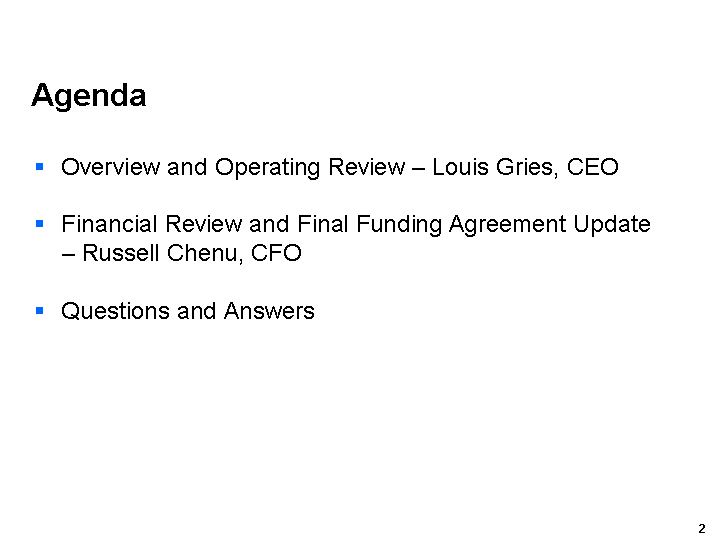
| Overview and Operating Review - Louis Gries, CEO Financial Review and Final Funding Agreement Update - Russell Chenu, CFO Questions and Answers Agenda |
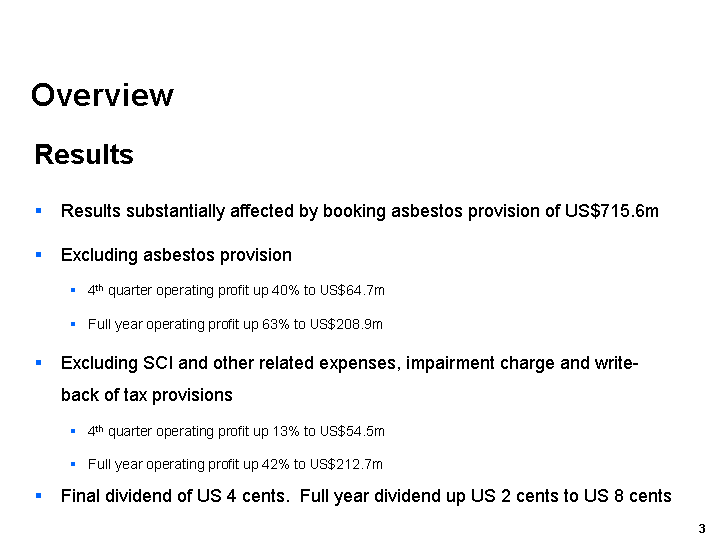
| Overview Results Results substantially affected by booking asbestos provision of US$715.6m Excluding asbestos provision 4th quarter operating profit up 40% to US$64.7m Full year operating profit up 63% to US$208.9m Excluding SCI and other related expenses, impairment charge and write- back of tax provisions 4th quarter operating profit up 13% to US$54.5m Full year operating profit up 42% to US$212.7m Final dividend of US 4 cents. Full year dividend up US 2 cents to US 8 cents |
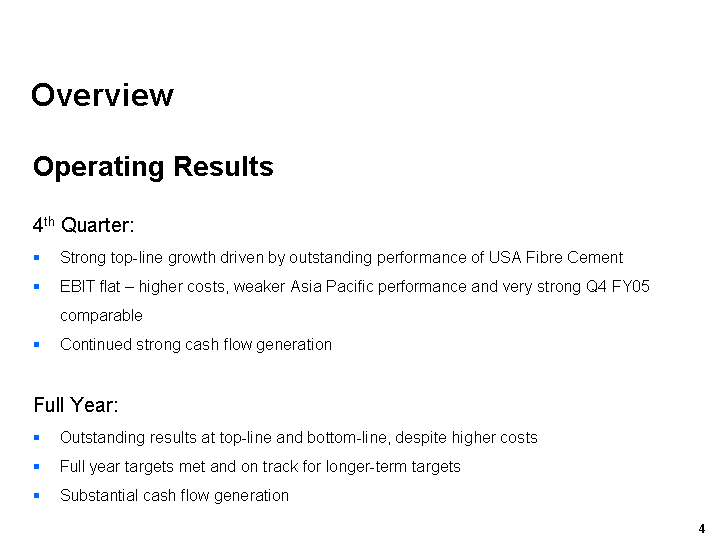
| Overview Operating Results 4th Quarter: Strong top-line growth driven by outstanding performance of USA Fibre Cement EBIT flat - higher costs, weaker Asia Pacific performance and very strong Q4 FY05 comparable Continued strong cash flow generation Full Year: Outstanding results at top-line and bottom-line, despite higher costs Full year targets met and on track for longer-term targets Substantial cash flow generation |
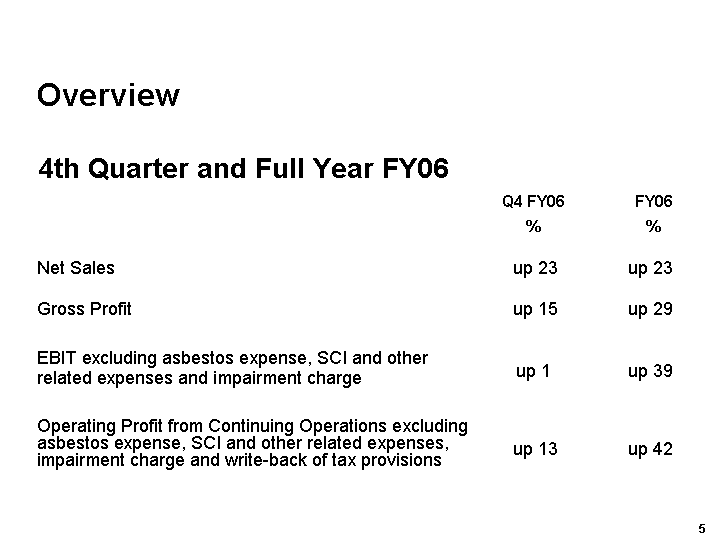
| Overview 4th Quarter and Full Year FY06 Q4 FY06 % FY06 % Net Sales up 23 up 23 Gross Profit up 15 up 29 EBIT excluding asbestos expense, SCI and other related expenses and impairment charge up 1 up 39 Operating Profit from Continuing Operations excluding asbestos expense, SCI and other related expenses, impairment charge and write-back of tax provisions up 13 up 42 |
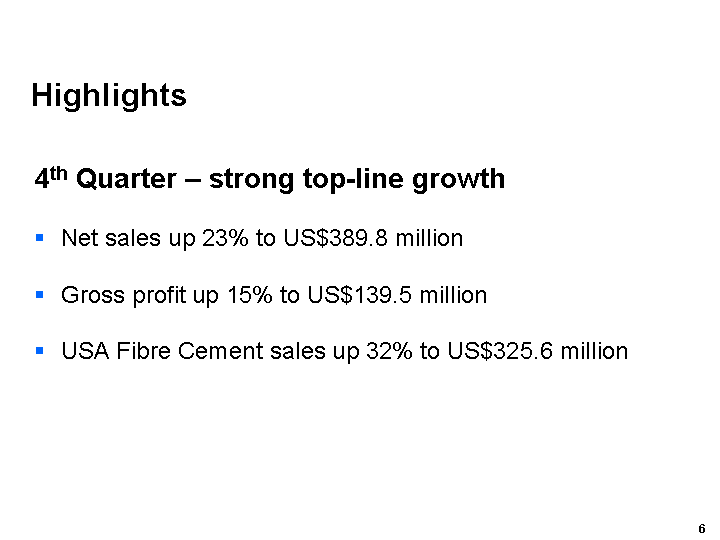
| Highlights 4th Quarter - strong top-line growth Net sales up 23% to US$389.8 million Gross profit up 15% to US$139.5 million USA Fibre Cement sales up 32% to US$325.6 million |
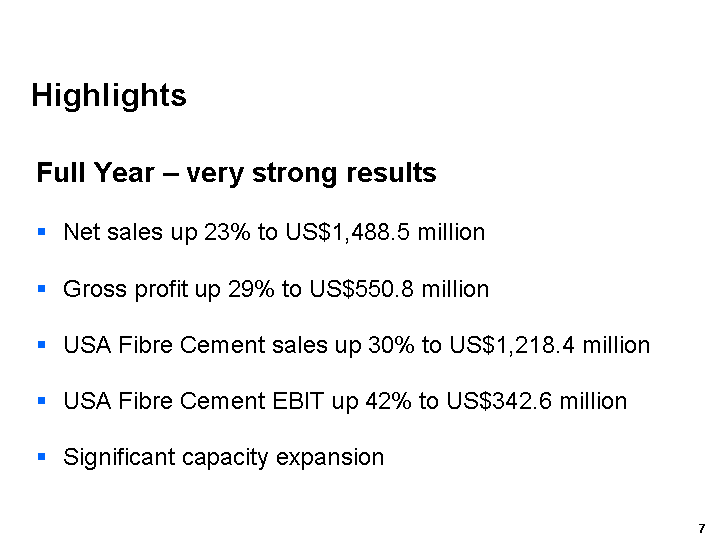
| Highlights Full Year - very strong results Net sales up 23% to US$1,488.5 million Gross profit up 29% to US$550.8 million USA Fibre Cement sales up 30% to US$1,218.4 million USA Fibre Cement EBIT up 42% to US$342.6 million Significant capacity expansion |
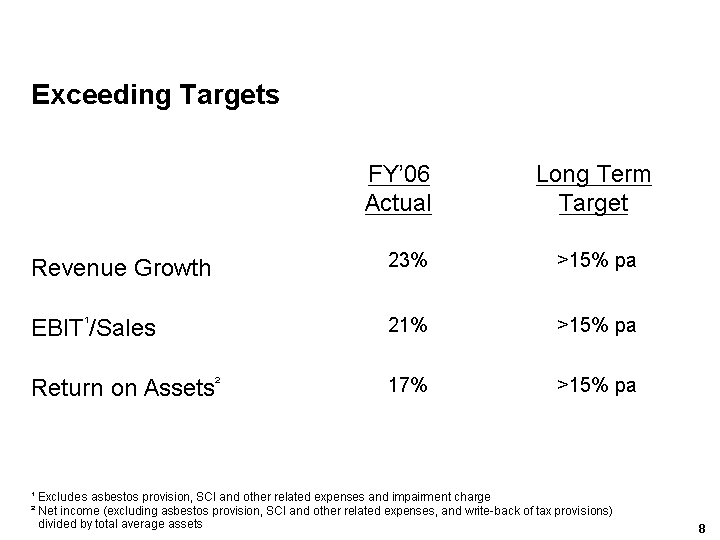
| Exceeding Targets FY'06 Actual Long Term Target Revenue Growth 23% >15% pa EBIT1/Sales 21% >15% pa Return on Assets2 17% >15% pa 1 Excludes asbestos provision, SCI and other related expenses and impairment charge 2 Net income (excluding asbestos provision, SCI and other related expenses, and write-back of tax provisions) divided by total average assets |
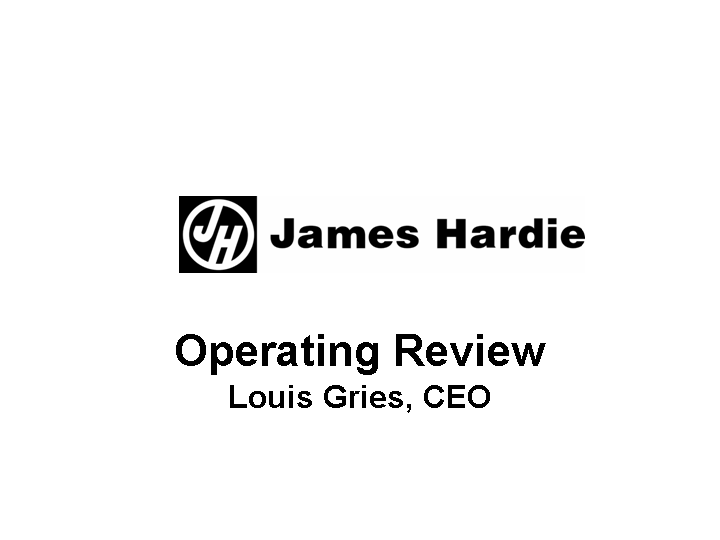
| Operating Review Louis Gries, CEO |
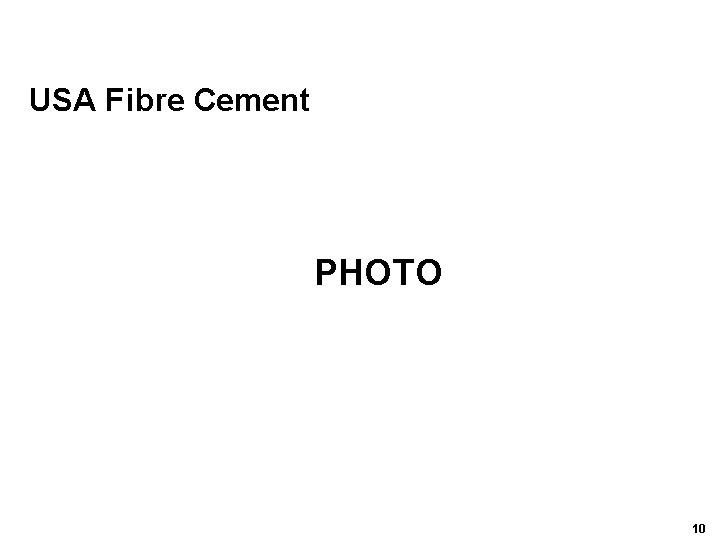
| USA Fibre Cement PHOTO |

| 4th Quarter Result - very strong sales growth Net Sales up 32% to US$325.6 million Sales Volume up 22% to 575.1 mmsf Average Price up 8% to US$566 per msf EBIT up 7% to US$82.7 million EBIT Margin down 5.8 pts to 25.4% USA Fibre Cement |
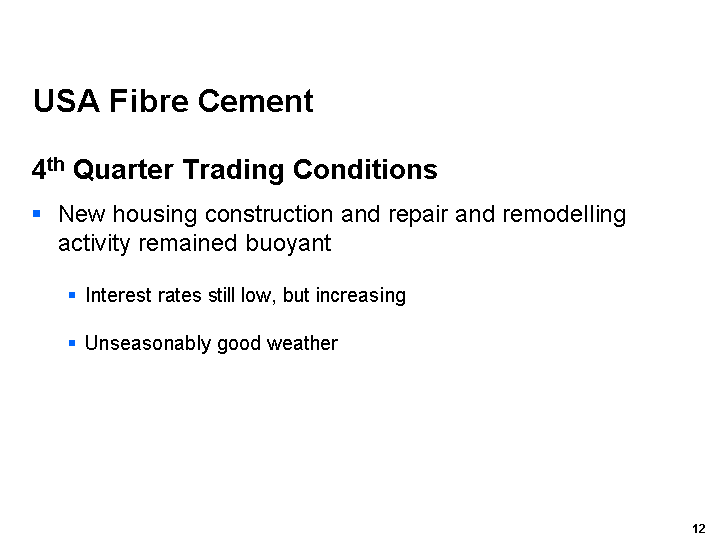
| USA Fibre Cement 4th Quarter Trading Conditions New housing construction and repair and remodelling activity remained buoyant Interest rates still low, but increasing Unseasonably good weather |
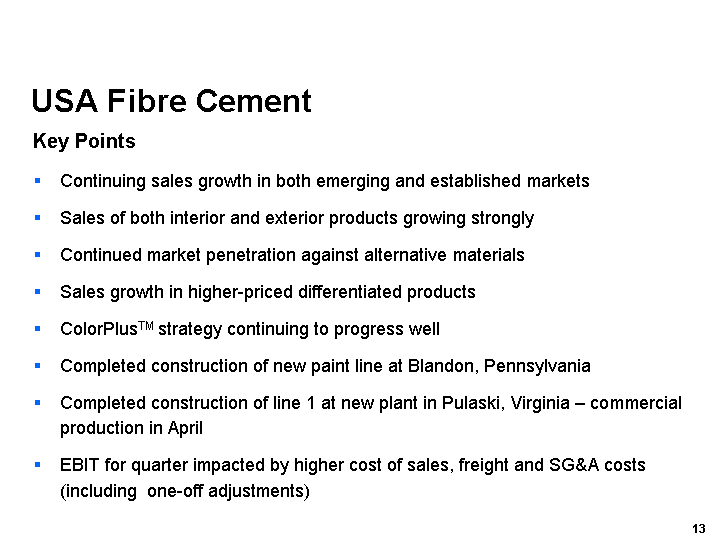
| USA Fibre Cement Key Points Continuing sales growth in both emerging and established markets Sales of both interior and exterior products growing strongly Continued market penetration against alternative materials Sales growth in higher-priced differentiated products ColorPlusTM strategy continuing to progress well Completed construction of new paint line at Blandon, Pennsylvania Completed construction of line 1 at new plant in Pulaski, Virginia - commercial production in April EBIT for quarter impacted by higher cost of sales, freight and SG&A costs (including one-off adjustments) |
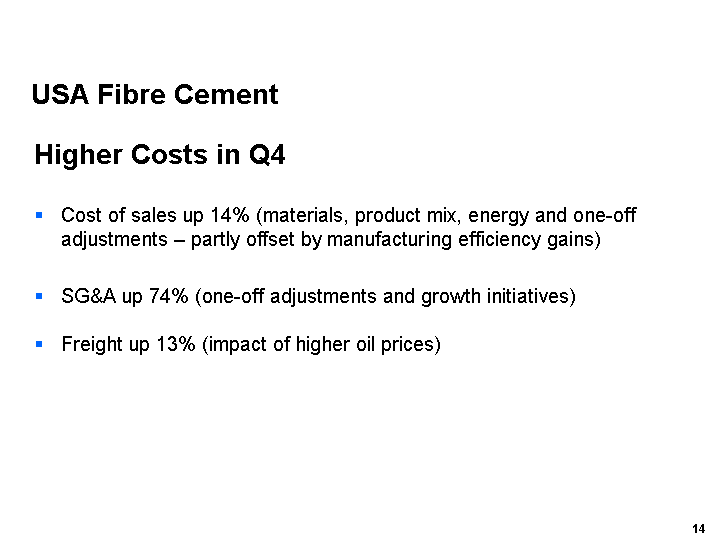
| USA Fibre Cement Higher Costs in Q4 Cost of sales up 14% (materials, product mix, energy and one-off adjustments - partly offset by manufacturing efficiency gains) SG&A up 74% (one-off adjustments and growth initiatives) Freight up 13% (impact of higher oil prices) |
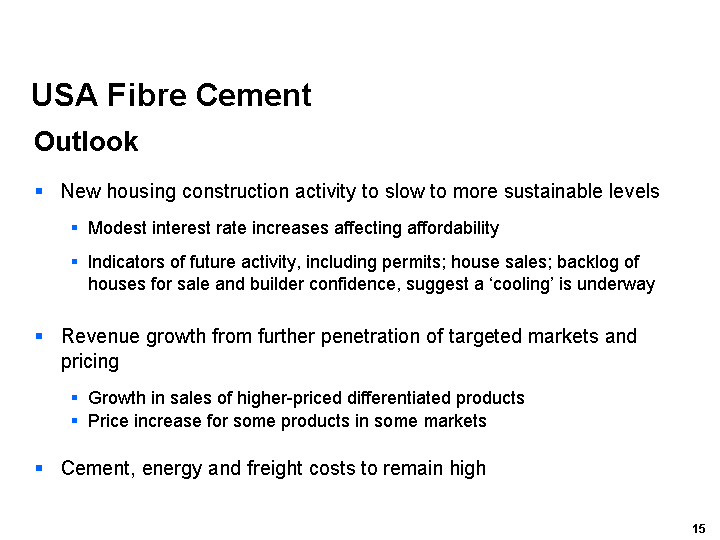
| USA Fibre Cement Outlook New housing construction activity to slow to more sustainable levels Modest interest rate increases affecting affordability Indicators of future activity, including permits; house sales; backlog of houses for sale and builder confidence, suggest a 'cooling' is underway Revenue growth from further penetration of targeted markets and pricing Growth in sales of higher-priced differentiated products Price increase for some products in some markets Cement, energy and freight costs to remain high |
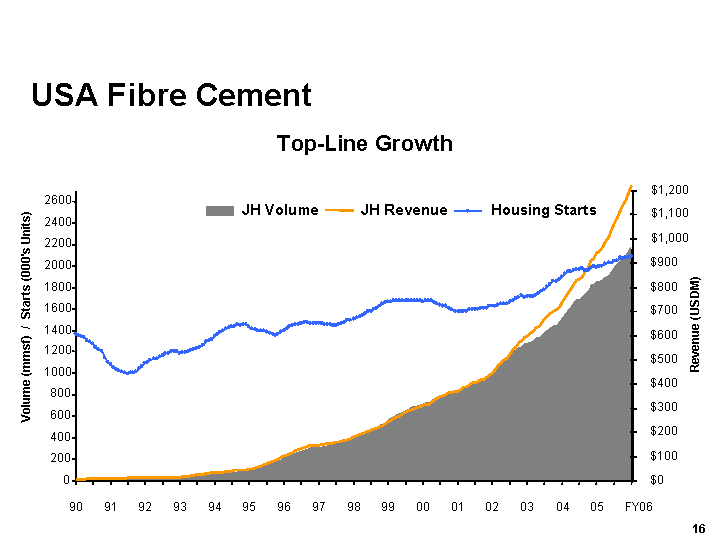
| USA Fibre Cement Top-Line Growth 0 200 400 600 800 1000 1200 1400 1600 1800 2000 2200 2400 2600 90 91 92 93 94 95 96 97 98 99 00 01 02 03 04 05 FY06 Volume (mmsf) / Starts (000's Units) $0 $100 $200 $300 $400 $500 $600 $700 $800 $900 $1,000 $1,100 $1,200 Revenue (USDM) JH Volume JH Revenue Housing Starts |
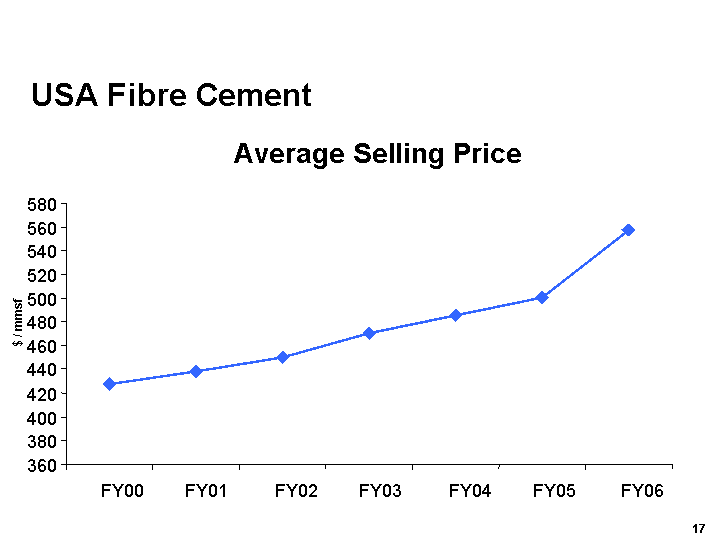
| USA Fibre Cement Average Selling Price 360 380 400 420 440 460 480 500 520 540 560 580 FY00 FY01 FY02 FY03 FY04 FY05 FY06 $ / mmsf |
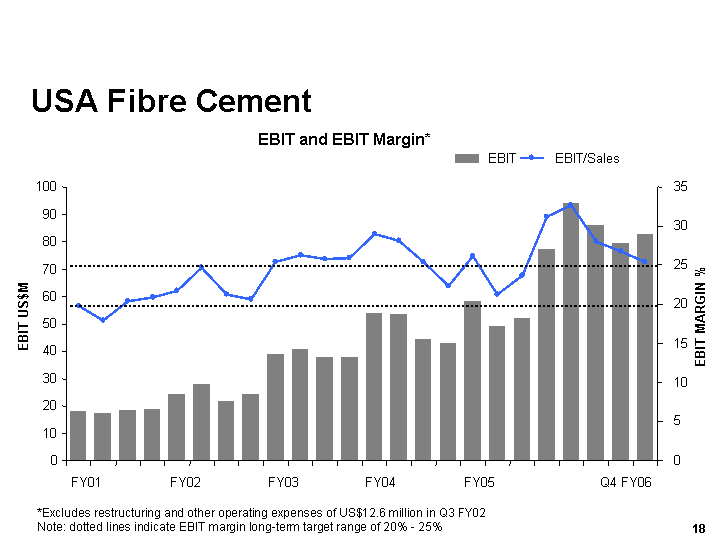
| USA Fibre Cement *Excludes restructuring and other operating expenses of US$12.6 million in Q3 FY02 Note: dotted lines indicate EBIT margin long-term target range of 20% - 25% EBIT and EBIT Margin* 0 10 20 30 40 50 60 70 80 90 100 FY01 FY02 FY03 FY04 FY05 Q4 FY06 EBIT US$M 0 5 10 15 20 25 30 35 EBIT MARGIN % EBIT EBIT/Sales |
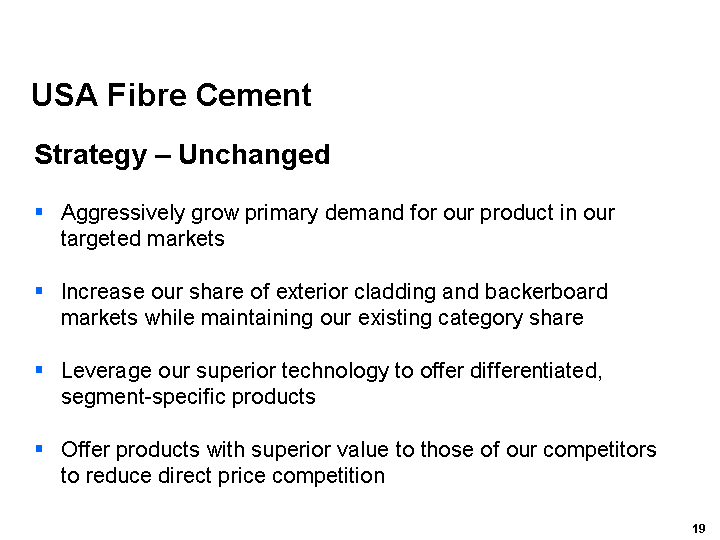
| USA Fibre Cement Strategy - Unchanged Aggressively grow primary demand for our product in our targeted markets Increase our share of exterior cladding and backerboard markets while maintaining our existing category share Leverage our superior technology to offer differentiated, segment-specific products Offer products with superior value to those of our competitors to reduce direct price competition |
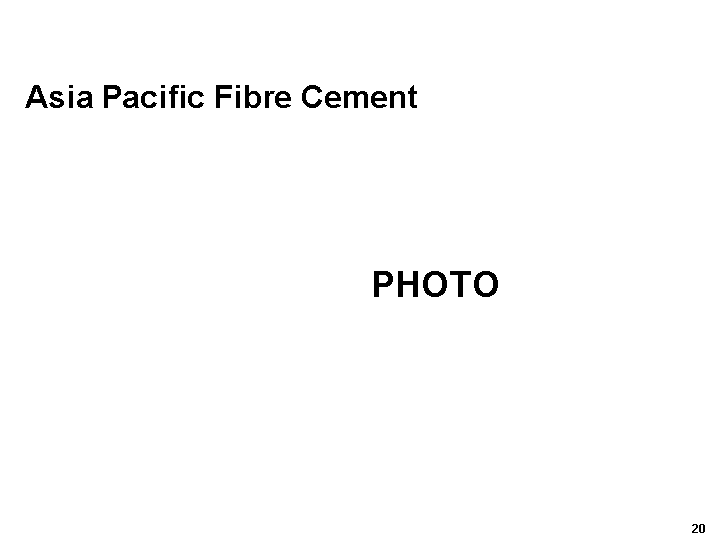
| Asia Pacific Fibre Cement PHOTO |
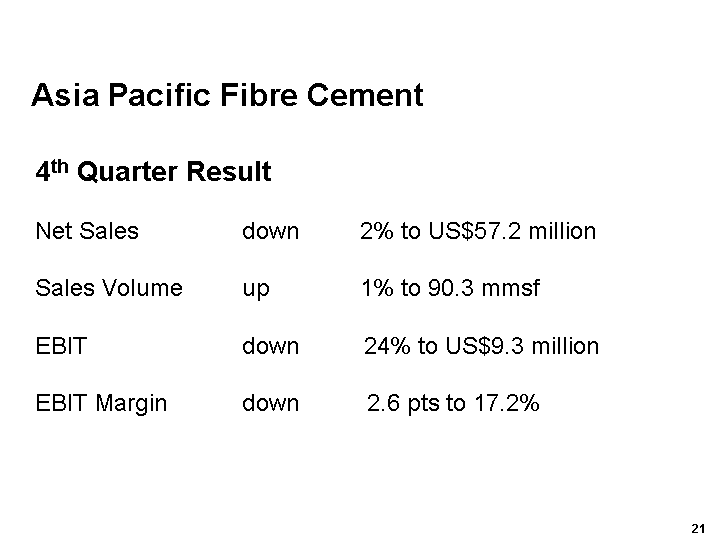
| Asia Pacific Fibre Cement 4th Quarter Result Net Sales down 2% to US$57.2 million Sales Volume up 1% to 90.3 mmsf EBIT down 24% to US$9.3 million EBIT Margin down 2.6 pts to 17.2% |
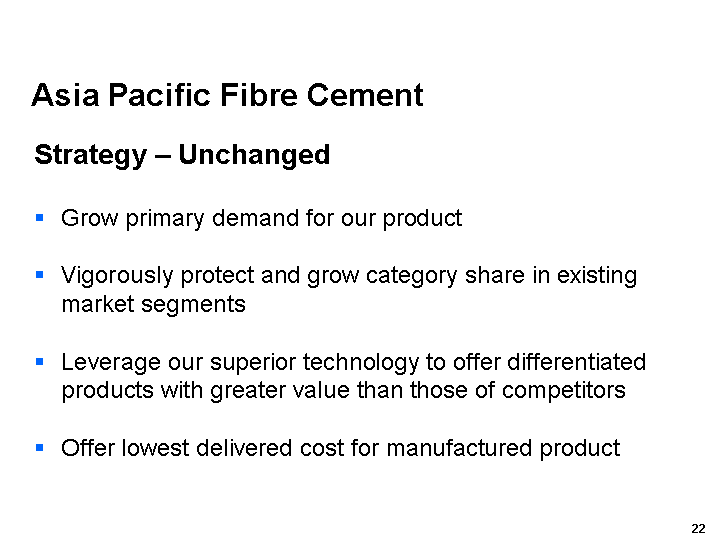
| Strategy - Unchanged Grow primary demand for our product Vigorously protect and grow category share in existing market segments Leverage our superior technology to offer differentiated products with greater value than those of competitors Offer lowest delivered cost for manufactured product Asia Pacific Fibre Cement |
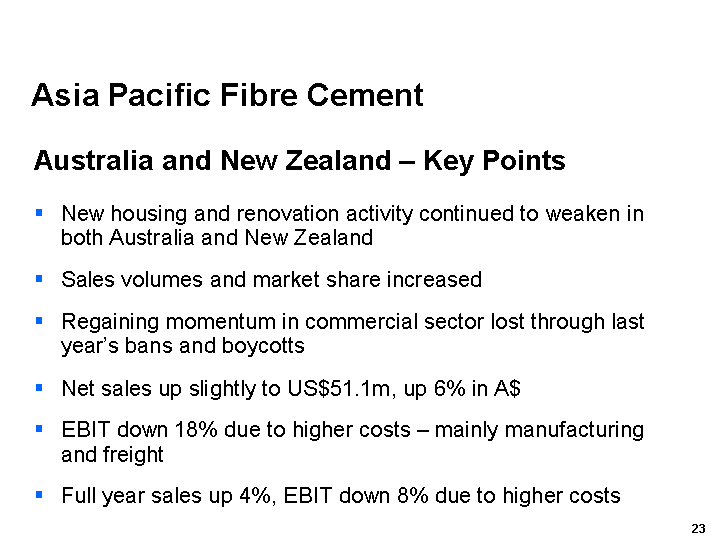
| Asia Pacific Fibre Cement Australia and New Zealand - Key Points New housing and renovation activity continued to weaken in both Australia and New Zealand Sales volumes and market share increased Regaining momentum in commercial sector lost through last year's bans and boycotts Net sales up slightly to US$51.1m, up 6% in A$ EBIT down 18% due to higher costs - mainly manufacturing and freight Full year sales up 4%, EBIT down 8% due to higher costs |
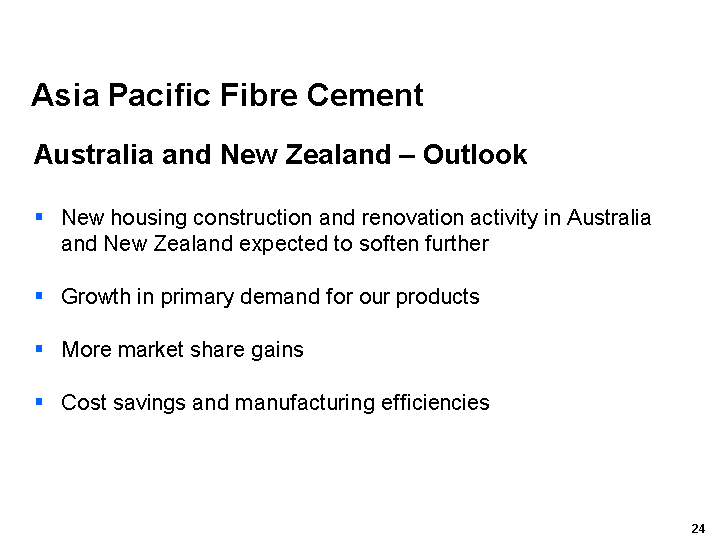
| Asia Pacific Fibre Cement Australia and New Zealand - Outlook New housing construction and renovation activity in Australia and New Zealand expected to soften further Growth in primary demand for our products More market share gains Cost savings and manufacturing efficiencies |
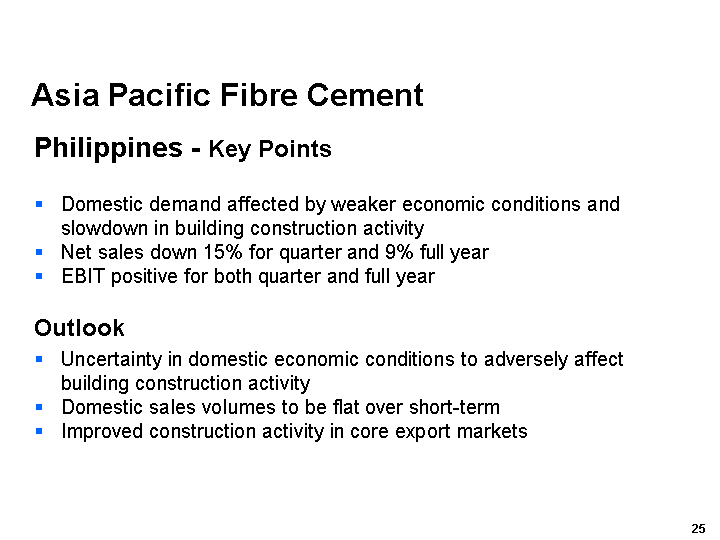
| Asia Pacific Fibre Cement Philippines - Key Points Domestic demand affected by weaker economic conditions and slowdown in building construction activity Net sales down 15% for quarter and 9% full year EBIT positive for both quarter and full year Outlook Uncertainty in domestic economic conditions to adversely affect building construction activity Domestic sales volumes to be flat over short-term Improved construction activity in core export markets |

| Other USA Hardie Pipe - Key Points Both residential and non-residential construction activity remained buoyant in Florida Q4 sales strongest in FY06, but below Q4 FY05 Market share gains Manufacturing performance improvements Reduced EBIT loss for quarter and full year |
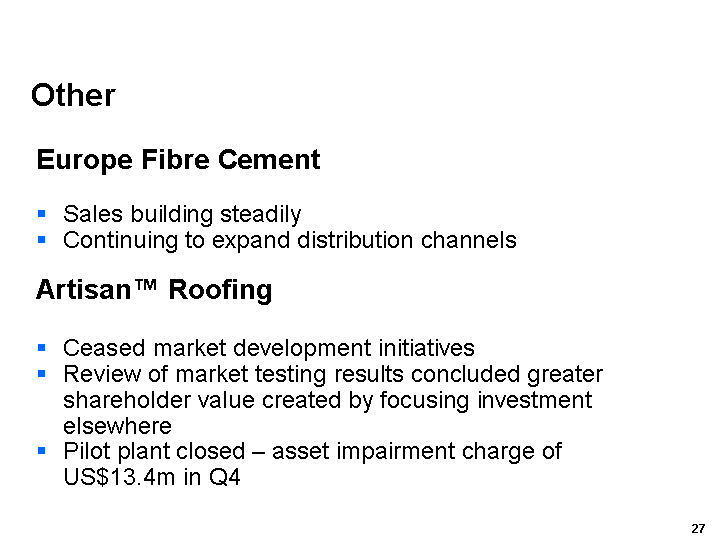
| Other Europe Fibre Cement Sales building steadily Continuing to expand distribution channels Artisan(tm) Roofing Ceased market development initiatives Review of market testing results concluded greater shareholder value created by focusing investment elsewhere Pilot plant closed - asset impairment charge of US$13.4m in Q4 |
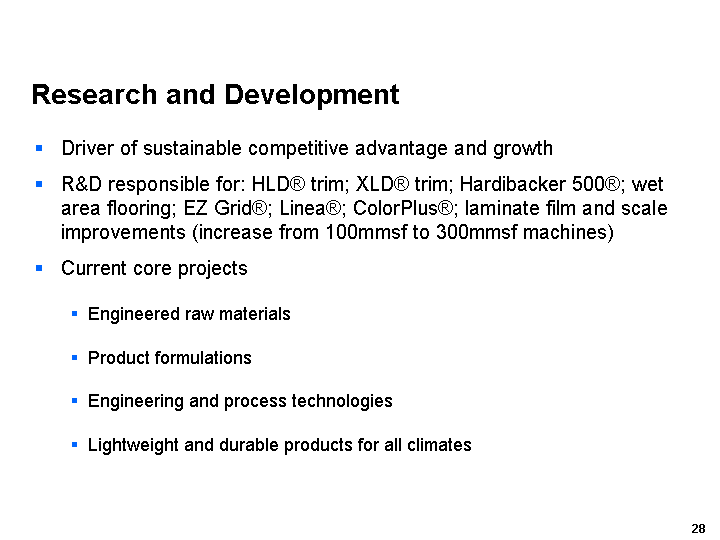
| Research and Development Driver of sustainable competitive advantage and growth R&D responsible for: HLD(r) trim; XLD(r) trim; Hardibacker 500(r); wet area flooring; EZ Grid(r); Linea(r); ColorPlus(r); laminate film and scale improvements (increase from 100mmsf to 300mmsf machines) Current core projects Engineered raw materials Product formulations Engineering and process technologies Lightweight and durable products for all climates |
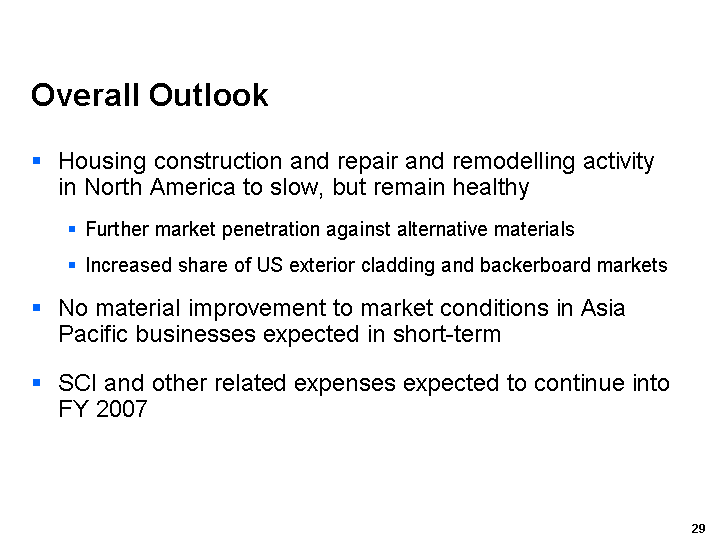
| Overall Outlook Housing construction and repair and remodelling activity in North America to slow, but remain healthy Further market penetration against alternative materials Increased share of US exterior cladding and backerboard markets No material improvement to market conditions in Asia Pacific businesses expected in short-term SCI and other related expenses expected to continue into FY 2007 |
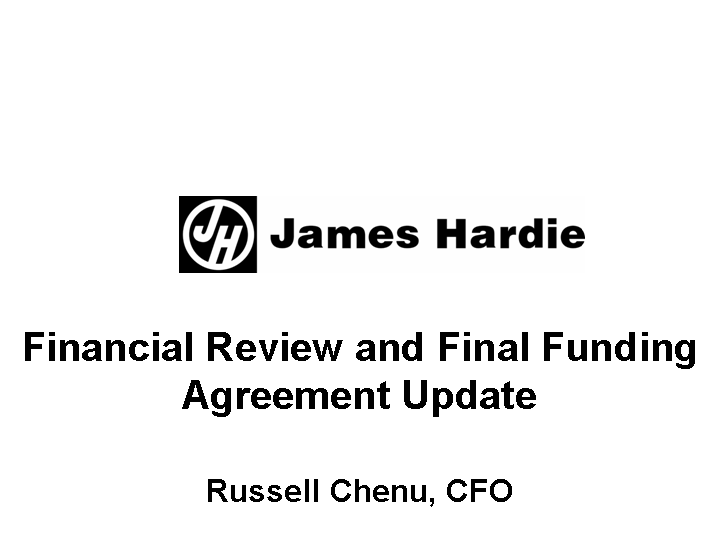
| Financial Review and Final Funding Agreement Update Russell Chenu, CFO |
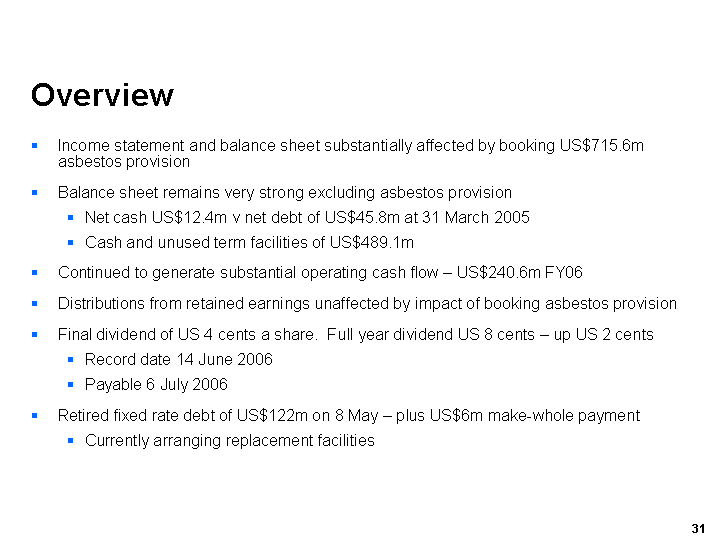
| Overview Income statement and balance sheet substantially affected by booking US$715.6m asbestos provision Balance sheet remains very strong excluding asbestos provision Net cash US$12.4m v net debt of US$45.8m at 31 March 2005 Cash and unused term facilities of US$489.1m Continued to generate substantial operating cash flow - US$240.6m FY06 Distributions from retained earnings unaffected by impact of booking asbestos provision Final dividend of US 4 cents a share. Full year dividend US 8 cents - up US 2 cents Record date 14 June 2006 Payable 6 July 2006 Retired fixed rate debt of US$122m on 8 May - plus US$6m make-whole payment Currently arranging replacement facilities |
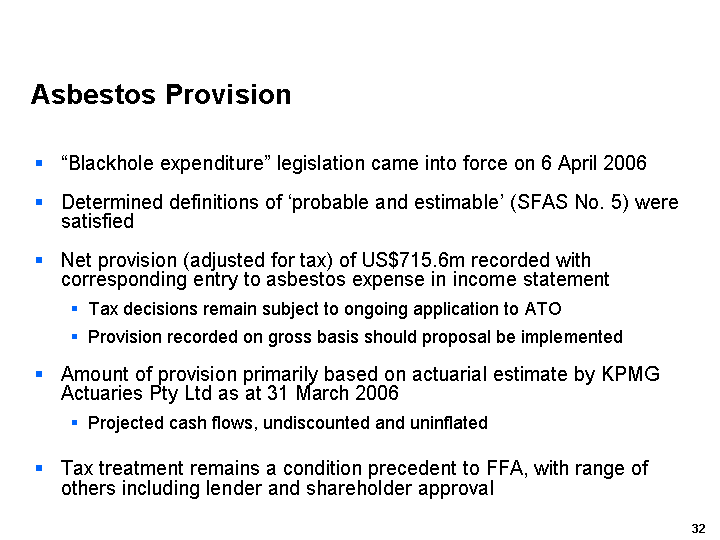
| Asbestos Provision "Blackhole expenditure" legislation came into force on 6 April 2006 Determined definitions of 'probable and estimable' (SFAS No. 5) were satisfied Net provision (adjusted for tax) of US$715.6m recorded with corresponding entry to asbestos expense in income statement Tax decisions remain subject to ongoing application to ATO Provision recorded on gross basis should proposal be implemented Amount of provision primarily based on actuarial estimate by KPMG Actuaries Pty Ltd as at 31 March 2006 Projected cash flows, undiscounted and uninflated Tax treatment remains a condition precedent to FFA, with range of others including lender and shareholder approval |
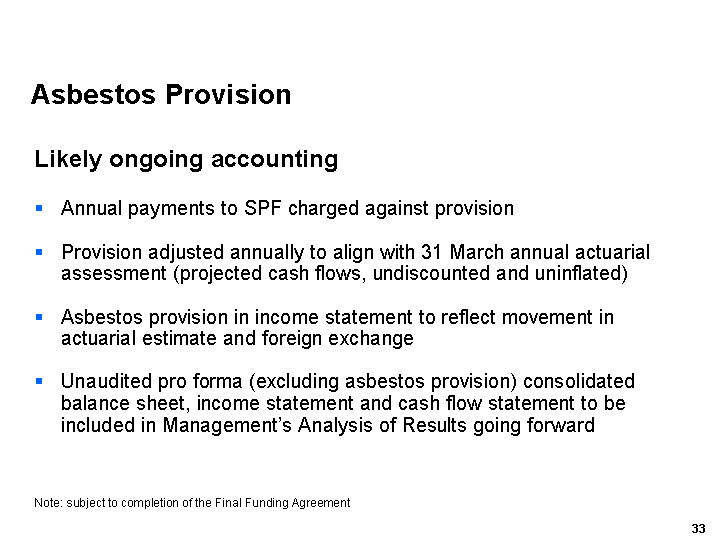
| Asbestos Provision Likely ongoing accounting Annual payments to SPF charged against provision Provision adjusted annually to align with 31 March annual actuarial assessment (projected cash flows, undiscounted and uninflated) Asbestos provision in income statement to reflect movement in actuarial estimate and foreign exchange Unaudited pro forma (excluding asbestos provision) consolidated balance sheet, income statement and cash flow statement to be included in Management's Analysis of Results going forward Note: subject to completion of the Final Funding Agreement |
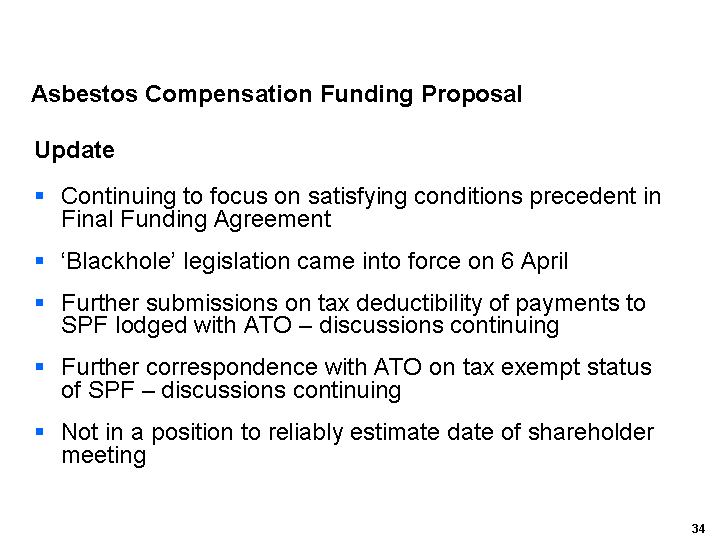
| Asbestos Compensation Funding Proposal Update Continuing to focus on satisfying conditions precedent in Final Funding Agreement 'Blackhole' legislation came into force on 6 April Further submissions on tax deductibility of payments to SPF lodged with ATO - discussions continuing Further correspondence with ATO on tax exempt status of SPF - discussions continuing Not in a position to reliably estimate date of shareholder meeting |
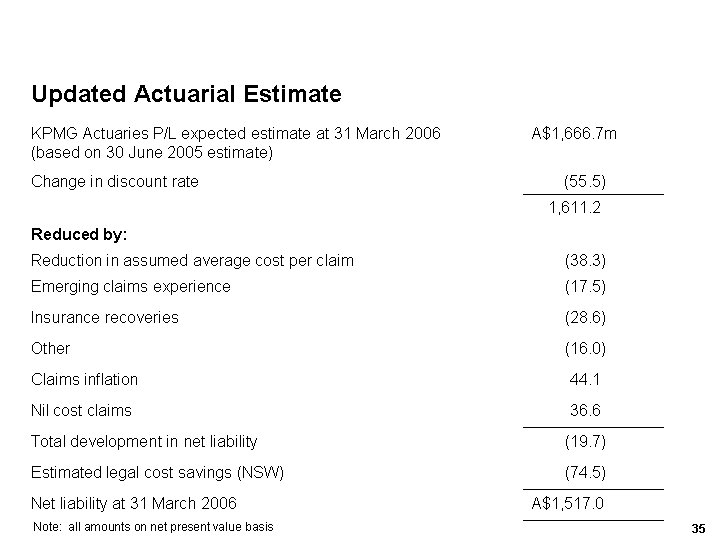
| Updated Actuarial Estimate KPMG Actuaries P/L expected estimate at 31 March 2006 (based on 30 June 2005 estimate) A$1,666.7m Change in discount rate (55.5) 1,611.2 Reduced by: Reduction in assumed average cost per claim (38.3) Emerging claims experience (17.5) Insurance recoveries (28.6) Other (16.0) Claims inflation 44.1 Nil cost claims 36.6 Total development in net liability (19.7) Estimated legal cost savings (NSW) (74.5) Net liability at 31 March 2006 A$1,517.0 Note: all amounts on net present value basis |
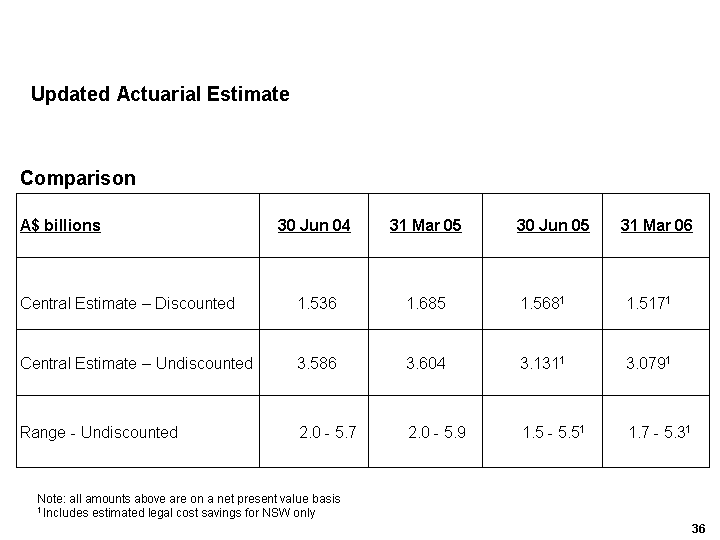
| Updated Actuarial Estimate Comparison Comparison A$ billions 30 Jun 04 31 Mar 05 30 Jun 05 31 Mar 06 Central Estimate - Discounted 1.536 1.685 1.5681 1.5171 Central Estimate - Undiscounted 3.586 3.604 3.1311 3.0791 Range - Undiscounted 2.0 - 5.7 2.0 - 5.9 1.5 - 5.51 1.7 - 5.31 Note: all amounts above are on a net present value basis 1 Includes estimated legal cost savings for NSW only |
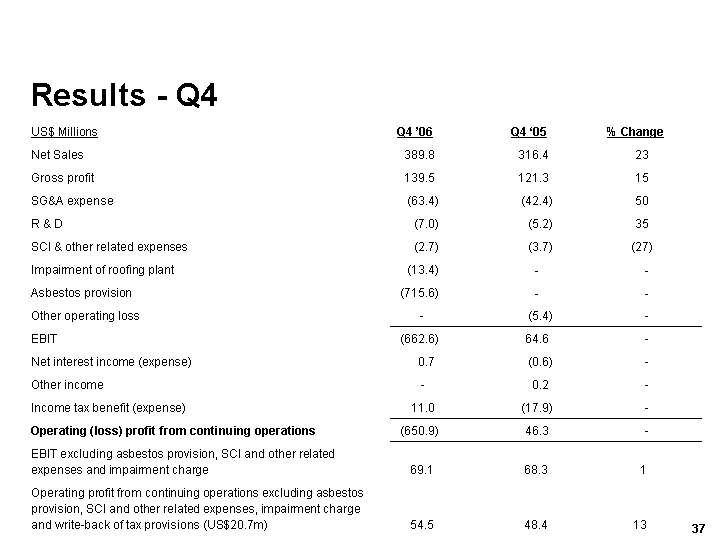
| Results - Q4 US$ Millions Q4 '06 Q4 '05 % Change Net Sales 389.8 316.4 23 Gross profit 139.5 121.3 15 SG&A expense (63.4) (42.4) 50 R & D (7.0) (5.2) 35 SCI & other related expenses (2.7) (3.7) (27) Impairment of roofing plant (13.4) - - Asbestos provision (715.6) - - Other operating loss - (5.4) - EBIT (662.6) 64.6 - Net interest income (expense) 0.7 (0.6) - Other income - 0.2 - Income tax benefit (expense) 11.0 (17.9) - Operating (loss) profit from continuing operations (650.9) 46.3 - EBIT excluding asbestos provision, SCI and other related expenses and impairment charge 69.1 68.3 1 Operating profit from continuing operations excluding asbestos provision, SCI and other related expenses, impairment charge and write-back of tax provisions (US$20.7m) 54.5 48.4 13 |
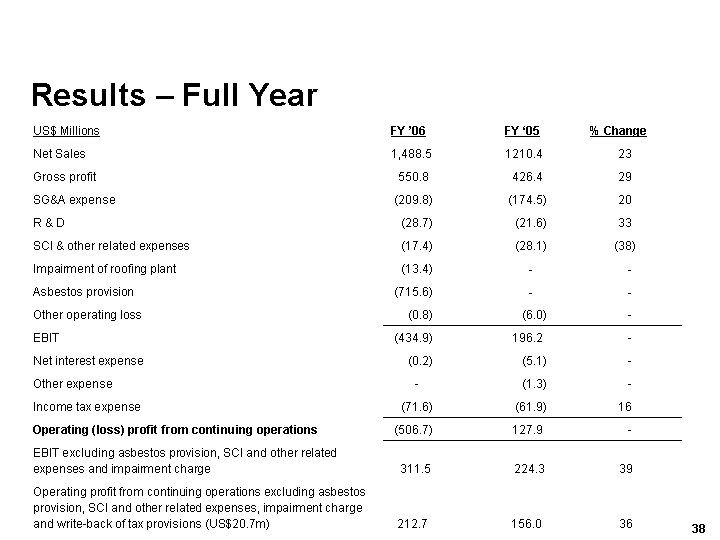
| Results - Full Year US$ Millions FY '06 FY '05 % Change Net Sales 1,488.5 1210.4 23 Gross profit 550.8 426.4 29 SG&A expense (209.8) (174.5) 20 R & D (28.7) (21.6) 33 SCI & other related expenses (17.4) (28.1) (38) Impairment of roofing plant (13.4) - - Asbestos provision (715.6) - - Other operating loss (0.8) (6.0) - EBIT (434.9) 196.2 - Net interest expense (0.2) (5.1) - Other expense - (1.3) - Income tax expense (71.6) (61.9) 16 Operating (loss) profit from continuing operations (506.7) 127.9 - EBIT excluding asbestos provision, SCI and other related expenses and impairment charge 311.5 224.3 39 Operating profit from continuing operations excluding asbestos provision, SCI and other related expenses, impairment charge and write-back of tax provisions (US$20.7m) 212.7 156.0 36 |
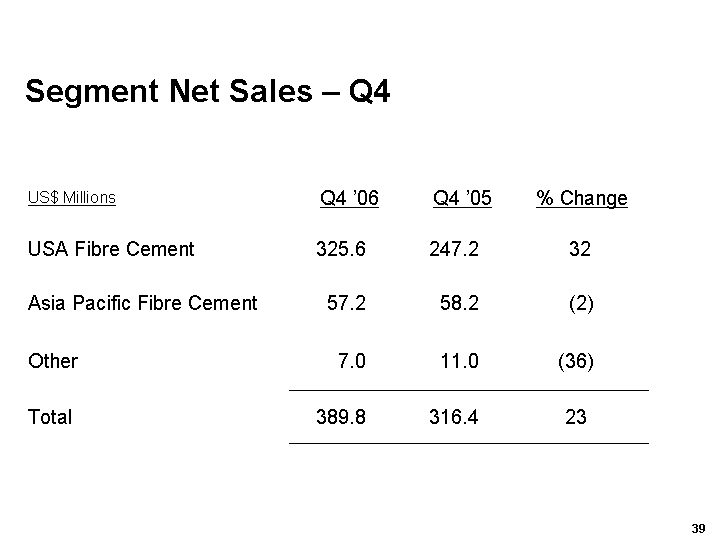
| Segment Net Sales - Q4 US$ Millions Q4 '06 Q4 '05 % Change USA Fibre Cement 325.6 247.2 32 Asia Pacific Fibre Cement 57.2 58.2 (2) Other 7.0 11.0 (36) Total 389.8 316.4 23 |
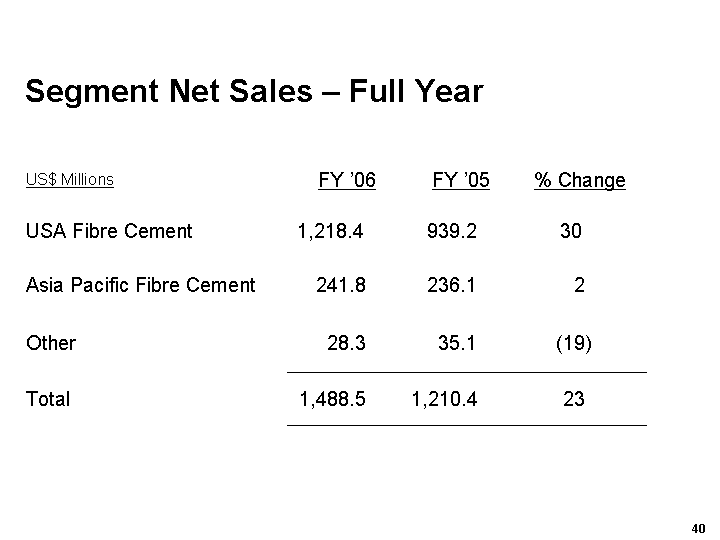
| Segment Net Sales - Full Year US$ Millions FY '06 FY '05 % Change USA Fibre Cement 1,218.4 939.2 30 Asia Pacific Fibre Cement 241.8 236.1 2 Other 28.3 35.1 (19) Total 1,488.5 1,210.4 23 |
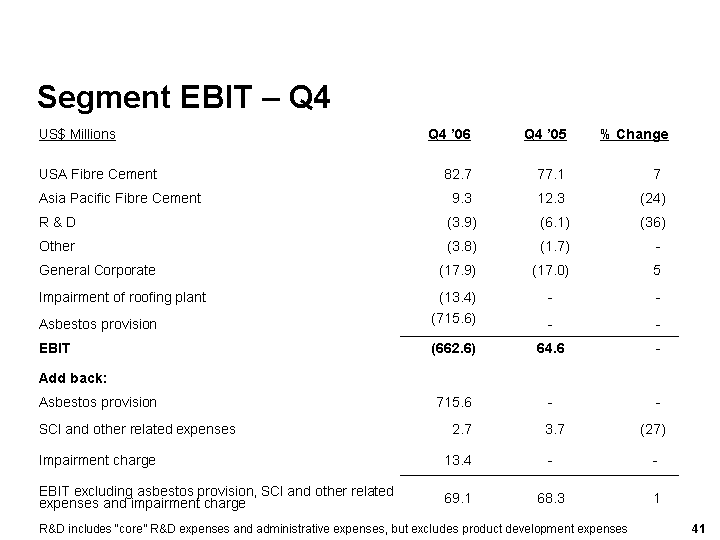
| Segment EBIT - Q4 US$ Millions Q4 '06 Q4 '05 % Change USA Fibre Cement 82.7 77.1 7 Asia Pacific Fibre Cement 9.3 12.3 (24) R & D (3.9) (6.1) (36) Other (3.8) (1.7) - General Corporate (17.9) (17.0) 5 Impairment of roofing plant (13.4) - - Asbestos provision (715.6) - - EBIT (662.6) 64.6 - Add back: Asbestos provision 715.6 - - SCI and other related expenses 2.7 3.7 (27) Impairment charge 13.4 - - EBIT excluding asbestos provision, SCI and other related expenses and impairment charge 69.1 68.3 1 R&D includes "core" R&D expenses and administrative expenses, but excludes product development expenses |
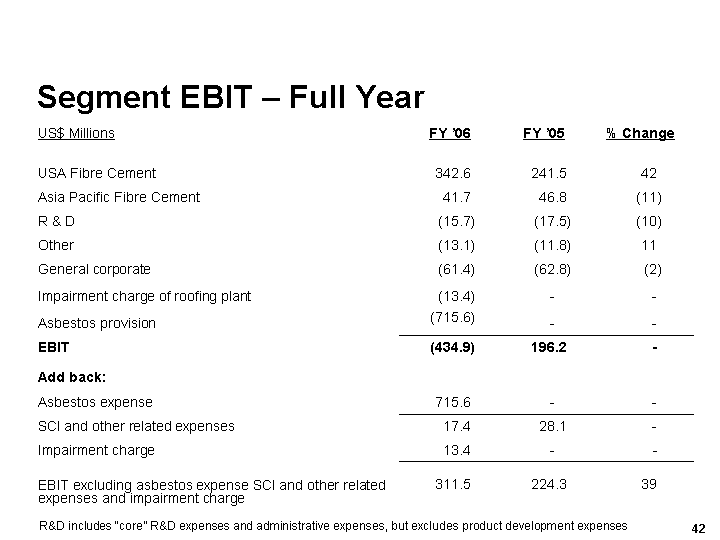
| Segment EBIT - Full Year R&D includes "core" R&D expenses and administrative expenses, but excludes product development expenses US$ Millions FY '06 FY '05 % Change USA Fibre Cement 342.6 241.5 42 Asia Pacific Fibre Cement 41.7 46.8 (11) R & D (15.7) (17.5) (10) Other (13.1) (11.8) 11 General corporate (61.4) (62.8) (2) Impairment charge of roofing plant (13.4) - - Asbestos provision (715.6) - - EBIT (434.9) 196.2 - Add back: Asbestos expense 715.6 - - SCI and other related expenses 17.4 28.1 - Impairment charge 13.4 - - EBIT excluding asbestos expense SCI and other related expenses and impairment charge 311.5 224.3 39 |
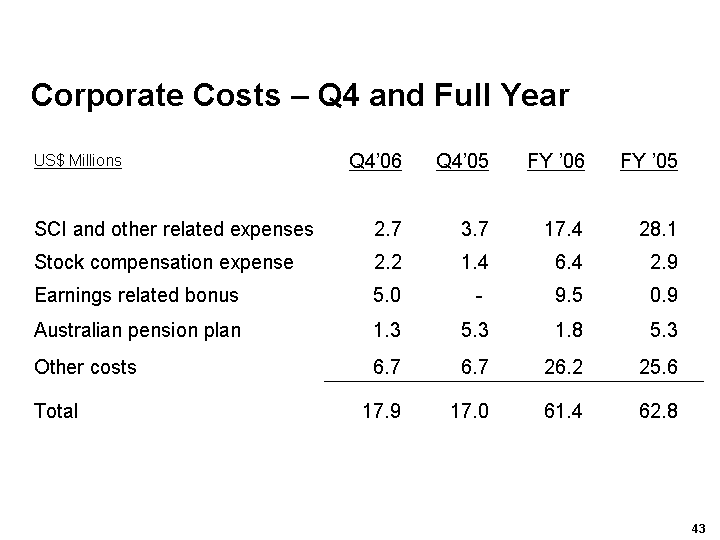
| Corporate Costs - Q4 and Full Year US$ Millions Q4'06 Q4'05 FY '06 FY '05 SCI and other related expenses 2.7 3.7 17.4 28.1 Stock compensation expense 2.2 1.4 6.4 2.9 Earnings related bonus 5.0 - 9.5 0.9 Australian pension plan 1.3 5.3 1.8 5.3 Other costs 6.7 6.7 26.2 25.6 Total 17.9 17.0 61.4 62.8 |
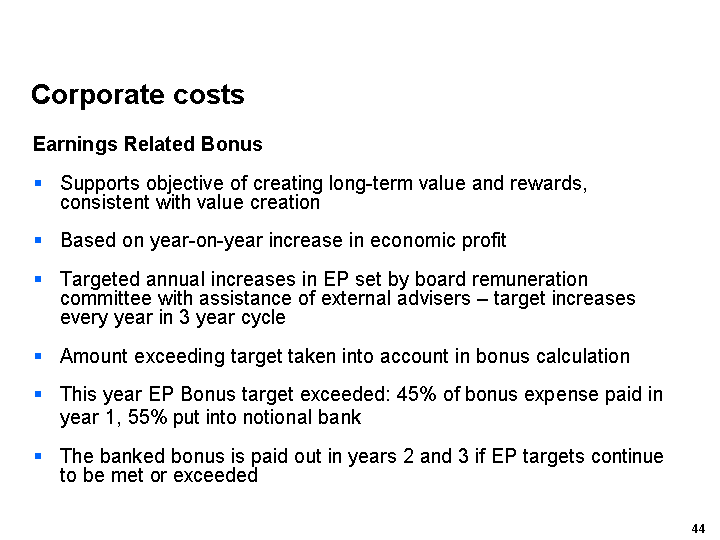
| Corporate costs Earnings Related Bonus Supports objective of creating long-term value and rewards, consistent with value creation Based on year-on-year increase in economic profit Targeted annual increases in EP set by board remuneration committee with assistance of external advisers - target increases every year in 3 year cycle Amount exceeding target taken into account in bonus calculation This year EP Bonus target exceeded: 45% of bonus expense paid in year 1, 55% put into notional bank The banked bonus is paid out in years 2 and 3 if EP targets continue to be met or exceeded |
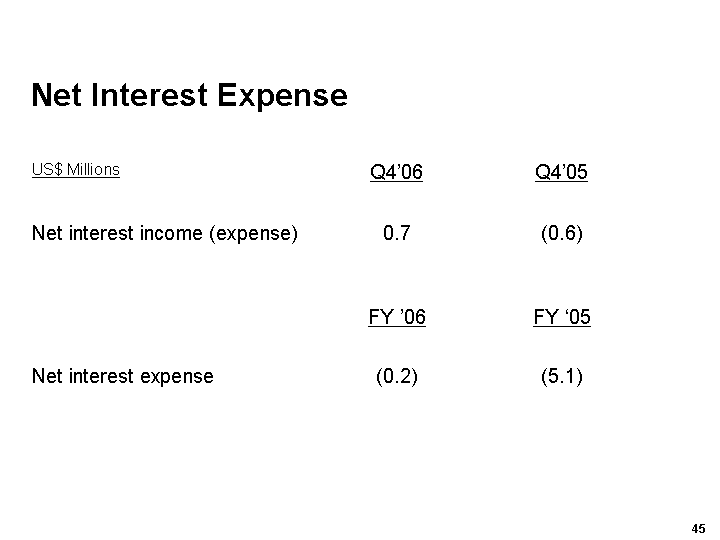
| Net Interest Expense US$ Millions Q4'06 Q4'05 Net interest income (expense) 0.7 (0.6) FY '06 FY '05 Net interest expense (0.2) (5.1) |
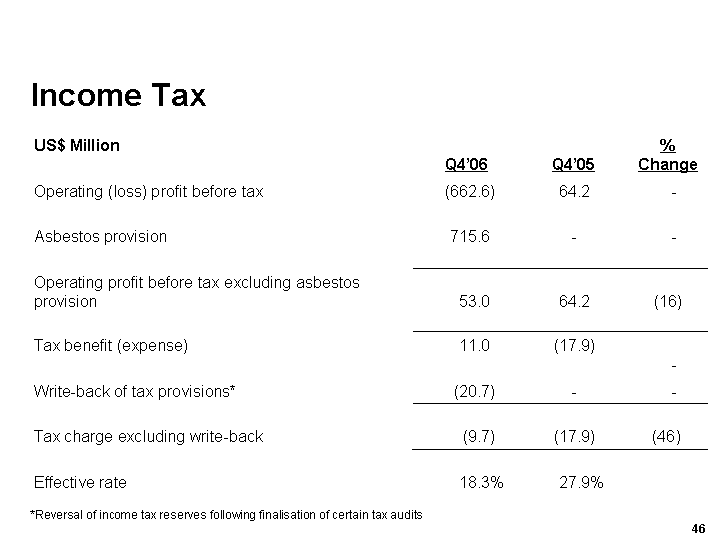
| Income Tax US$ Million Q4'06 Q4'05 % Change Operating (loss) profit before tax (662.6) 64.2 - Asbestos provision 715.6 - - Operating profit before tax excluding asbestos provision 53.0 64.2 (16) Tax benefit (expense) 11.0 (17.9) - Write-back of tax provisions* (20.7) - - Tax charge excluding write-back (9.7) (17.9) (46) Effective rate 18.3% 27.9% *Reversal of income tax reserves following finalisation of certain tax audits |
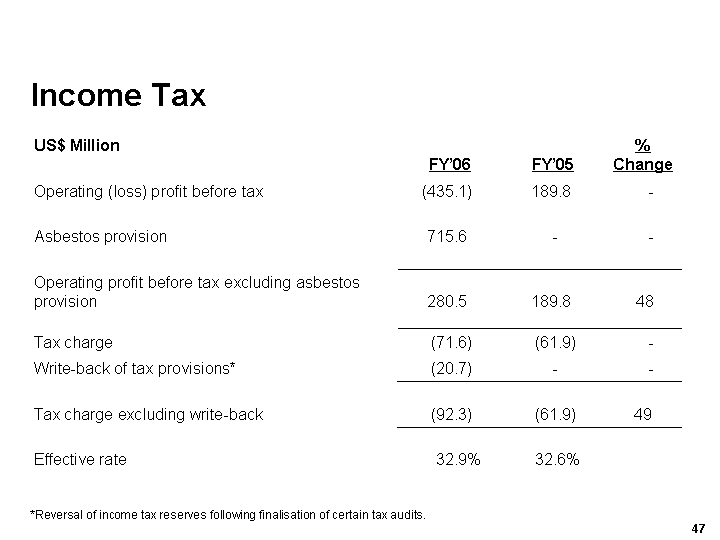
| Income Tax US$ Million FY'06 FY'05 % Change Operating (loss) profit before tax (435.1) 189.8 - Asbestos provision 715.6 - - Operating profit before tax excluding asbestos provision 280.5 189.8 48 Tax charge (71.6) (61.9) - Write-back of tax provisions* (20.7) - - Tax charge excluding write-back (92.3) (61.9) 49 Effective rate 32.9% 32.6% *Reversal of income tax reserves following finalisation of certain tax audits. |
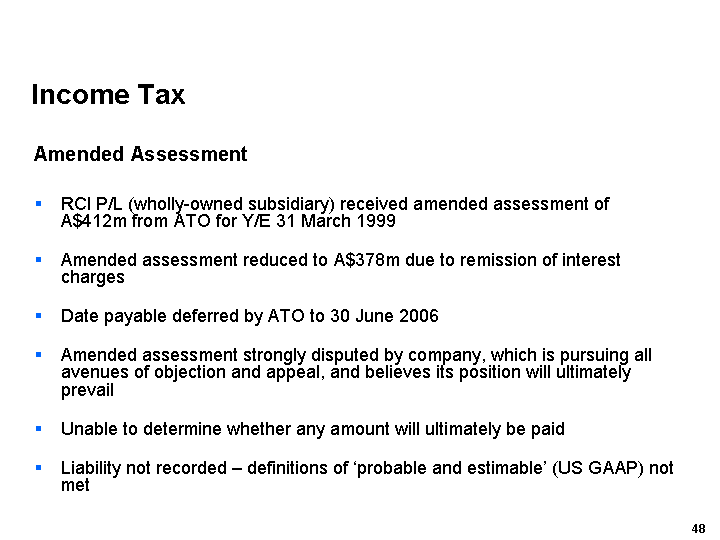
| Income Tax Amended Assessment RCI P/L (wholly-owned subsidiary) received amended assessment of A$412m from ATO for Y/E 31 March 1999 Amended assessment reduced to A$378m due to remission of interest charges Date payable deferred by ATO to 30 June 2006 Amended assessment strongly disputed by company, which is pursuing all avenues of objection and appeal, and believes its position will ultimately prevail Unable to determine whether any amount will ultimately be paid Liability not recorded - definitions of 'probable and estimable' (US GAAP) not met |
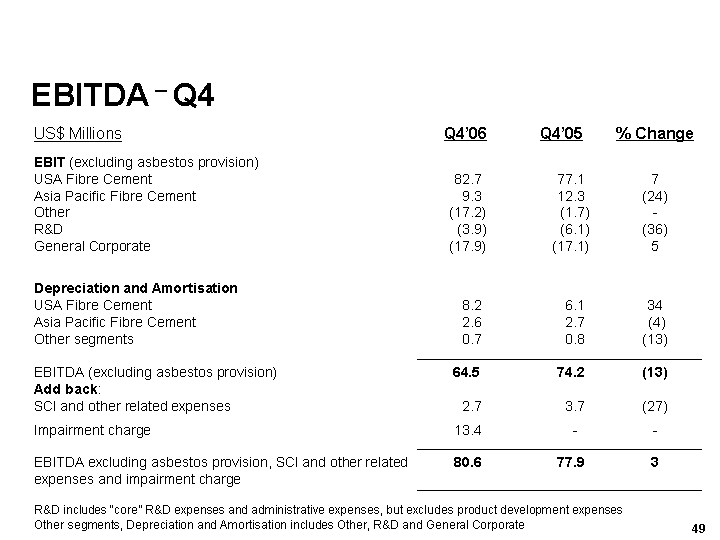
| EBITDA - Q4 US$ Millions Q4'06 Q4'05 % Change EBIT (excluding asbestos provision) USA Fibre Cement Asia Pacific Fibre Cement Other R&D General Corporate 82.7 9.3 (17.2) (3.9) (17.9) 77.1 12.3 (1.7) (6.1) (17.1) 7 (24) - - (36) 5 Depreciation and Amortisation USA Fibre Cement Asia Pacific Fibre Cement Other segments 8.2 2.6 0.7 6.1 2.7 0.8 34 (4) (13) EBITDA (excluding asbestos provision) Add back: SCI and other related expenses 64.5 2.7 74.2 3.7 (13) (27) Impairment charge 13.4 - - EBITDA excluding asbestos provision, SCI and other related expenses and impairment charge 80.6 77.9 3 R&D includes "core" R&D expenses and administrative expenses, but excludes product development expenses Other segments, Depreciation and Amortisation includes Other, R&D and General Corporate |
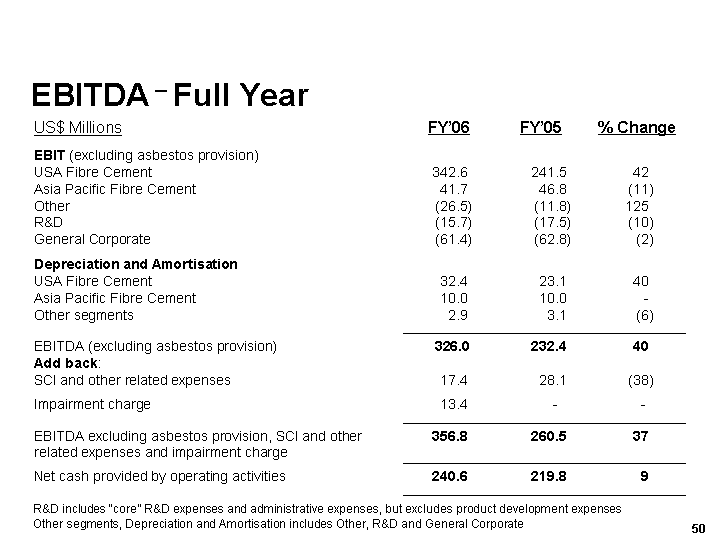
| EBITDA - Full Year R&D includes "core" R&D expenses and administrative expenses, but excludes product development expenses Other segments, Depreciation and Amortisation includes Other, R&D and General Corporate US$ Millions FY'06 FY'05 % Change EBIT (excluding asbestos provision) USA Fibre Cement Asia Pacific Fibre Cement Other R&D General Corporate 342.6 41.7 (26.5) (15.7) (61.4) 241.5 46.8 (11.8) (17.5) (62.8) 42 (11) 125 (10) (2) Depreciation and Amortisation USA Fibre Cement Asia Pacific Fibre Cement Other segments 32.4 10.0 2.9 23.1 10.0 3.1 40 - (6) EBITDA (excluding asbestos provision) Add back: SCI and other related expenses 326.0 17.4 232.4 28.1 40 (38) Impairment charge 13.4 - - EBITDA excluding asbestos provision, SCI and other related expenses and impairment charge 356.8 260.5 37 Net cash provided by operating activities 240.6 219.8 9 |
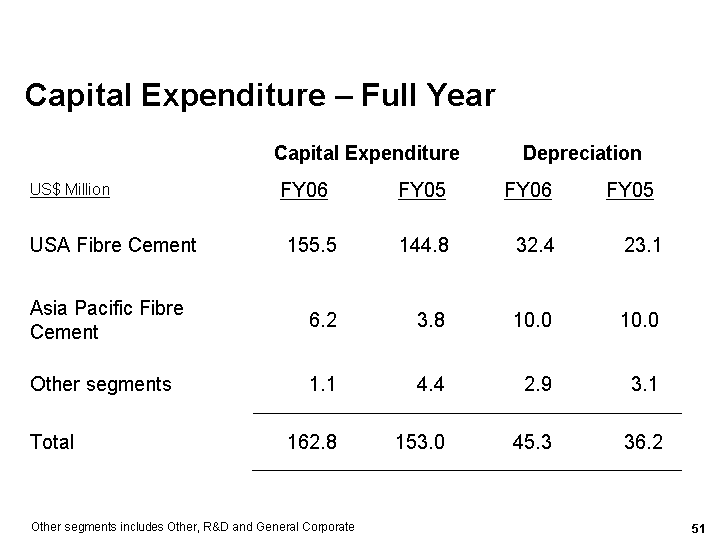
| Capital Expenditure - Full Year Capital Expenditure Capital Expenditure Depreciation Depreciation US$ Million FY06 FY05 FY06 FY05 USA Fibre Cement 155.5 144.8 32.4 23.1 Asia Pacific Fibre Cement 6.2 3.8 10.0 10.0 Other segments 1.1 4.4 2.9 3.1 Total 162.8 153.0 45.3 36.2 Other segments includes Other, R&D and General Corporate |
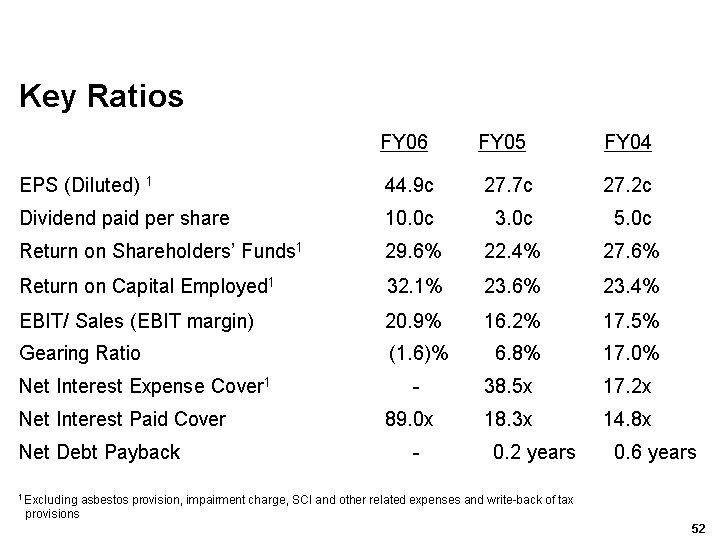
| Key Ratios FY06 FY05 FY04 EPS (Diluted) 1 44.9c 27.7c 27.2c Dividend paid per share 10.0c 3.0c 5.0c Return on Shareholders' Funds1 29.6% 22.4% 27.6% Return on Capital Employed1 32.1% 23.6% 23.4% EBIT/ Sales (EBIT margin) 20.9% 16.2% 17.5% Gearing Ratio (1.6)% 6.8% 17.0% Net Interest Expense Cover1 - 38.5x 17.2x Net Interest Paid Cover 89.0x 18.3x 14.8x Net Debt Payback - 0.2 years 0.6 years 1 Excluding asbestos provision, impairment charge, SCI and other related expenses and write-back of tax provisions |
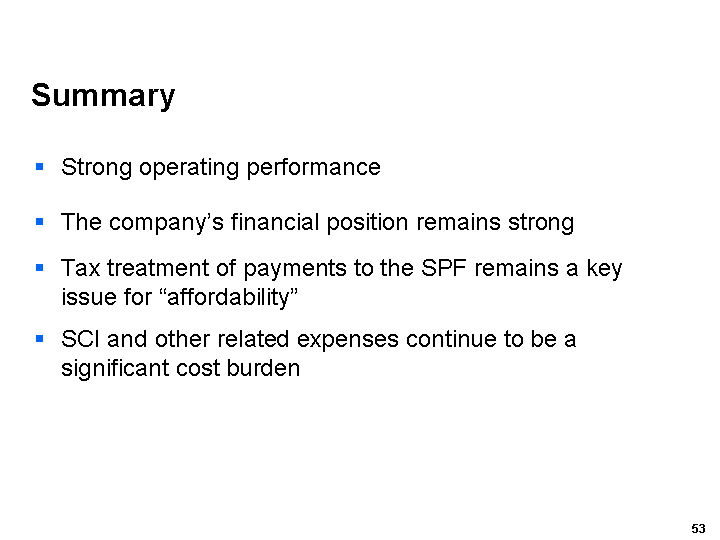
| Summary Strong operating performance The company's financial position remains strong Tax treatment of payments to the SPF remains a key issue for "affordability" SCI and other related expenses continue to be a significant cost burden |

| Questions & Answers |
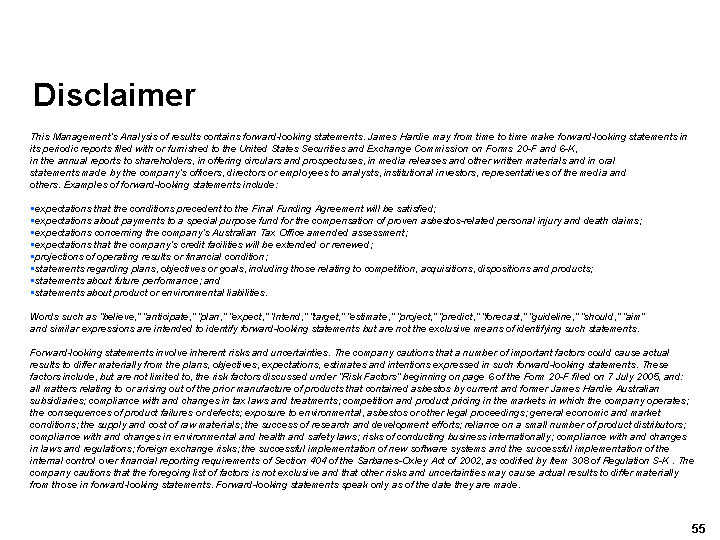
| Disclaimer This Management's Analysis of results contains forward-looking statements. James Hardie may from time to time make forward-looking statements in its periodic reports filed with or furnished to the United States Securities and Exchange Commission on Forms 20-F and 6-K, in the annual reports to shareholders, in offering circulars and prospectuses, in media releases and other written materials and in oral statements made by the company's officers, directors or employees to analysts, institutional investors, representatives of the media and others. Examples of forward-looking statements include: expectations that the conditions precedent to the Final Funding Agreement will be satisfied; expectations about payments to a special purpose fund for the compensation of proven asbestos-related personal injury and death claims; expectations concerning the company's Australian Tax Office amended assessment; expectations that the company's credit facilities will be extended or renewed; projections of operating results or financial condition; statements regarding plans, objectives or goals, including those relating to competition, acquisitions, dispositions and products; statements about future performance; and statements about product or environmental liabilities. Words such as "believe," "anticipate," "plan," "expect," "intend," "target," "estimate," "project," "predict," "forecast," "guideline," "should," "aim" and similar expressions are intended to identify forward-looking statements but are not the exclusive means of identifying such statements. Forward-looking statements involve inherent risks and uncertainties. The company cautions that a number of important factors could cause actual results to differ materially from the plans, objectives, expectations, estimates and intentions expressed in such forward-looking statements. These factors include, but are not limited to, the risk factors discussed under "Risk Factors" beginning on page 6 of the Form 20-F filed on 7 July 2005, and: all matters relating to or arising out of the prior manufacture of products that contained asbestos by current and former James Hardie Australian subsidiaries; compliance with and changes in tax laws and treatments; competition and product pricing in the markets in which the company operates; the consequences of product failures or defects; exposure to environmental, asbestos or other legal proceedings; general economic and market conditions; the supply and cost of raw materials; the success of research and development efforts; reliance on a small number of product distributors; compliance with and changes in environmental and health and safety laws; risks of conducting business internationally; compliance with and changes in laws and regulations; foreign exchange risks; the successful implementation of new software systems and the successful implementation of the internal control over financial reporting requirements of Section 404 of the Sarbanes-Oxley Act of 2002, as codified by Item 308 of Regulation S-K . The company cautions that the foregoing list of factors is not exclusive and that other risks and uncertainties may cause actual results to differ materially from those in forward-looking statements. Forward-looking statements speak only as of the date they are made. |

| Endnotes DEFINITIONS Financial Measures - US GAAP equivalents EBIT and EBIT margin - EBIT is equivalent to the US GAAP measure of operating income. EBIT margin is defined as EBIT as a percentage of net sales. James Hardie believes EBIT and EBIT margin to be relevant and useful information as these are the primary measures used by management to measure the operating profit or loss of its business. EBIT is one of several metrics used by management to measure the earnings generated by the company's operations, excluding interest and income tax expenses. Additionally, EBIT is believed to be a primary measure and terminology used by its Australian investors. EBIT and EBIT margin should be considered in addition to, but not as a substitute for, other measures of financial performance reported in accordance with accounting principles generally accepted in the United States of America. EBIT and EBIT margin, as the company has defined them, may not be comparable to similarly titled measures reported by other companies. Operating profit from continuing operations - is equivalent to the US GAAP measure of income from continuing operations. Net operating profit including discontinued operations - is equivalent to the US GAAP measure of net income. |
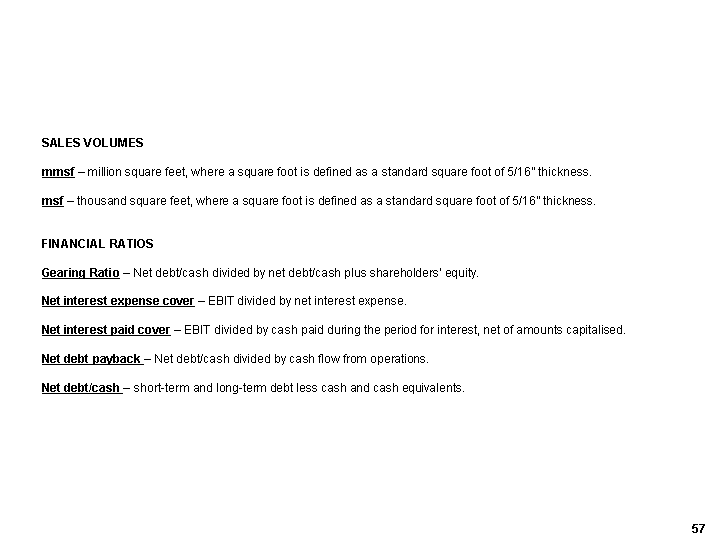
| SALES VOLUMES mmsf - million square feet, where a square foot is defined as a standard square foot of 5/16" thickness. msf - thousand square feet, where a square foot is defined as a standard square foot of 5/16" thickness. FINANCIAL RATIOS Gearing Ratio - Net debt/cash divided by net debt/cash plus shareholders' equity. Net interest expense cover - EBIT divided by net interest expense. Net interest paid cover - EBIT divided by cash paid during the period for interest, net of amounts capitalised. Net debt payback - Net debt/cash divided by cash flow from operations. Net debt/cash - short-term and long-term debt less cash and cash equivalents. |
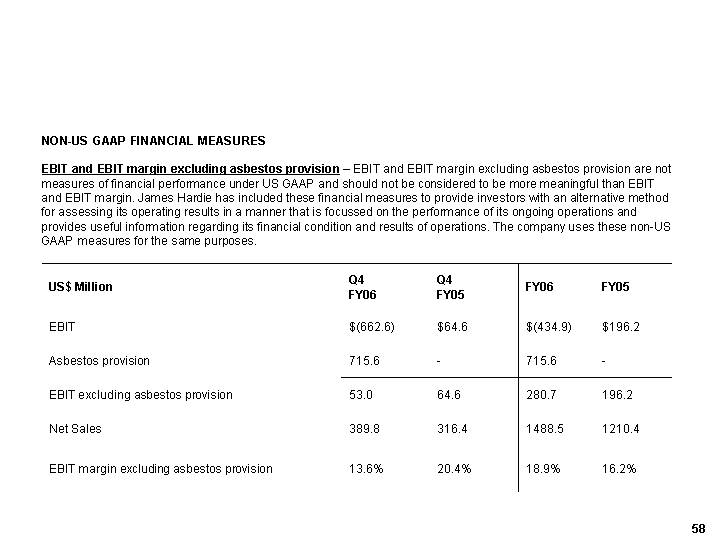
| NON-US GAAP FINANCIAL MEASURES EBIT and EBIT margin excluding asbestos provision - EBIT and EBIT margin excluding asbestos provision are not measures of financial performance under US GAAP and should not be considered to be more meaningful than EBIT and EBIT margin. James Hardie has included these financial measures to provide investors with an alternative method for assessing its operating results in a manner that is focussed on the performance of its ongoing operations and provides useful information regarding its financial condition and results of operations. The company uses these non-US GAAP measures for the same purposes. US$ Million Q4 FY06 Q4 FY05 FY06 FY05 EBIT $(662.6) $64.6 $(434.9) $196.2 Asbestos provision 715.6 - 715.6 - EBIT excluding asbestos provision 53.0 64.6 280.7 196.2 Net Sales 389.8 316.4 1488.5 1210.4 EBIT margin excluding asbestos provision 13.6% 20.4% 18.9% 16.2% |
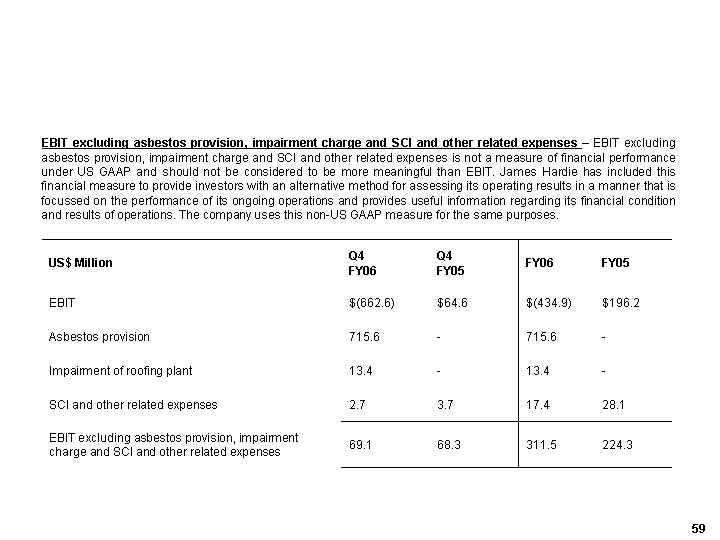
| EBIT excluding asbestos provision, impairment charge and SCI and other related expenses - EBIT excluding asbestos provision, impairment charge and SCI and other related expenses is not a measure of financial performance under US GAAP and should not be considered to be more meaningful than EBIT. James Hardie has included this financial measure to provide investors with an alternative method for assessing its operating results in a manner that is focussed on the performance of its ongoing operations and provides useful information regarding its financial condition and results of operations. The company uses this non-US GAAP measure for the same purposes. US$ Million Q4 FY06 Q4 FY05 FY06 FY05 EBIT $(662.6) $64.6 $(434.9) $196.2 Asbestos provision 715.6 - 715.6 - Impairment of roofing plant 13.4 - 13.4 - SCI and other related expenses 2.7 3.7 17.4 28.1 EBIT excluding asbestos provision, impairment charge and SCI and other related expenses 69.1 68.3 311.5 224.3 |

| Operating profit from continuing operations excluding asbestos provision - Operating profit from continuing operations excluding asbestos provision is not a measure of financial performance under US GAAP and should not be considered to be more meaningful than operating profit from continuing operations. The company has included this financial measure to provide investors with an alternative method for assessing its operating results in a manner that is focussed on the performance of its ongoing operations. The company uses this non-US GAAP measure for the same purposes. US$ Million Q4 FY06 Q4 FY05 FY06 FY05 Operating (loss) profit from continuing operations $(650.9) $46.3 $(506.7) $127.9 Asbestos provision 715.6 - 715.6 - Operating profit from continuing operations excluding asbestos provision 64.7 46.3 208.9 127.9 |
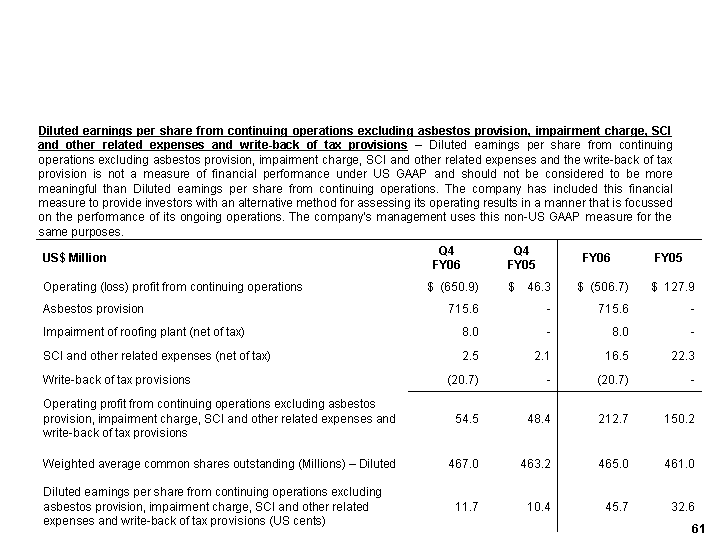
| Diluted earnings per share from continuing operations excluding asbestos provision, impairment charge, SCI and other related expenses and write-back of tax provisions - Diluted earnings per share from continuing operations excluding asbestos provision, impairment charge, SCI and other related expenses and the write-back of tax provision is not a measure of financial performance under US GAAP and should not be considered to be more meaningful than Diluted earnings per share from continuing operations. The company has included this financial measure to provide investors with an alternative method for assessing its operating results in a manner that is focussed on the performance of its ongoing operations. The company's management uses this non-US GAAP measure for the same purposes. US$ Million Q4 FY06 Q4 FY05 FY06 FY05 Operating (loss) profit from continuing operations $ (650.9) $ 46.3 $ (506.7) $ 127.9 Asbestos provision 715.6 - 715.6 - Impairment of roofing plant (net of tax) 8.0 - 8.0 - SCI and other related expenses (net of tax) 2.5 2.1 16.5 22.3 Write-back of tax provisions (20.7) - (20.7) - Operating profit from continuing operations excluding asbestos provision, impairment charge, SCI and other related expenses and write-back of tax provisions 54.5 48.4 212.7 150.2 Weighted average common shares outstanding (Millions) - Diluted 467.0 463.2 465.0 461.0 Diluted earnings per share from continuing operations excluding asbestos provision, impairment charge, SCI and other related expenses and write-back of tax provisions (US cents) 11.7 10.4 45.7 32.6 |

| EBITDA - is not a measure of financial performance under US GAAP and should not be considered an alternative to, or more meaningful than, income from operations, net income or cash flows as defined by US GAAP or as a measure of our profitability or liquidity. Not all companies calculate EBITDA in the same manner as James Hardie has and, accordingly, EBITDA may not be comparable with other companies. The company has included information concerning EBITDA because it believes that this data is commonly used by investors to evaluate the ability of a company's earnings from its core business operations to satisfy its debt, capital expenditure and working capital requirements. |
| Page | ||||
Item 1. Financial Statements |
||||
Report of Independent Registered Public Accounting Firm |
F-2 | |||
Consolidated Balance Sheets as of 31 March 2006 and 2005 |
F-3 | |||
Consolidated Statements of Operations for the Years ended 31 March 2006,
2005 and 2004 |
F-4 | |||
Consolidated Statements of Cash Flows for the Years ended 31 March
2006, 2005 and 2004 |
F-6 | |||
Consolidated Statements of Changes in Shareholders’ Equity for the Years
Ended 31 March 2006, 2005 and 2004 |
F-8 | |||
Notes to Consolidated Financial Statements |
F-10 | |||
Remuneration Disclosures (Unaudited) |
F-59 | |||
Selected Quarterly Financial Data (Unaudited) |
F-61 | |||
Group Statistics (Unaudited) |
F-62 | |||
Item 2. Quantitative and Qualitative Disclosures About Market Risk |
F-64 | |||
F-1
F-2
| (Millions of | (Millions of | |||||||||||||||||||
| US Dollars) | Australian Dollars) | |||||||||||||||||||
| 31 March | 31 March | 31 March | 31 March | |||||||||||||||||
| Notes | 2006 | 2005 | 2006 | 2005 | ||||||||||||||||
| (Unaudited) |
(Unaudited) |
|||||||||||||||||||
Assets |
||||||||||||||||||||
Current assets: |
||||||||||||||||||||
Cash and cash equivalents |
3 | $ | 315.1 | $ | 113.5 | A$ | 440.4 | A$ | 146.9 | |||||||||||
Accounts and notes receivable, net of allowance for
doubtful accounts of $1.3 million (A$1.8 million) and
$1.5 million (A$1.9 million) as of 31 March 2006
and 31 March 2005, respectively |
4 | 153.2 | 127.2 | 214.1 | 164.7 | |||||||||||||||
Inventories |
5 | 124.0 | 99.9 | 173.3 | 129.3 | |||||||||||||||
Prepaid expenses and other current assets |
33.8 | 12.0 | 47.2 | 15.5 | ||||||||||||||||
Deferred income taxes |
13 | 30.7 | 26.0 | 42.9 | 33.7 | |||||||||||||||
Total current assets |
656.8 | 378.6 | 917.9 | 490.1 | ||||||||||||||||
Property, plant and equipment, net |
6 | 775.6 | 685.7 | 1,083.9 | 887.7 | |||||||||||||||
Deferred income taxes |
13 | 4.8 | 12.3 | 6.7 | 15.9 | |||||||||||||||
Other assets |
8.2 | 12.3 | 11.5 | 15.9 | ||||||||||||||||
Total assets |
$ | 1,445.4 | $ | 1,088.9 | A$ | 2,020.0 | A$ | 1,409.6 | ||||||||||||
Liabilities and Shareholders’ Equity |
||||||||||||||||||||
Current liabilities: |
||||||||||||||||||||
Accounts payable and accrued liabilities |
8 | $ | 117.8 | $ | 94.0 | A$ | 164.6 | A$ | 121.7 | |||||||||||
Current portion of long-term debt |
9 | 121.7 | 25.7 | 170.1 | 33.3 | |||||||||||||||
Short-term debt |
9 | 181.0 | 11.9 | 252.9 | 15.4 | |||||||||||||||
Accrued payroll and employee benefits |
46.3 | 35.7 | 64.7 | 46.2 | ||||||||||||||||
Accrued product warranties |
11 | 11.4 | 8.0 | 15.9 | 10.4 | |||||||||||||||
Income taxes payable |
13 | 24.5 | 21.4 | 34.2 | 27.7 | |||||||||||||||
Other liabilities |
3.3 | 1.7 | 4.6 | 2.2 | ||||||||||||||||
Total current liabilities |
506.0 | 198.4 | 707.0 | 256.9 | ||||||||||||||||
Long-term debt |
9 | — | 121.7 | — | 157.6 | |||||||||||||||
Deferred income taxes |
13 | 79.8 | 77.5 | 111.5 | 100.3 | |||||||||||||||
Accrued product warranties |
11 | 4.1 | 4.9 | 5.7 | 6.3 | |||||||||||||||
Asbestos provision |
12 | 715.6 | — | 1,000.0 | — | |||||||||||||||
Other liabilities |
10 | 45.0 | 61.7 | 62.9 | 79.9 | |||||||||||||||
Total liabilities |
1,350.5 | 464.2 | A$ | 1,887.1 | A$ | 601.0 | ||||||||||||||
Commitments and contingencies (Note 12) |
||||||||||||||||||||
Shareholders’ equity: |
||||||||||||||||||||
Common stock, Euro 0.59 par value, 2.0 billion
shares authorised; 463,306,511 shares issued
and outstanding at 31 March 2006 and
459,373,176 shares issued and outstanding
at 31 March 2005 |
15 | 253.2 | 245.8 | |||||||||||||||||
Additional paid-in capital |
15 | 158.8 | 139.4 | |||||||||||||||||
Retained (deficit) earnings |
(288.3 | ) | 264.3 | |||||||||||||||||
Employee loans |
15 | (0.4 | ) | (0.7 | ) | |||||||||||||||
Accumulated other comprehensive loss |
18 | (28.4 | ) | (24.1 | ) | |||||||||||||||
Total shareholders’ equity |
94.9 | 624.7 | ||||||||||||||||||
Total liabilities and shareholders’ equity |
$ | 1,445.4 | $ | 1,088.9 | ||||||||||||||||
F-3
| Years ended 31 March | ||||||||||||||||
| (Millions of US dollars, except per share data) | Notes | 2006 | 2005 | 2004 | ||||||||||||
Net sales |
17 | $ | 1,488.5 | $ | 1,210.4 | $ | 981.9 | |||||||||
Cost of goods sold |
(937.7 | ) | (784.0 | ) | (623.0 | ) | ||||||||||
Gross profit |
550.8 | 426.4 | 358.9 | |||||||||||||
Selling, general and administrative expenses |
(209.8 | ) | (174.5 | ) | (162.0 | ) | ||||||||||
Research and development expenses |
(28.7 | ) | (21.6 | ) | (22.6 | ) | ||||||||||
SCI and other related expenses |
12 | (17.4 | ) | (28.1 | ) | — | ||||||||||
Impairment of roofing plant |
6 | (13.4 | ) | — | — | |||||||||||
Asbestos provision |
12 | (715.6 | ) | — | — | |||||||||||
Other operating expense |
(0.8 | ) | (6.0 | ) | (2.1 | ) | ||||||||||
Operating (loss) income |
(434.9 | ) | 196.2 | 172.2 | ||||||||||||
Interest expense |
(7.2 | ) | (7.3 | ) | (11.2 | ) | ||||||||||
Interest income |
7.0 | 2.2 | 1.2 | |||||||||||||
Other (expense) income |
— | (1.3 | ) | 3.5 | ||||||||||||
(Loss) income from continuing operations
before income taxes |
17 | (435.1 | ) | 189.8 | 165.7 | |||||||||||
Income tax expense |
13 | (71.6 | ) | (61.9 | ) | (40.4 | ) | |||||||||
(Loss) income from continuing operations |
(506.7 | ) | 127.9 | 125.3 | ||||||||||||
Discontinued operations: |
||||||||||||||||
(Loss) income from discontinued operations, net
of income tax benefit (expense) of nil, $0.2 million
and ($0.1) million for 2006, 2005 and 2004, respectively |
14 | — | (0.3 | ) | 0.2 | |||||||||||
(Loss) gain on disposal of discontinued operations,
net of income tax benefit of nil, nil and $4.8
million for 2006, 2005 and 2004, respectively |
14 | — | (0.7 | ) | 4.1 | |||||||||||
(Loss) income from discontinued operations |
— | (1.0 | ) | 4.3 | ||||||||||||
Net (loss) income |
$ | (506.7 | ) | $ | 126.9 | $ | 129.6 | |||||||||
(Loss) income per share — basic: |
||||||||||||||||
(Loss) income from continuing operations |
$ | (1.10 | ) | $ | 0.28 | $ | 0.27 | |||||||||
Income from discontinued operations |
— | — | 0.01 | |||||||||||||
Net (loss) income per share — basic |
$ | (1.10 | ) | $ | 0.28 | $ | 0.28 | |||||||||
(Loss) income per share — diluted: |
||||||||||||||||
(Loss) income from continuing operations |
$ | (1.10 | ) | $ | 0.28 | $ | 0.27 | |||||||||
Income from discontinued operations |
— | — | 0.01 | |||||||||||||
Net (loss) income per share — diluted |
$ | (1.10 | ) | $ | 0.28 | $ | 0.28 | |||||||||
Weighted average common shares outstanding
(Millions): |
||||||||||||||||
Basic |
2 | 461.7 | 458.9 | 458.1 | ||||||||||||
Diluted |
2 | 461.7 | 461.0 | 461.4 | ||||||||||||
F-4
| (A$ Unaudited) | ||||||||||||
| Years ended 31 March | ||||||||||||
| (Millions of Australian dollars, except per share data) | 2006 | 2005 | 2004 | |||||||||
Net sales |
A$ | 1,977.5 | A$ | 1,636.3 | A$ | 1,415.8 | ||||||
Cost of goods sold |
(1,245.7 | ) | (1,059.9 | ) | (898.3 | ) | ||||||
Gross profit |
731.8 | 576.4 | 517.5 | |||||||||
Selling, general and administrative expenses |
(278.7 | ) | (235.9 | ) | (233.6 | ) | ||||||
Research and development expenses |
(38.1 | ) | (29.2 | ) | (32.6 | ) | ||||||
SCI and other related expenses |
(23.1 | ) | (38.0 | ) | — | |||||||
Impairment of roofing plant |
(17.8 | ) | — | — | ||||||||
Asbestos provision |
(1,000.0 | ) | — | — | ||||||||
Other operating expense |
(1.1 | ) | (8.1 | ) | (3.0 | ) | ||||||
Operating (loss) income |
(627.0 | ) | 265.2 | 248.3 | ||||||||
Interest expense |
(9.6 | ) | (9.9 | ) | (16.1 | ) | ||||||
Interest income |
9.3 | 3.0 | 1.7 | |||||||||
Other (expense) income |
— | (1.8 | ) | 5.0 | ||||||||
(Loss) income from continuing operations
before income taxes |
(627.3 | ) | 256.5 | 238.9 | ||||||||
Income tax expense |
(95.1 | ) | (83.7 | ) | (58.3 | ) | ||||||
(Loss) income from continuing operations |
(722.4 | ) | 172.8 | 180.6 | ||||||||
Discontinued operations: |
||||||||||||
(Loss) income from discontinued operations, net
of income tax benefit (expense) of nil, A$0.3 million
and (A$0.1) million for 2006, 2005 and 2004, respectively |
— | (0.4 | ) | 0.3 | ||||||||
(Loss) gain on disposal of discontinued operations,
net of income tax benefit of nil, nil and A$6.9
million for 2006, 2005 and 2004, respectively |
— | (0.9 | ) | 5.9 | ||||||||
(Loss) income from discontinued operations |
— | (1.3 | ) | 6.2 | ||||||||
Net (loss) income |
A$ | (722.4 | ) | A$ | 171.5 | A$ | 186.8 | |||||
(Loss) income per share — basic: |
||||||||||||
(Loss) income from continuing operations |
A$ | (1.56 | ) | A$ | 0.38 | A$ | 0.39 | |||||
Income from discontinued operations |
— | — | 0.01 | |||||||||
Net (loss) income per share — basic |
A$ | (1.56 | ) | A$ | 0.38 | A$ | 0.40 | |||||
(Loss) income per share — diluted: |
||||||||||||
(Loss) income from continuing operations |
A$ | (1.56 | ) | A$ | 0.37 | A$ | 0.39 | |||||
Income from discontinued operations |
— | — | 0.01 | |||||||||
Net (loss) income per share — diluted |
A$ | (1.56 | ) | A$ | 0.37 | A$ | 0.40 | |||||
Weighted average common shares outstanding
(Millions): |
||||||||||||
Basic |
461.7 | 458.9 | 458.1 | |||||||||
Diluted |
461.7 | 461.0 | 461.4 | |||||||||
F-5
| Years ended 31 March | ||||||||||||
| (Millions of US dollars) | 2006 | 2005 | 2004 | |||||||||
Cash Flows From Operating Activities |
||||||||||||
Net (loss) income |
$ | (506.7 | ) | $ | 126.9 | $ | 129.6 | |||||
Adjustments to reconcile net (loss) income to net cash
provided by operating activities: |
||||||||||||
Loss (gain) on sale of land and buildings |
— | 0.7 | (4.2 | ) | ||||||||
Loss (gain) on disposal of subsidiaries and businesses |
— | 2.1 | (1.9 | ) | ||||||||
Depreciation and amortisation |
45.3 | 36.3 | 36.4 | |||||||||
Deferred income taxes |
4.3 | 11.1 | 14.6 | |||||||||
Prepaid pension cost |
2.9 | 7.6 | 1.8 | |||||||||
Tax benefit from stock options exercised |
2.2 | 0.4 | 0.4 | |||||||||
Stock compensation |
5.9 | 3.0 | 3.3 | |||||||||
Asbestos provision |
715.6 | — | — | |||||||||
Impairment of roofing plant |
13.4 | — | — | |||||||||
Other |
1.7 | — | 0.7 | |||||||||
Changes in operating assets and liabilities: |
||||||||||||
Accounts and notes receivable |
(24.0 | ) | (3.7 | ) | (24.8 | ) | ||||||
Inventories |
(26.6 | ) | 4.3 | (24.9 | ) | |||||||
Prepaid expenses and other current assets |
(24.8 | ) | 32.6 | 2.1 | ||||||||
Accounts payable and accrued liabilities |
24.4 | 15.0 | 1.3 | |||||||||
Other accrued liabilities and other liabilities |
7.0 | (16.5 | ) | 28.2 | ||||||||
Net cash provided by operating activities |
240.6 | 219.8 | 162.6 | |||||||||
Cash Flows From Investing Activities |
||||||||||||
Purchases of property, plant and equipment |
(162.0 | ) | (153.2 | ) | (74.8 | ) | ||||||
Proceeds from sale of property, plant and equipment |
— | 3.4 | 10.9 | |||||||||
Proceeds from disposal of subsidiaries and businesses,
net of cash divested |
8.0 | — | 5.0 | |||||||||
Net cash used in investing activities |
(154.0 | ) | (149.8 | ) | (58.9 | ) | ||||||
Cash Flows From Financing Activities |
||||||||||||
Net proceeds from line of credit |
— | 0.5 | 0.5 | |||||||||
Proceeds from borrowings |
181.0 | — | — | |||||||||
Repayments of borrowings |
(37.6 | ) | (17.6 | ) | — | |||||||
Proceeds from issuance of shares |
18.7 | 2.6 | 3.2 | |||||||||
Repayments of capital |
— | — | (68.7 | ) | ||||||||
Dividends paid |
(45.9 | ) | (13.7 | ) | (22.9 | ) | ||||||
Collections on loans receivable |
0.3 | 0.6 | 0.9 | |||||||||
Net cash provided by (used in) financing activities |
116.5 | (27.6 | ) | (87.0 | ) | |||||||
Effects of exchange rate changes on cash |
(1.5 | ) | (1.2 | ) | 0.5 | |||||||
Net increase in cash and cash equivalents |
201.6 | 41.2 | 17.2 | |||||||||
Cash and cash equivalents at beginning of period |
113.5 | 72.3 | 55.1 | |||||||||
Cash and cash equivalents at end of period |
$ | 315.1 | $ | 113.5 | $ | 72.3 | ||||||
Components of Cash and Cash Equivalents |
||||||||||||
Cash at bank and on hand |
$ | 24.9 | $ | 28.6 | $ | 24.6 | ||||||
Short-term deposits |
290.2 | 84.9 | 47.7 | |||||||||
Cash and cash equivalents at end of period |
$ | 315.1 | $ | 113.5 | $ | 72.3 | ||||||
Supplemental Disclosure of Cash Flow Activities |
||||||||||||
Cash paid during the period for interest, net of amounts
capitalised |
$ | 3.5 | $ | 10.7 | $ | 11.7 | ||||||
Cash paid (refunded) during the period for income taxes, net |
$ | 93.4 | $ | 15.7 | $ | (6.5 | ) | |||||
F-6
| (A$ Unaudited) | ||||||||||||
| Years ended 31 March | ||||||||||||
| (Millions of Australian dollars) | 2006 | 2005 | 2004 | |||||||||
Cash Flows From Operating Activities |
||||||||||||
Net (loss) income |
A$ | (722.4 | ) | A$ | 171.5 | 186.8 | ||||||
Adjustments to reconcile net (loss) income to net cash
provided by operating activities: |
||||||||||||
Loss (gain) on sale of land and buildings |
— | 0.9 | (6.1 | ) | ||||||||
Loss (gain) on disposal of subsidiaries and businesses |
— | 2.8 | (2.7 | ) | ||||||||
Depreciation and amortisation |
60.2 | 49.1 | 52.5 | |||||||||
Deferred income taxes |
5.7 | 15.0 | 21.1 | |||||||||
Prepaid pension cost |
3.9 | 10.3 | 2.6 | |||||||||
Tax benefit from stock options exercised |
2.9 | 0.5 | 0.6 | |||||||||
Stock compensation |
7.8 | 4.1 | 4.8 | |||||||||
Asbestos provision |
1,000.0 | — | — | |||||||||
Impairment of roofing plant |
17.8 | — | — | |||||||||
Other |
2.3 | — | 1.0 | |||||||||
Changes in operating assets and liabilities: |
||||||||||||
Accounts and notes receivable |
(31.9 | ) | (5.0 | ) | (35.8 | ) | ||||||
Inventories |
(35.3 | ) | 5.8 | (35.9 | ) | |||||||
Prepaid expenses and other current assets |
(32.9 | ) | 44.1 | 3.1 | ||||||||
Accounts payable and accrued liabilities |
32.4 | 20.3 | 1.9 | |||||||||
Other accrued liabilities and other liabilities |
9.3 | (22.3 | ) | 40.7 | ||||||||
Net cash provided by operating activities |
319.8 | 297.1 | 234.6 | |||||||||
Cash Flows From Investing Activities |
||||||||||||
Purchases of property, plant and equipment |
(215.2 | ) | (207.1 | ) | (107.9 | ) | ||||||
Proceeds from sale of property, plant and equipment |
— | 4.6 | 15.7 | |||||||||
Proceeds from disposal of subsidiaries and businesses,
net of cash divested |
10.6 | — | 7.2 | |||||||||
Net cash used in investing activities |
(204.6 | ) | (202.5 | ) | (85.0 | ) | ||||||
Cash Flows From Financing Activities |
||||||||||||
Net proceeds from line of credit |
— | 0.7 | 0.7 | |||||||||
Proceeds from borrowings |
240.5 | — | — | |||||||||
Repayments of borrowings |
(50.0 | ) | (23.8 | ) | — | |||||||
Proceeds from issuance of shares |
24.8 | 3.5 | 4.6 | |||||||||
Repayments of capital |
— | — | (99.1 | ) | ||||||||
Dividends paid |
(61.0 | ) | (18.5 | ) | (33.0 | ) | ||||||
Collections on loans receivable |
0.3 | 0.8 | 1.3 | |||||||||
Net cash provided by (used in) financing activities |
154.6 | (37.3 | ) | (125.5 | ) | |||||||
Effects of exchange rate changes on cash |
23.7 | (5.5 | ) | (20.2 | ) | |||||||
Net increase in cash and cash equivalents |
293.5 | 51.8 | 3.9 | |||||||||
Cash and cash equivalents at beginning of period |
146.9 | 95.1 | 91.2 | |||||||||
Cash and cash equivalents at end of period |
A$ | 440.4 | A$ | 146.9 | A$ | 95.1 | ||||||
Components of Cash and Cash Equivalents |
||||||||||||
Cash at bank and on hand |
A$ | 34.8 | A$ | 37.0 | A$ | 32.4 | ||||||
Short-term deposits |
405.6 | 111.7 | 62.7 | |||||||||
Cash and cash equivalents at end of period |
A$ | 440.4 | A$ | 146.9 | A$ | 95.1 | ||||||
Supplemental Disclosure of Cash Flow Activities |
||||||||||||
Cash paid during the period for interest, net of amounts
capitalised |
A$ | 4.9 | A$ | 14.5 | A$ | 16.9 | ||||||
Cash paid (refunded) during the period for income taxes, net |
A$ | 130.5 | A$ | 21.1 | A$ | (9.4 | ) | |||||
F-7
| (Millions of US dollars) | Retained | Accumulated | ||||||||||||||||||||||
| Additional | Earnings | Other | ||||||||||||||||||||||
| Common | Paid-in | (Accumulated | Employee | Comprehensive | ||||||||||||||||||||
| Stock | Capital | Deficit) | Loans | Income (Loss) | Total | |||||||||||||||||||
Balances as of 31 March 2003 |
$ | 269.7 | $ | 171.3 | $ | 44.4 | $ | (1.7 | ) | $ | (49.0 | ) | $ | 434.7 | ||||||||||
Comprehensive income: |
||||||||||||||||||||||||
Net income |
— | — | 129.6 | — | — | 129.6 | ||||||||||||||||||
Other comprehensive income (loss): |
||||||||||||||||||||||||
Amortisation of unrealised transition loss on
derivative instruments |
— | — | — | — | 1.1 | 1.1 | ||||||||||||||||||
Foreign currency translation gain |
— | — | — | — | 16.0 | 16.0 | ||||||||||||||||||
Unrealised loss on available-for-sale securities |
— | — | — | — | (0.1 | ) | (0.1 | ) | ||||||||||||||||
Additional minimum pension liability adjustment |
— | — | — | — | 7.7 | 7.7 | ||||||||||||||||||
Other comprehensive income |
— | — | — | — | 24.7 | 24.7 | ||||||||||||||||||
Total comprehensive income |
154.3 | |||||||||||||||||||||||
Dividends paid |
— | — | (22.9 | ) | — | — | (22.9 | ) | ||||||||||||||||
Conversion of common stock from Euro 0.64 par
value to Euro 0.73 par value |
48.4 | (48.4 | ) | — | — | — | — | |||||||||||||||||
Conversion of common stock from Euro 0.73 par
value to Euro 0.5995 par value and subsequent
return of capital |
(68.7 | ) | — | — | — | — | (68.7 | ) | ||||||||||||||||
Conversion of common stock from Euro 0.5995
par value to Euro 0.59 par value |
(5.0 | ) | 5.0 | — | — | — | — | |||||||||||||||||
Stock compensation |
— | 3.3 | — | — | — | 3.3 | ||||||||||||||||||
Tax benefit from stock options exercised |
— | 0.4 | — | — | — | 0.4 | ||||||||||||||||||
Employee loans repaid |
— | — | — | 0.4 | — | 0.4 | ||||||||||||||||||
Stock options exercised |
0.8 | 2.4 | — | — | — | 3.2 | ||||||||||||||||||
Balances as of 31 March 2004 |
$ | 245.2 | $ | 134.0 | $ | 151.1 | $ | (1.3 | ) | $ | (24.3 | ) | $ | 504.7 | ||||||||||
Comprehensive income: |
||||||||||||||||||||||||
Net income |
— | — | 126.9 | — | — | 126.9 | ||||||||||||||||||
Other comprehensive income (loss): |
||||||||||||||||||||||||
Amortisation of unrealised transition loss on
derivative instruments |
— | — | — | — | 1.1 | 1.1 | ||||||||||||||||||
Foreign currency translation loss |
— | — | — | — | (0.9 | ) | (0.9 | ) | ||||||||||||||||
Other comprehensive income |
— | — | — | — | 0.2 | 0.2 | ||||||||||||||||||
Total comprehensive income |
127.1 | |||||||||||||||||||||||
Dividends paid |
— | — | (13.7 | ) | — | — | (13.7 | ) | ||||||||||||||||
Stock compensation |
— | 3.0 | — | — | — | 3.0 | ||||||||||||||||||
Tax benefit from stock options exercised |
— | 0.4 | — | — | — | 0.4 | ||||||||||||||||||
Employee loans repaid |
— | — | — | 0.6 | — | 0.6 | ||||||||||||||||||
Stock options exercised |
0.6 | 2.0 | — | — | — | 2.6 | ||||||||||||||||||
Balances as of 31 March 2005 |
$ | 245.8 | $ | 139.4 | $ | 264.3 | $ | (0.7 | ) | $ | (24.1 | ) | $ | 624.7 | ||||||||||
F-8
| (Millions of US dollars) | Retained | Accumulated | ||||||||||||||||||||||
| Additional | Earnings | Other | ||||||||||||||||||||||
| Common | Paid-in | (Accumulated | Employee | Comprehensive | ||||||||||||||||||||
| Stock | Capital | Deficit) | Loans | Income (Loss) | Total | |||||||||||||||||||
Balances as of 31 March 2005 |
$ | 245.8 | $ | 139.4 | $ | 264.3 | $ | (0.7 | ) | $ | (24.1 | ) | $ | 624.7 | ||||||||||
Comprehensive loss: |
||||||||||||||||||||||||
Net loss |
— | — | (506.7 | ) | — | — | (506.7 | ) | ||||||||||||||||
Other comprehensive income (loss): |
||||||||||||||||||||||||
Amortisation of unrealised transition loss
on derivative instruments |
— | — | — | — | 0.5 | 0.5 | ||||||||||||||||||
Foreign currency translation loss |
— | — | — | — | (4.8 | ) | (4.8 | ) | ||||||||||||||||
Other comprehensive loss |
— | — | — | — | (4.3 | ) | (4.3 | ) | ||||||||||||||||
Total comprehensive loss |
(511.0 | ) | ||||||||||||||||||||||
Dividends paid |
— | — | (45.9 | ) | — | — | (45.9 | ) | ||||||||||||||||
Stock compensation |
— | 5.9 | — | — | — | 5.9 | ||||||||||||||||||
Tax benefit from stock options exercised |
— | 2.2 | — | — | — | 2.2 | ||||||||||||||||||
Employee loans repaid |
— | — | — | 0.3 | — | 0.3 | ||||||||||||||||||
Stock options exercised |
7.4 | 11.3 | — | — | — | 18.7 | ||||||||||||||||||
Balances as of 31 March 2006 |
$ | 253.2 | $ | 158.8 | $ | (288.3 | ) | (0.4 | ) | $ | (28.4 | ) | $ | 94.9 | ||||||||||
F-9
| 1. | Background and Basis of Presentation | |
| Nature of Operations The Company manufactures and sells fibre cement building products for interior and exterior building construction applications primarily in the United States, Australia, New Zealand, Philippines and Europe. |
||
| Background On 2 July 1998, ABN 60 000 009 263 Pty Ltd, formerly James Hardie Industries Limited (“JHIL”), then a public company organised under the laws of Australia and listed on the Australian Stock Exchange, announced a plan of reorganisation and capital restructuring (the “1998 Reorganisation”). James Hardie N.V. (“JHNV”) was incorporated in August 1998, as an intermediary holding company, with all of its common stock owned by indirect subsidiaries of JHIL. On 16 October 1998, JHIL’s shareholders approved the 1998 Reorganisation. Effective as of 1 November 1998, JHIL contributed its fibre cement businesses, its US gypsum wallboard business, its Australian and New Zealand building systems businesses and its Australian windows business (collectively, the “Transferred Businesses”) to JHNV and its subsidiaries. In connection with the 1998 Reorganisation, JHIL and its non-transferring subsidiaries retained certain unrelated assets and liabilities. |
||
| On 24 July 2001, JHIL announced a further plan of reorganisation and capital restructuring (the “2001 Reorganisation”). Completion of the 2001 Reorganisation occurred on 19 October 2001. In connection with the 2001 Reorganisation, James Hardie Industries N.V. (“JHI NV”), formerly RCI Netherlands Holdings B.V., issued common shares represented by CHESS Units of Foreign Securities (“CUFS”) on a one for one basis to existing JHIL shareholders in exchange for their shares in JHIL such that JHI NV became the new ultimate holding company for JHIL and JHNV. | ||
| Following the 2001 Reorganisation, JHI NV controls the same assets and liabilities as JHIL controlled immediately prior to the 2001 Reorganisation. | ||
| Basis of Presentation The consolidated financial statements represent the financial position, results of operations and cash flows of JHI NV and its current wholly owned subsidiaries, collectively referred to as either the “Company” or “James Hardie” and JHI NV together with its subsidiaries as of the time relevant to the applicable reference, the “James Hardie Group,” unless the context indicates otherwise. |
||
| The assets, liabilities, income statement and cash flows of the Company have been presented with accompanying Australian dollar (A$) convenience translations as the majority of the Company’s shareholder base is Australian. These A$ convenience translations are not prepared in accordance with accounting principles generally accepted in the United States of America. The exchange rates used to calculate the convenience translations are as follows: |
| 31 March | ||||||||||||
| (US$1 = A$) | 2006 | 2005 | 2004 | |||||||||
Assets and liabilities |
1.3975 | 1.2946 | 1.3156 | |||||||||
Income statement |
1.3285 | 1.3519 | 1.4419 | |||||||||
Cash flows — beginning cash |
1.2946 | 1.3156 | 1.6559 | |||||||||
Cash flows — ending cash |
1.3975 | 1.2946 | 1.3156 | |||||||||
Cash flows — current period movements |
1.3285 | 1.3519 | 1.4419 | |||||||||
F - 10
| 2. | Summary of Significant Accounting Policies | |
| Accounting Principles The consolidated financial statements are prepared in accordance with accounting principles generally accepted in the United States of America (“US GAAP”). The US dollar is used as the reporting currency. All subsidiaries are consolidated and all significant intercompany transactions and balances are eliminated. |
||
| Use of Estimates The preparation of financial statements in conformity with US GAAP requires management to make estimates and assumptions. These estimates and assumptions affect the reported amounts of assets and liabilities and the disclosure of contingent assets and liabilities at the date of the financial statements, and the reported amounts of revenues and expenses during the reporting period. Actual results could differ from these estimates. |
||
| Reclassifications Certain prior year balances have been reclassified to conform with the current year presentation. |
||
| Foreign Currency Translation All assets and liabilities are translated into US dollars at current exchange rates while revenues and expenses are translated at average exchange rates in effect for the period. The effects of foreign currency translation adjustments are included directly in other comprehensive income in shareholders’ equity. Gains and losses arising from foreign currency transactions are recognised in income currently. |
||
| Cash and Cash Equivalents Cash and cash equivalents include amounts on deposit in banks and cash invested temporarily in various highly liquid financial instruments with original maturities of three months or less when acquired. |
||
| Inventories Inventories are valued at the lower of cost or market. Cost is generally determined under the first-in, first-out method, except that the cost of raw materials and supplies is determined using actual or average costs. Cost includes the costs of materials, labour and applied factory overhead. |
||
| Property, Plant and Equipment Property, plant and equipment are stated at cost. Property, plant and equipment of businesses acquired are recorded at their estimated cost based on fair value at the date of acquisition. Depreciation of property, plant and equipment is computed using the straight-line method over the following estimated useful lives: |
| Years | ||||
Buildings |
40 | |||
Building improvements |
5 to 10 | |||
Manufacturing machinery |
20 | |||
General equipment |
5 to 10 | |||
Computer equipment |
3 to 4 | |||
Office furniture and equipment |
3 to 10 | |||
F - 11
F - 12
F - 13
| Years Ended 31 March | ||||||||||||
| (Millions of shares) | 2006 | 2005 | 2004 | |||||||||
Basic common shares outstanding |
461.7 | 458.9 | 458.1 | |||||||||
Dilutive effect of stock options |
— | 2.1 | 3.3 | |||||||||
Diluted common shares outstanding |
461.7 | 461.0 | 461.4 | |||||||||
(Continuing operations — US dollar) |
2006 | 2005 | 2004 | |||||||||
Net (loss) income per share — basic |
($1.10 | ) | $ | 0.28 | $ | 0.28 | ||||||
Net (loss) income per share — diluted |
($1.10 | ) | $ | 0.28 | $ | 0.28 | ||||||
F - 14
F - 15
| 31 March | ||||||||
| (Millions of US dollars) | 2006 | 2005 | ||||||
Cash at bank and on hand |
$ | 24.9 | $ | 28.6 | ||||
Short-term deposits |
290.2 | 84.9 | ||||||
Total cash and cash equivalents |
$ | 315.1 | $ | 113.5 | ||||
F - 16
| 4. | Accounts and Notes Receivable | |
| Accounts and notes receivable consist of the following components: |
| 31 March | ||||||||
| (Millions of US dollars) | 2006 | 2005 | ||||||
Trade receivables |
$ | 146.5 | $ | 121.6 | ||||
Other receivables and advances |
8.0 | 7.1 | ||||||
Allowance for doubtful accounts |
(1.3 | ) | (1.5 | ) | ||||
Total accounts and notes receivable |
$ | 153.2 | $ | 127.2 | ||||
| The collectibility of accounts receivable, consisting mainly of trade receivables, is reviewed on an ongoing basis and an allowance for doubtful accounts is provided for known and estimated bad debts. The following are changes in the allowance for doubtful accounts: |
| 31 March | ||||||||
| (Millions of US dollars) | 2006 | 2005 | ||||||
Balance at 1 April |
$ | 1.5 | $ | 1.2 | ||||
Charged to expense |
0.3 | 0.4 | ||||||
Costs and deductions |
(0.5 | ) | (0.1 | ) | ||||
Balance at 31 March |
$ | 1.3 | $ | 1.5 | ||||
| 5. | Inventories | |
| Inventories consist of the following components: |
| 31 March | ||||||||
| (Millions of US dollars) | 2006 | 2005 | ||||||
Finished goods |
$ | 84.1 | $ | 71.1 | ||||
Work-in-process |
9.2 | 8.5 | ||||||
Raw materials and supplies |
33.0 | 22.4 | ||||||
Provision for obsolete finished goods and raw materials |
(2.3 | ) | (2.1 | ) | ||||
Total inventories |
$ | 124.0 | $ | 99.9 | ||||
F-17
| 6. | Property, Plant and Equipment | |
| Property, plant and equipment consist of the following components: |
| Machinery | ||||||||||||||||||||
| and | Construction | |||||||||||||||||||
| (Millions of US dollars) | Land | Buildings | Equipment | in Progress | Total | |||||||||||||||
Balance at 1 April 2004: |
||||||||||||||||||||
Cost |
$ | 11.3 | $ | 135.0 | $ | 562.8 | $ | 63.0 | $ | 772.1 | ||||||||||
Accumulated depreciation |
— | (21.0 | ) | (184.0 | ) | — | (205.0 | ) | ||||||||||||
Net book value |
11.3 | 114.0 | 378.8 | 63.0 | 567.1 | |||||||||||||||
Changes in net book value: |
||||||||||||||||||||
Capital expenditures |
0.2 | 3.2 | 32.5 | 117.1 | 153.0 | |||||||||||||||
Retirements and sales |
— | — | — | (4.1 | ) | (4.1 | ) | |||||||||||||
Depreciation |
— | (4.5 | ) | (31.8 | ) | — | (36.3 | ) | ||||||||||||
Other movements |
— | — | 3.4 | — | 3.4 | |||||||||||||||
Foreign currency translation adjustments |
— | — | 2.6 | — | 2.6 | |||||||||||||||
Total changes |
0.2 | (1.3 | ) | 6.7 | 113.0 | 118.6 | ||||||||||||||
Balance at 31 March 2005: |
||||||||||||||||||||
Cost |
11.5 | 131.1 | 606.6 | 176.6 | 925.8 | |||||||||||||||
Accumulated depreciation |
— | (24.4 | ) | (215.7 | ) | — | (240.1 | ) | ||||||||||||
Net book value |
$ | 11.5 | $ | 106.7 | $ | 390.9 | $ | 176.6 | $ | 685.7 | ||||||||||
| Machinery | ||||||||||||||||||||
| and | Construction | |||||||||||||||||||
| Land | Buildings | Equipment | in Progress | Total | ||||||||||||||||
Balance at 1 April 2005: |
||||||||||||||||||||
Cost |
$ | 11.5 | $ | 131.1 | $ | 606.6 | $ | 176.6 | $ | 925.8 | ||||||||||
Accumulated depreciation |
— | (24.4 | ) | (215.7 | ) | — | (240.1 | ) | ||||||||||||
Net book value |
11.5 | 106.7 | 390.9 | 176.6 | 685.7 | |||||||||||||||
Changes in net book value: |
||||||||||||||||||||
Capital expenditures |
4.1 | 16.4 | 90.8 | 51.5 | 162.8 | |||||||||||||||
Retirements and sales |
— | — | (8.9 | ) | — | (8.9 | ) | |||||||||||||
Depreciation |
— | (7.3 | ) | (38.0 | ) | — | (45.3 | ) | ||||||||||||
Impairment |
— | — | (13.4 | ) | — | (13.4 | ) | |||||||||||||
Other movements |
— | — | (0.9 | ) | — | (0.9 | ) | |||||||||||||
Foreign currency translation adjustments |
— | — | (4.4 | ) | — | (4.4 | ) | |||||||||||||
Total changes |
4.1 | 9.1 | 25.2 | 51.5 | 89.9 | |||||||||||||||
Balance at 31 March 2006: |
||||||||||||||||||||
Cost |
15.6 | 147.5 | 669.8 | 228.1 | 1,061.0 | |||||||||||||||
Accumulated depreciation |
— | (31.7 | ) | (253.7 | ) | — | (285.4 | ) | ||||||||||||
Net book value |
$ | 15.6 | $ | 115.8 | $ | 416.1 | $ | 228.1 | $ | 775.6 | ||||||||||
| Construction in progress consists of plant expansions and upgrades. | ||
| Interest related to the construction of major facilities is capitalised and included in the cost of the asset to which it relates. Interest capitalised was US$5.7 million, US$5.9 million and US$1.6 million for the years ended 31 March 2006, 2005 and 2004, respectively. Depreciation expense for continuing operations was US$45.3 million, US$36.3 million and US$35.9 million for the years ended 31 March 2006, 2005 and 2004, respectively. The impairment charge for the pilot roofing plant was US$13.4 million for the year ended 31 March 2006. |
F-18
| 7. | Retirement Plans | |
| The Company sponsors a US retirement plan, the James Hardie Retirement and Profit Sharing Plan, for its employees in the United States and a retirement plan, the James Hardie Australia Superannuation Plan, for its employees in Australia. The US retirement plan is a tax-qualified defined contribution retirement and savings plan covering all US employees subject to certain eligibility requirements and matches employee contributions (subject to limitations) dollar for dollar up to 6% of their salary or base compensation. The James Hardie Australia Superannuation Plan has two types of participants. Participants who joined the plan prior to 1 July 2003 have rights and benefits that are accounted for as a defined benefit plan in the Company’s consolidated financial statements while participants who joined the plan subsequent to 1 July 2003 have rights and benefits that are accounted for as a defined contribution plan in the Company’s consolidated financial statements. The James Hardie Australia Superannuation Plan is funded based on statutory requirements in Australia. The Company’s expense for its defined contribution plans totaled US$2.6 million, US$5.2 million and US$3.8 million for the years ended 31 March 2006, 2005 and 2004, respectively. Details of the defined benefit component of the James Hardie Australia Superannuation Plan (“Defined Benefit Plan”) are as follows. | ||
| The investment strategy/policy of the Defined Benefit Plan is set by the Trustee (Mercer) for each investment option. The strategy includes the selection of a long-term mix of investments (asset classes) that supports the option’s aims. | ||
| The aims of the Mercer Growth option, in which the Defined Benefit Plan assets are invested, are: |
| • | to achieve a rate of return (net of tax and investment expenses) that exceeds inflation (CPI) increases by at least 3% per annum over a moving five year period; | ||
| • | to achieve a rate of return (net of tax and investment expenses) above the median result for the Mercer Pooled Fund Survey over a rolling three year period; and | ||
| • | over shorter periods, outperform the notional return of the benchmark mix of investments. |
| The assets are invested by appointing professional investment managers and/or from time to time investing in a range of investment vehicles offered by professional investment managers. | ||
| Investment managers may utilise derivatives in managing investment portfolios for the Trustee. However, the Trustee does not undertake day-to-day management of derivative instruments. Derivatives may be used, among other things, to manage risk (e.g., for currency hedging). Losses from derivatives can occur (e.g., due to stock market movements). The Trustee seeks to manage risk by placing limits on the extent of derivative use in any relevant Investment Management Agreements between the Trustee and investment managers. The Trustee also considers the risks and the controls set out in the managers’ Risk Management Statements. The targeted ranges of asset allocations are: |
Equity securities |
40-75 | % | ||
Debt securities |
15-60 | % | ||
Real estate |
0-20 | % |
F-19
| The following are the actual asset allocations by asset category for the Defined Benefit Plan: |
| Years Ended | ||||||||
| 31 March | ||||||||
| 2006 | 2005 | |||||||
| % | % | |||||||
Equity securities |
48.8 | 36.6 | ||||||
Fixed interest |
15.1 | 12.7 | ||||||
Real estate |
5.7 | 4.7 | ||||||
Cash |
30.4 | 46.0 | ||||||
Total |
100.0 | 100.0 | ||||||
| The following are the components of net periodic pension cost for the Defined Benefit Plan: |
| Years Ended 31 March | ||||||||||||
| (Millions of US dollars) | 2006 | 2005 | 2004 | |||||||||
Service cost |
$ | 1.9 | $ | 2.5 | $ | 2.9 | ||||||
Interest cost |
2.3 | 2.5 | 2.9 | |||||||||
Expected return on plan assets |
(2.6 | ) | (3.2 | ) | (3.6 | ) | ||||||
Amortisation of unrecognised transition asset |
— | — | (0.9 | ) | ||||||||
Amortisation of prior service costs |
— | 0.1 | 0.1 | |||||||||
Recognised net actuarial loss |
0.4 | 0.4 | 0.4 | |||||||||
Net periodic pension cost |
2.0 | 2.3 | 1.8 | |||||||||
Settlement loss |
0.9 | 5.3 | — | |||||||||
Net pension cost |
$ | 2.9 | $ | 7.6 | $ | 1.8 | ||||||
| The settlement losses in fiscal year 2006 and 2005 relate to lump sum payments made to terminated participants of the Defined Benefit Plan and are included in other operating expense in the consolidated statements of operations. | ||
| The following are the assumptions used in developing the net periodic cost and projected benefit obligation as of 31 March for the Defined Benefit Plan: |
| 31 March | ||||||||||||
| 2006 | 2005 | 2004 | ||||||||||
| % | % | % | ||||||||||
Net Periodic Benefit Cost Assumptions: |
||||||||||||
Discount rate |
6.5 | 6.5 | 6.8 | |||||||||
Rate of increase in compensation |
4.0 | 4.0 | 3.5 | |||||||||
Expected return on plan assets |
6.5 | 6.5 | 6.8 | |||||||||
Projected Benefit Obligation Assumptions: |
||||||||||||
Discount rate |
6.0 | 6.5 | 6.5 | |||||||||
Rate of increase in compensation |
4.0 | 4.0 | 4.0 | |||||||||
| The discount rate methodology is based on the yield on 10-year high quality investment securities in Australia adjusted to reflect the rates at which pension benefits could be effectively settled. The change in the discount rate used on the projected benefit obligation from 2005 to 2006 is a direct |
F-20
| result of the change in yields of high quality investment securities over the same periods, adjusted to rates at which pension benefits could be effectively settled. The increase in the rate of increase in compensation under the projected benefit obligation assumption from 2004 to 2005 reflects an increase in the expected margin of compensation increases over price inflation. The decrease in the expected return on plan assets from 2004 to 2005 was a result of lower expected after-tax rates of return. The expected return on plan assets assumption is determined by weighting the expected long-term return for each asset class by the target/actual allocation of assets to each class. The returns used for each class are net of investment tax and investment fees. Net unrecognised gains and losses are amortised over the average remaining service period of active employees. A market related value of assets is used to determine pension costs with the difference between actual and expected investment return each year recognised over five years. | ||
| The following are the actuarial changes in the benefit obligation, changes in plan assets and the funded status of the Defined Benefit Plan: |
| Years Ended | ||||||||
| 31 March | ||||||||
| (Millions of US dollars) | 2006 | 2005 | ||||||
Changes in benefit obligation: |
||||||||
Benefit obligation at 1 April |
$ | 37.6 | $ | 40.7 | ||||
Service cost |
1.9 | 2.5 | ||||||
Interest cost |
2.3 | 2.5 | ||||||
Plan participants’ contributions |
0.6 | 0.9 | ||||||
Actuarial loss |
2.7 | 2.0 | ||||||
Benefits paid |
(6.7 | ) | (11.4 | ) | ||||
Foreign currency translation |
(2.8 | ) | 0.4 | |||||
Benefit obligation at 31 March |
$ | 35.6 | $ | 37.6 | ||||
Changes in plan assets: |
||||||||
Fair value of plan assets at 1 April |
$ | 37.7 | $ | 41.2 | ||||
Actual return on plan assets |
6.6 | 4.7 | ||||||
Employer contributions |
1.2 | 1.8 | ||||||
Participant contributions |
0.6 | 0.9 | ||||||
Benefits paid |
(6.7 | ) | (11.4 | ) | ||||
Foreign currency translation |
(2.9 | ) | 0.5 | |||||
Fair value of plan assets at 31 March |
$ | 36.5 | $ | 37.7 | ||||
Funded status |
$ | 0.9 | $ | 0.1 | ||||
Unrecognised actuarial loss |
5.2 | 8.3 | ||||||
Other assets |
$ | 6.1 | $ | 8.4 | ||||
| The following table provides further details of the Defined Benefit Plan: |
| Years Ended | ||||||||
| 31 March | ||||||||
| (Millions of US dollars) | 2006 | 2005 | ||||||
Projected benefit obligation |
$ | 35.6 | $ | 37.6 | ||||
Accumulated benefit obligation |
35.6 | 37.6 | ||||||
Fair market value of plan assets |
36.5 | 37.7 | ||||||
F-21
| The Defined Benefit Plan measurement date is 31 March 2006. The Company expects to make contributions to the Defined Benefit Plan of approximately US$1.1 million during fiscal year 2007. | ||
| The following are the expected Defined Benefit Plan benefits to be paid in each of the following ten fiscal years: |
| Years Ended | ||||
| (Millions of US dollars) | 31 March | |||
2007 |
$ | 3.2 | ||
2008 |
2.1 | |||
2009 |
2.2 | |||
2010 |
2.6 | |||
2011 |
2.6 | |||
2012 - 2016 |
13.0 | |||
Estimated future benefit payments |
$ | 25.7 | ||
| 8. | Accounts Payable and Accrued Liabilities | |
| Accounts payable and accrued liabilities consist of the following components: |
| Years Ended | ||||||||
| 31 March | ||||||||
| (Millions of US dollars) | 2006 | 2005 | ||||||
Trade creditors |
$ | 66.0 | $ | 65.3 | ||||
Other creditors and accruals |
51.8 | 28.7 | ||||||
Total accounts payable and accrued liabilities |
$ | 117.8 | $ | 94.0 | ||||
| 9. | Short and Long-Term Debt | |
| Long-term debt consists of the following components: |
| Years Ended | ||||||||
| 31 March | ||||||||
| (Millions of US dollars) | 2006 | 2005 | ||||||
US$ noncollateralised notes — current portion |
$ | 121.7 | $ | 25.7 | ||||
US$ noncollateralised notes — long-term portion |
— | 121.7 | ||||||
Total debt at 7.11% average rate |
$ | 121.7 | $ | 147.4 | ||||
F-22
| The US$ non-collateralised notes form part of a seven tranche private placement facility which provides for maximum borrowings of US$165.0 million. Principal repayments are due in seven installments that commenced on 5 November 2004 and end on 5 November 2013. The tranches bear fixed interest rates of 6.86%, 6.92%, 6.99%, 7.05%, 7.12%, 7.24% and 7.42%. Interest is payable 5 May and 5 November each year. The first tranche of US$17.6 million was repaid in November 2004. | ||
| As a result of the recording of the asbestos provision at 31 March 2006, and the Supervisory Board’s approval of this on 12 May 2006, the Company would not have been in compliance with certain of the restrictive covenants in respect of the US$ notes. However, under the terms of the non-collateralised notes agreement, prepayment of these notes is permitted and on 28 April 2006, the Company issued a notice to all note holders to prepay in full all outstanding notes on 8 May 2006. On that date the US$ non-collateralised notes were prepaid in full, incurring a make-whole payment of US$6.0 million. | ||
| The Company’s credit facilities currently consist of a 364-day term facilities in the amount of US$110.0 million, which mature in December 2006 and term facilities in the amount of US$245.0 million, which mature in June 2006. For both facilities, interest is calculated at the commencement of each draw-down period based on the US$ London Interbank Offered Rate (“LIBOR”) plus the margins of individual lenders, and is payable at the end of each draw-down period. During the year ended 31 March 2006, the Company paid US$0.7 million in commitment fees. At 31 March 2006, there was US$181.0 million drawn under the combined facilities and US$174.0 million was available. | ||
| The company has requested that its lenders extend the maturity date of the 364-day term facilities from December 2006 to June 2007 and the maturity date of the other term facilities to December 2006. Upon satisfaction of the conditions precedent to the full implementation of the FFA, including lender approval, the maturity date of the other term facilities will be automatically extended until June 2010. As a result of recording the asbestos provision at 31 March 2006, and the Supervisory Board’s approval of this on 12 May 2006, the company would not have been in compliance with certain of the restrictive covenants in respect of the US$ notes. However, under the terms of the uncollateralised notes agreement, prepayment of these notes is permitted, and on 28 April 2006 the company issued a notice to all noteholders to prepay in full all outstanding notes on 8 May 2006. On that date, the US$ notes were prepaid in full, incurring a make-whole payment of US$6.0 million. | ||
| In the fourth quarter, US$181.0 million was drawn down on the loan facilities in anticipation of the prepayment of the US$ notes. The company is intending to replace the notes with additional funding facilities. | ||
| The company anticipates being able to meet its payment obligations from: |
| • | existing cash and unutilised committed facilities; | ||
| • | net operating cash flow during the current year; | ||
| • | an extension of the term of existing credit facilities; and | ||
| • | the addition of proposed new funding facilities. |
| However, If the conditions precedent to the full implementation of the FFA are not satisfied, the company may not be able to renew its credit facilities on substantially similar terms, or at all; may have to pay additional fees and expenses that it might not have to pay under normal circumstances; and it may have to agree to terms that could increase the cost of its debt structure. Additionally, in order to appeal the amended Australian income tax assessment referred to above, pursuant to the ATO Receivables Policy, the company is required to post a cash deposit in an amount which could be as large as the amount of the entire assessment. Even if the company is ultimately successful in its appeal and the cash deposit is refunded, this procedural requirement to post a cash deposit could |
F-23
| materially and adversely affect the company’s financial position and liquidity. If the company is unable to extend its credit facilities, or is unable to renew its credit facilities on terms that are substantially similar to the ones it presently has, it may experience liquidity issues and will have to reduce its levels of planned capital expenditures and/or take other measures to conserve cash in order to meet its future cash flow requirements. | ||
| At 31 March 2006, management believes that the Company was in compliance with all restrictive covenants contained in the non-collateralised notes, revolving loan facility and the stand-by credit facility agreements. Under the most restrictive of these covenants, the Company is required to maintain certain ratios of debt to equity and net worth and levels of earnings before interest and taxes and has limits on how much it can spend on an annual basis in relation to asbestos payments to either Amaca Pty Ltd (formerly James Hardie & Coy Pty Ltd) (“Amaca”), Amaba Pty Ltd (formerly Jsekarb Pty Ltd) (“Amaba”) or ABN 60 Pty Ltd (“ABN 60”). | ||
| 10. | Non-Current Other Liabilities | |
| Non-current other liabilities consist of the following components: |
| Years Ended | ||||||||
| 31 March | ||||||||
| (Millions of US dollars) | 2006 | 2005 | ||||||
Employee entitlements |
$ | 17.0 | $ | 5.3 | ||||
Product liability |
0.7 | 4.7 | ||||||
Other |
27.3 | 51.7 | ||||||
Total non-current other liabilities |
$ | 45.0 | $ | 61.7 | ||||
| 11. | Product Warranties | |
| The Company offers various warranties on its products, including a 50-year limited warranty on certain of its fibre cement siding products in the United States. A typical warranty program requires that the Company replace defective products within a specified time period from the date of sale. The Company records an estimate for future warranty related costs based on an analysis of actual historical warranty costs as they relate to sales. Based on this analysis and other factors, the adequacy of the Company’s warranty provisions are adjusted as necessary. While the Company’s warranty costs have historically been within its calculated estimates, it is possible that future warranty costs could exceed those estimates. | ||
| Additionally, the Company includes in its accrual for product warranties amounts for a Class Action Settlement Agreement (the “Settlement Agreement”) related to its previous roofing product, which is no longer manufactured in the United States. On 14 February 2002, the Company signed the Settlement Agreement for all product, warranty and property related liability claims associated with its previously manufactured roofing products. These products were removed from the marketplace between 1995 and 1998 in areas where there had been any alleged problems. The total amount included in the product warranty provision relating to the Settlement Agreement is US$5.7 million and US$5.8 million as of 31 March 2006 and 2005, respectively. |
F-24
| The following are the changes in the product warranty provision: |
| Years Ended | ||||||||
| 31 March | ||||||||
| (Millions of US dollars) | 2006 | 2005 | ||||||
Balance at beginning of period |
$ | 12.9 | $ | 12.0 | ||||
Accruals for product warranties |
6.2 | 4.3 | ||||||
Settlements made in cash or in kind |
(3.4 | ) | (3.4 | ) | ||||
Foreign currency translation adjustments |
(0.2 | ) | — | |||||
Balance at end of period |
$ | 15.5 | $ | 12.9 | ||||
| The “Accruals for product warranties” line item above includes an additional accrual of US$0.8 million for the year ended 31 March 2006 related to the Settlement Agreement. This increase reflects the results of the Company’s most recent estimate of its total exposure. The “Settlements made in cash or in kind” line item above includes settlements related to the Settlement Agreement of US$0.7 million and US$0.9 million for the years ended 31 March 2006 and 2005, respectively. | ||
| 12. | Commitments and Contingencies | |
| Commitment to provide funding on a long-term basis in respect of Asbestos-Related liabilities of former subsidiaries | ||
| On 1 December 2005, the Company announced that it, the NSW Government and a wholly owned Australian subsidiary of the Company (LGTDD Pty Ltd, described below as the “Performing Subsidiary”) had entered into a conditional agreement (the “Final Funding Agreement”) to provide long-term funding to a special purpose fund (“SPF”) that will provide compensation for Australian asbestos-related personal injury claims against certain former James Hardie companies (being Amaca Pty Ltd (“Amaca”), Amaba Pty Ltd (“Amaba”) and ABN 60 Pty Ltd (“ABN 60”)) (the “Former James Hardie Companies”). | ||
| Key events occurring since 2001 that led to the signing of the Final Funding Agreement (“FFA”) are summarised further below. | ||
| The FFA remains subject to a number of conditions precedent, including the receipt of an independent expert’s report confirming that the funding proposal is in the best interests of the Company and its enterprise as a whole, approval of the Company’s shareholders and lenders, and confirmation satisfactory to the Company’s Board of Directors, acting reasonably, that the contributions to be made by JHI NV and the Performing Subsidiary under the FFA will be tax deductible and the SPF will be exempt from Australian federal income tax on its income. | ||
| In summary, the FFA provides for the following key steps to occur if the conditions precedent to that agreement are satisfied or waived in writing by the parties: |
| • | the establishment of the SPF to provide compensation to Australian asbestos-related personal injury claimants with proven claims against the Former James Hardie Companies; | ||
| • | initial funding of approximately A$154 million provided by the Performing Subsidiary to the SPF, calculated on the basis of an actuarial report prepared by KPMG Actuaries Pty Ltd (“KPMG Actuaries”) as of 31 March 2006. That report provided an estimate of the discounted net present value of all present and future Australian asbestos-related personal injury claims against the Former James Hardie Companies of A$1.52 billion (US$1.14 billion). The |
F-25
| undiscounted/uninflated value of the estimate of those liabilities was approximately A$1.75 billion (US$1.31 billion); | |||
| • | a two-year rolling cash buffer in the SPF and, subject to the cap described below, an annual contribution in advance to top up those funds to equal the actuarially calculated estimate of expected Australian asbestos-related personal injury claims against the Former James Hardie Companies for the following three years, to be revised annually; | ||
| • | a cap on the annual payments made by the Performing Subsidiary to the SPF, initially set at 35% of the Company’s free cash flow (defined as cash from operations in accordance with US GAAP in force at the date of the FFA) for the immediately preceding financial year, with provisions for the percentage to decline over time depending upon the Company’s financial performance (and therefore the contributions already made to the SPF) and the claims outlook; | ||
| • | an initial term of approximately 40 years, at which time the parties may either agree upon a final payment to be made by the Company in satisfaction of any further funding obligations, or have the term automatically extended for further periods of 10 years until such agreement is reached or the relevant asbestos-related liabilities cease to arise; | ||
| • | the entry by the parties and/or others into agreements to or connected with the FFAs (the “Related Agreements”); | ||
| • | no cap on individual payments to asbestos claimants; | ||
| • | the Performing Subsidiary’s payment obligations are guaranteed by the James Hardie Industries N.V.; | ||
| • | the SPF’s claims to the funding payments required under the FFA will be subordinated to the claims of the Company’s lenders; and | ||
| • | the compensation arrangements will extend to members of the Baryulgil community for asbestos-related claims arising from the activities of a former subsidiary of ABN 60 (as described below). |
| In addition to entering into the FFA, one or more of the Company, the Performing Subsidiary, the SPF and the NSW Government have entered into a number of ancillary agreements to or connected with the FFAs (the “Related Agreements”), including a trust deed for the establishment of the SPF, a deed of guarantee under which James Hardie Industries N.V. provides the guarantee described above, intercreditor deeds to achieve the subordination arrangements described above and deeds of release in connection with the releases from civil liability described below. | ||
| The Company considers that the principal outstanding conditions to be fulfilled before the FFA becomes effective are those relating to the taxation treatment in Australia of payments made by the Performing Subsidiary to the SPF, the tax exempt status of the SPF, and approval of the FFA by the Company’s shareholders. The Company is in discussions relating to the taxation issues described above with the Australian Federal Commissioner of Taxation and is seeking confirmation in a form binding on the Commissioner that those conditions have been satisfied including in relation to the impact of legislation which took effect on 6 April 2006 and which is described further below. | ||
| In relation to the approval of the FFA by the Company’s shareholders, the Company has undertaken significant work towards preparing the necessary documentation to be sent to shareholders, but at present is unable to specify a date for holding the relevant meeting. The Company considers that it can only properly put the proposal to shareholders once the tax issues described above have been resolved, since as further described below, such issues materially affect the affordability of the proposal which shareholders will be asked to approve. | ||
| The recording of the asbestos provision is in accordance with US accounting standards because it is probable that the company will make payments to fund asbestos-related claims on a long-term basis. |
F-26
| If the conditions precedent to the FFA, such as the tax deductibility of payments, are not met, the Company may seek to enter into an alternative arrangement under which it would make payments for the benefit of asbestos claimants. The amount of the asbestos provision of US$715.6 million (A$1.0 billion) at 31 March 2006 is based on the Company’s best estimate of the probable outcome. This estimate reflects the terms of the FFA, which includes an actuarial estimate prepared by KPMG Actuaries Pty Ltd (KPMG Actuaries) as of 31 March 2006 of the projected cash outflows, undiscounted and uninflated, of US$1.0 billion (A$1.4 billion), as well as an assumed benefit of tax deductions arising from Australian legislation which came into force on 6 April 2006. | ||
| Even if conditions to our funding obligations under the FFA, including the achievement of tax deductibility, are not fulfilled, the Company has determined that it is nevertheless likely that it will make payments in respect of certain claimants who were injured by asbestos products manufactured by certain former Australian subsidiary companies. The Board of James Hardie has made it clear that, in a manner consistent with its obligations to shareholders and other stakeholders in the company, it intends to proceed with fair and equitable actions to compensate the injured parties. Any such alternative settlement may be subject to conditions precedent and would require lender and shareholder approval. However, if James Hardie proceeds with an alternative settlement without the assurance of tax deductibility, it is likely, as a function of economic reality, that the company will have less funds to support payments in respect of asbestos claims. While the company continues to hope that the conditions precedent to the FFA will be fulfilled, it has determined that its intention to continue to proceed responsibly in either event makes it appropriate for the Company to record the asbestos provision in the amounts set forth in the financial statements. | ||
| Key events since 2001 leading to the signing of the FFA | ||
| Separation of Amaca Pty Ltd and Amaba Pty Ltd and ABN 60 | ||
| In February 2001, ABN 60, formerly known as James Hardie Industries Limited (“JHIL”), established the Medical Research and Compensation Foundation (the “Foundation”) by gifting A$3.0 million (US$1.7 million) in cash and transferring ownership of Amaca and Amaba to the Foundation. The Foundation is a special purpose charitable foundation established to fund medical and scientific research into asbestos-related diseases. Amaca and Amaba were Australian companies which had manufactured and marketed asbestos-related products prior to 1987. | ||
| The Foundation is managed by independent trustees and operates entirely independently of the Company and its current subsidiaries. The Company does not control (directly or indirectly) the activities of the Foundation in any way and, effective from 16 February 2001, has not owned or controlled (directly or indirectly) the activities of Amaca or Amaba. In particular, the trustees of the Foundation are responsible for the effective management of claims against Amaca and Amaba, and for the investment of Amaca’s and Amaba’s assets. Other than the offers to provide interim funding to the Foundation and the indemnity to the directors of ABN 60 as described below, the Company has no direct legally binding commitment to or interest in the Foundation, Amaca or Amaba, and it has no right to dividends or capital distributions made by the Foundation. None of the Foundation, Amaca, Amaba or ABN 60 are parties to the FFA described above, and none of those entities has obtained any directly enforceable rights under that agreement or the related agreements contemplated under that agreement. | ||
| On 31 March 2003, the Company transferred control of ABN 60 to a newly established company named ABN 60 Foundation Pty Ltd (“ABN 60 Foundation”). ABN 60 Foundation was established to be the sole shareholder of ABN 60 and to ensure that ABN 60 met the payment obligations owed to the Foundation under the terms of a deed of covenant and indemnity described below. Following the establishment of the ABN 60 Foundation, the Company no longer owned any shares in ABN 60. ABN 60 Foundation is managed by independent directors and operates entirely independently of the Company. Since that date, the Company has not and currently does not control the activities of ABN 60 or ABN 60 Foundation in any way, it has no economic interest in ABN 60 or ABN 60 Foundation, and it has no right to dividends or capital distributions made by the ABN 60 Foundation. |
F-27
| Under the FFA and under legislation associated with that agreement described below, it is contemplated that following the establishment of the SPF and as part of the satisfaction of the conditions precedent to the FFA, the Company will, subject to limited exceptions, be entitled to appoint a majority of directors on the board of directors of the SPF, which will in turn be empowered under that legislation to issue certain specified directions to the boards of directors of the Former James Hardie Companies. That legislation also imposes statutory obligations upon the Former James Hardie Companies to comply with such directions, and the NSW Government may require the directors of the trustees of the Foundation and of the ABN 60 Foundation to resign pursuant to powers granted under the James Hardie Former Subsidiaries (Special Provisions) Act 2005. | ||
| Potential for claims against the Former James Hardie Companies to be made against the Company Up to the date of the establishment of the Foundation, Amaca and Amaba incurred costs of asbestos-related litigation and settlements. From time to time, ABN 60 was joined as a party to asbestos suits which were primarily directed at Amaca and Amaba. Because Amaca, Amaba and ABN 60 were not or have not been a part of the Company since the time of establishment of the Foundation and the ABN 60 Foundation, no provision for asbestos-related claims was established in the Company’s consolidated financial statements prior to 31 March 2006. |
||
| The FFA does not confer upon the Former James Hardie Companies any directly enforceable rights against the Company in respect of the funding obligations. Similarly, the FFA does not create any directly enforceable rights in favour of any persons who may have personal injury claims against the Former James Hardie Companies and that agreement does not seek to make the Company or any current member of the James Hardie Group directly liable for damages for personal injury or death in connection with the former manufacture or sale of asbestos products by Amaca, Amaba or ABN 60. The funding obligations of the Performing Subsidiary and the Company to the SPF will be enforceable by the SPF and, in certain circumstances, directly by the NSW Government. | ||
| Apart from the funding obligations arising under the FFA, it is possible that the Company could become subject to suits for damages for personal injury or death in connection with the former manufacture or sale of asbestos products that have been or may be filed against Amaca, Amaba or ABN 60. However, as described further below, the ability of any claimants to initiate or pursue such suits is restricted by legislation enacted by the NSW Government pursuant to the FFA. Although it is difficult to predict the incidence or outcome of future litigation, and thus no assurances as to such incidence or outcome can be given, the Company believes that, in the absence of new legislation or a change in jurisprudence as adopted in prior case law before the NSW Supreme Court and Federal High Court, as more fully described below, the Company’s liability with respect to such suits if such suits could be successfully asserted directly against the Company is not probable and estimable at this time. This belief is based on the following factors: following the transfers of Amaca and Amaba to the Foundation and of ABN 60 to the ABN 60 Foundation, none of those companies has been part of the Company and while those companies are proposed to become subsidiaries of the SPF as part of the steps to implement the FFA, neither the SPF nor the Company will thereby assume the liabilities of the Former James Hardie Companies under Australian law; the separateness of corporate entities under Australian law; the limited circumstances in which “piercing the corporate veil” might occur under Australian and Dutch law; the absence of an equivalent under Australian common law of the US legal doctrine of “successor liability”; the effect of the James Hardie (Civil Liability) Act 2005 and the James Hardie (Civil Penalty Compensation Release) Act 2005 as described further below; and the belief that the principle applicable under Dutch law, to the effect that transferees of assets may be held liable for the transferor’s liabilities when they acquire assets at a price that leaves the transferor with insufficient assets to meet claims, is not triggered by the transfers of Amaca, Amaba and ABN 60, the restructure of the Company in 2001, or previous group transactions. The courts in Australia have generally refused to hold parent entities responsible for the liabilities of their subsidiaries absent any finding of fraud, agency, direct operational responsibility or the like. However, if suits are made possible and/or successfully brought, they could have a material adverse effect on the Company’s business, results of operations or financial condition. |
F-28
| In New Zealand, where RCI Holdings Pty Ltd owns a subsidiary that formerly manufactured asbestos-containing products, claims have been made against the statutory fund established under New Zealand’s accident compensation regime (rather than against the subsidiary). The relevant legislation at present is the Injury Prevention, Rehabilitation and Compensation Act 2001 (NZ). Where there is cover under this legislation, claims for compensatory damages are barred. Although claims not barred by the legislation could still be brought in some circumstances, any such claims are not currently estimable. | ||
| During the period ended 31 March 2006, the Company has not been a party to any material asbestos litigation and has not made any settlement payments in relation to any such litigation. | ||
| Under US laws, the doctrine of “successor liability” provides that an acquirer of the assets of a business can, in certain jurisdictions and under certain circumstances, be held responsible for liabilities arising from the conduct of that business prior to the acquisition, notwithstanding the absence of a contractual arrangement between the acquirer and the seller pursuant to which the acquirer agreed to assume such liabilities. | ||
| The general principle under Australian law is that, in the absence of a contractual agreement to transfer specified liabilities of a business, and where there is no fraudulent conduct, the liabilities remain with the corporation that previously carried on the business and are not passed on to the acquirer of assets. Prior to March 2004, the Company leased manufacturing sites from Amaca, a former subsidiary that is now owned and controlled by the Foundation. In addition, the Company purchased certain plant and equipment and inventory from Amaca at fair value in connection with the first phase of the Company’s restructuring. Each of these transactions involved only Australian companies and, accordingly, the Company believes the transactions are governed by Australian laws and not the laws of any other jurisdiction. The Company does not believe these transactions should give rise to the assumption by the Company of any asbestos-related liabilities (tortious or otherwise) under Australian law that may have been incurred during the period prior to the transfer of the assets. | ||
| Under Dutch law, a Dutch transferee of assets may be held responsible for the liabilities of the transferor following a transfer of assets if the transfer results in the transferor having insufficient assets to meet the claims of its creditors or if the transfer otherwise jeopardizes the position of the creditors of the transferor. The Company believes the transfer by ABN 60 of all of the shares of James Hardie N.V. (“JH NV”) to JHI NV in the 2001 Restructuring will not result in the Company being held responsible as transferee under this rule because, upon the transfer and the implementation of the other aspects of the 2001 Restructuring, ABN 60 had the same financial resources to meet the claims of its creditors as it had prior to the transfer. | ||
| Special Commission of Inquiry | ||
| On 29 October 2003, the Foundation issued a press release stating that its “most recent actuarial analysis estimates that the compensation bill for the organisation could reach one billion Australian dollars in addition to those funds already paid out to claimants since the Foundation was formed and that existing funding could be exhausted within five years.” In February 2004, the NSW Government established a Special Commission of Inquiry (“SCI”) to investigate, among other matters described below, the circumstances in which the Foundation was established. The SCI was instructed to determine the current financial position of the Foundation and whether it would be likely to meet its future asbestos-related claims in the medium to long-term. It was also instructed to report on the circumstances in which the Foundation was separated from ABN 60 and whether this may have resulted in or contributed to a possible insufficiency of assets to meet future asbestos-related liabilities, and the circumstances in which any corporate restructure or asset transfers occurred within or in relation to the James Hardie Group prior to the funding of the Foundation to the extent that this may have affected the Foundation’s ability to meet its current and future liabilities. The SCI was also instructed to report on the adequacy of current arrangements available to the Foundation |
F-29
| under the Corporations Act of Australia to assist the Foundation in managing its liabilities and whether reform was desirable in order to assist the Foundation in managing its obligations to current and future claimants. | ||
| On 14 July 2004, following the receipt of a new actuarial estimate of asbestos liabilities of the Foundation by KPMG Actuaries, the Company lodged a submission with the SCI stating that the Company would recommend to its shareholders that they approve the provision of an unspecified amount of additional funding to enable an effective statute-based scheme to compensate all future claimants for asbestos-related injuries for which Amaca and Amaba may become liable. The Company proposed that the statutory scheme include the following elements: |
| • | speedy, fair and equitable compensation for all existing and future claimants, including objective criteria to reduce superimposed inflation. Superimposed inflation is inflation in claim awards above the underlying rate of inflation and is sometimes called judicial inflation; | ||
| • | contributions to be made in a manner which provide certainty to claimants as to their entitlement, the scheme administrator as to the amount available for distribution, and the proposed contributors (including the Company) as to the ultimate amount of their contributions; | ||
| • | significant reductions in legal costs through reduced and more abbreviated litigation; and | ||
| • | limitation of legal avenues outside of the scheme. |
| The submission stated that the proposal was made without any admission of liability or prejudice to the Company’s rights or defences. | ||
| The SCI issued its report on 21 September 2004. The following is a summary of the principal findings of the SCI relating to the Company based on the SCI’s report and other information available to the Company. This summary does not contain all of the findings contained or observations made in the SCI report. It should be noted that the SCI is not a court and, therefore, its findings have no legal force. | ||
| Principal findings in favour of the Company | ||
| The principal findings in favour of the Company were that: |
| • | the establishment of the Foundation was legally effective and causes of action which the Foundation, Amaba or Amaca might have against the James Hardie Group, its officers and advisers would be unlikely to result in any significant increase in the funds of Amaba, Amaca or the Foundation (putting this finding conversely, the Company is unlikely to face any significant liability to the Foundation, Amaba or Amaba as a result of the then current causes of action of such entities against the current members of the James Hardie Group); | ||
| • | there was no finding that JHI NV had committed any material breach of any law as a result of the separation and reorganisation transactions which took place in 2001; | ||
| • | many of the allegations and causes of action put forward by lawyers for the Foundation, Amaba and Amaca were “speculative”; and | ||
| • | the SCI rejected the suggestion that JHI NV had breached any law or was part of a conspiracy in relation to the fact that the reorganisation scheme documents prepared in 2001 did not refer to the possibility of the partly-paid shares being cancelled (the shares were cancelled in 2003). |
| Other principal findings relevant to the Company | ||
| The other principal findings relevant to the Company were that: |
| • | as a practical (but not legal) matter, if the “right” amount (and not merely the minimum amount) of funding was not provided to the Foundation, the Company would face potential |
F-30
| legislative, customer, union and public action to apply legislative and boycott measures and public pressure to ensure that the Company met any significant funding shortfall; and | |||
| • | the directors of ABN 60 at the time of the cancellation of the partly-paid shares (Messrs Morley and Salter) effectively followed the instructions of JHI NV in relation to the cancellation. As a result, it might be concluded that JHI NV was a shadow director of ABN 60 at that time. However, while expressing some reservations about what occurred, the SCI did not find that the ABN 60 directors (including JHI NV as a shadow director) breached their duties in undertaking the cancellation. |
| Principal findings against ABN 60 (formerly called JHIL) | ||
| A number of further findings (positive and adverse) were also made in relation to ABN 60, which is not a current member of the James Hardie Group. Such findings were not directed against the Company. For the reasons provided above, the Company does not believe that it will have any liability under current Australian law if future liabilities of ABN 60 or ABN 60 Foundation exceed the funds available to those entities. This includes liabilities that may attach to ABN 60 or ABN 60 Foundation as a result of claims made, if successful, in connection with the transactions involved in the establishment of the ABN 60 Foundation and the separation of ABN 60 from the Company. | ||
| The SCI found that, given ABN 60’s limited financial resources, ABN 60 would need to be able to succeed in making a claim against JHI NV in respect of the cancellation of the partly-paid shares before claims by Amaba or Amaca against ABN 60 had any practical value. Although expressing reservations about what occurred, the SCI did not find that the directors of ABN 60 had breached their duty in cancelling the partly-paid shares. | ||
| The SCI did not make any finding that any cause of action by ABN 60 with respect to the partly-paid shares was likely to succeed. | ||
| Principal findings against Mr Macdonald and Mr Shafron | ||
| The principal (but non-determinative) findings against Messrs Macdonald and Shafron pertained to their conduct while officers of ABN 60 in relation to: |
| • | alleged false and misleading conduct associated with a 16 February 2001 press release, particularly regarding a statement that the Foundation was “fully funded” in contravention of New South Wales and Commonwealth legislation prohibiting false or misleading conduct; | ||
| • | allegedly breaching their duties as officers of ABN 60 by encouraging the board of directors of ABN 60 to act on the Trowbridge report, dated 13 February 2001 (the “Trowbridge Report”), in forming a view that the Foundation would be “fully funded”; and | ||
| • | criticisms, falling short of findings of contraventions of law, based on their respective roles in the separation and reorganization transactions. These included criticisms relating to their development, control over, reliance on and use of the Trowbridge Report, despite (in the SCI’s view) their knowledge of its limitations. |
| The Commissioner noted that he had not carried out an exhaustive investigation and concluded that it was a matter for Commonwealth authorities (notably the Australian Securities and Investments Commission “ASIC”) to determine whether any further action should be taken in relation to matters which the Commissioner considered comprised, or might be likely to have comprised, contraventions of Australian corporations law. The Commissioner acknowledged that in relation to various of his findings, there was an issue as to whether Amaba or Amaca suffered any loss or damage from the actions reviewed by him but in this regard he did not find it necessary to reach any definitive conclusion. | ||
| In relation to the question of the funding of the Foundation, the SCI found that there was a significant shortfall in funds available to satisfy potential asbestos-related liabilities of Amaca, Amaba and ABN 60. In part, this was based on actuarial work commissioned by the Company indicating that the |
F-31
| discounted value of the central estimate of the asbestos liabilities of Amaca and Amaba was approximately A$1.573 billion as of 30 June 2003. The central estimate was calculated in accordance with Australian Actuarial Standards, which differ from generally accepted accounting principles in the United States. As of 30 June 2003, the undiscounted value of the central estimate of the asbestos liabilities of Amaca and Amaba, as determined by KPMG Actuaries, was approximately A$3.403 billion (US$2.272 billion). The SCI found that the net assets of the Foundation and the ABN 60 Foundation were not sufficient to meet these prospective liabilities and were likely to be exhausted in the first half of 2007. | ||
| In relation to the Company’s statutory scheme proposal, the SCI reported that there were several issues that needed to be refined quite significantly but that it would be an appropriate starting point for devising a compensation scheme. | ||
| The SCI’s findings are not binding and if the same issues were presented to a court, the court might come to different conclusions on one or more of the issues. | ||
| Events Following the SCI Findings | ||
| The NSW Government stated that it would not consider assisting the implementation of any proposal advanced by the Company unless it was the result of an agreement reached with the unions acting through the Australian Council of Trade Unions (“ACTU”), UnionsNSW (formerly known as the Labour Council of New South Wales), and a representative of the asbestos claimants (together, the “Representatives”). The statutory scheme that the Company proposed on 14 July 2004 was not accepted by the Representatives. | ||
| The Company continues to believe that, apart from the obligations it voluntarily assumed under the FFA described herein and as discussed below under the subheading “Interim Funding and ABN 60 Indemnity,” under current Australian law, it is not legally liable for any shortfall in the assets of Amaca, Amaba, the Foundation, the ABN 60 Foundation or ABN 60. | ||
| Following the release of the SCI report, the Representatives and others indicated that they would encourage or continue to encourage consumers and union members in Australia and elsewhere to ban or boycott the Company’s products, to demonstrate or otherwise create negative publicity toward the Company in order to influence the Company’s approach to the discussions with the NSW Government or to encourage governmental action if the discussions were unsuccessful. The Company’s financial position, results of operations and cash flows were affected by such bans and boycotts, although the impact was not material. The Representatives and others also indicated that they might take actions in an effort to influence the Company’s shareholders, a significant number of which are located in Australia, to approve any proposed arrangement. Pursuant to the FFA, the Representatives agreed to use their best endeavours to achieve forthwith the lifting of all bans or boycotts on any products manufactured, produced or sold by the Company, and the Company and the Representatives signed a deed of release in December 2005 under which the Company agreed to release the Representatives and the members of the ACTU and UnionsNSW from civil liability arising in relation to bans or boycotts instituted as a result of the events described above. Such releases did not extend to any new bans or boycotts, if applicable, implemented after the date of signing of the FFA, or to any bans or boycotts which persisted beyond 1 January 2006. The Company is aware of a number of bans or boycotts having been lifted, and is monitoring the progress towards the lifting of a number of remaining bans or boycotts. However, if the conditions precedent to the FFA are not satisfied or if for any other reason that agreement is not implemented, it remains the case that fresh bans or boycotts could be implemented against the Company’s products. Any such measures, and the influences resulting from them, could have a material adverse impact on the Company’s financial position, results of operations and cash flows. | ||
| On 28 October 2004, the NSW Premier announced that the NSW Government would seek the agreement of the Ministerial Council, comprising Ministers of the Commonwealth and the Australian States and Territories, to allow the NSW Government to pass legislation which he announced would |
F-32
| “wind back James Hardie’s corporate restructure and rescind the cancellation of A$1.9 billion in partly-paid shares.” The announcement said that “the laws will effectively enforce the liability (for asbestos-related claims) against the Dutch parent company.” | ||
| On 5 November 2004, the Australian Attorney-General and the Parliamentary Secretary to the Treasurer (the two relevant ministers of the Australian Federal Government) issued a news release stating that the Ministerial Council for Corporations (the relevant body of Federal, State and Territory Ministers) (“MINCO”) had unanimously agreed “to support a negotiated settlement that will ensure that victims of asbestos-related diseases receive full and timely compensation from James Hardie” and if “the current negotiations between James Hardie, the ACTU and asbestos victims do not reach an acceptable conclusion, MINCO also agreed in principle to consider options for legislative reform.” The news release of 5 November 2004 indicated that treaties to enforce Australian judgments in Dutch and US courts are not required, but that the Australian Government had been involved in communications with Dutch and US authorities regarding arrangements to ensure that Australian judgments are able to be enforced where necessary. If the conditions precedent to the full implementation of the FFA are not satisfied or if otherwise the FFA is terminated by James Hardie, the Company is aware that legislative intervention may ensue but has no detailed information as to the content of any such legislation. | ||
| Heads of Agreement | ||
| On 21 December 2004, the Company announced that it had entered into a non-binding Heads of Agreement with the NSW Government and the Representatives which was expected to form the basis of a proposed binding agreement under which a subsidiary of the Company would agree to provide, and the Company would guarantee, funding payments to a special purpose fund established to provide funding on a long-term basis to be applied towards meeting proven asbestos-related personal injury and death claims (“Claims”) against the Former James Hardie Companies. The Heads of Agreement set out the key principles in a more detailed legally binding agreement. | ||
| Negotiations between the NSW Government and the Company as to the terms of such legally binding agreement continued throughout 2005 and resulted in the execution of the FFA as described herein. | ||
| Extension of Heads of Agreement to cover Baryulgil claims | ||
| On 15 April 2005, the Company announced that it had extended the coverage of the funding arrangements agreed under the Heads of Agreement to enable the SPF to settle or meet proven Claims by members of the Baryulgil community in Australia against Asbestos Mines Pty Ltd (“Asbestos Mines”), which conducted asbestos-related mining activities in Baryugil, NSW. Asbestos Mines began mining at Baryulgil in 1944 as a joint venture between Wunderlich Ltd (now Seltsam Ltd, an entity of CSR Ltd) and a former James Hardie subsidiary (now Amaca Pty Ltd.) From 1954 until 1976, Asbestos Mines was a wholly owned subsidiary of James Hardie Industries Limited (now ABN 60). Asbestos Mines, which has subsequently been renamed Marlew Mining Pty Ltd, has not been part of the James Hardie Group since 1976, when it was sold to Woodsreef Mines Ltd (subsequently renamed Mineral Commodities Ltd). The Company has no current right to access any Claims information in relation to Claims against Asbestos Mines, and has no current involvement in the management or settlement of such Claims. | ||
| Interim Funding and ABN 60 Indemnity | ||
| The Company has previously announced a number of measures in relation to the funding position of the Foundation prior to the Company’s entry into the FFA. On 3 December 2004, and in part as a result of initiatives undertaken by the Company, the Foundation received a payment of A$88.5 million from ABN 60 for use in processing and meeting asbestos-related claims pursuant to the terms of a deed of covenant and indemnity which ABN 60, Amaca and Amaba had entered into in February 2001. |
F-33
| The Company facilitated the payment of such funds by granting an indemnity (under a separate deed of indemnity) to the directors of ABN 60, which it announced on 16 November 2004. Under the terms of that indemnity, the Company agreed to meet any liability incurred by the ABN 60 directors resulting from the release of the A$88.5 million by ABN 60 to the Foundation. The Company believes that the release of funding by ABN 60 is in accordance with law and effective contracts and therefore the Company should not incur liability under this indemnity. The Company has not received any claim nor made any payments in relation to this indemnity. | ||
| Additionally, on 16 November 2004, the Company offered to provide funding to the Foundation on an interim basis for a period of up to six months from that date. Such funding would only be provided once existing Foundation funds (in particular, funding available to Amaca and Amaba) had been exhausted. On the basis of updated information provided to KPMG Actuaries by representatives of the Foundation as to the incidence of claims and the current net assets of the Amaca and Amaba, and assuming such incidence of claims continues, the Company considers that it is unlikely that the Foundation funds will be exhausted before late calendar year 2006. | ||
| On 31 March 2005, the Company announced that it would extend the timing of its commitment to assist the Foundation to obtain interim funding, if necessary, prior to the FFA being finalised in accordance with the updated timetable announced on that date. | ||
| The Company has not recorded a provision for either the proposed indemnity or the potential payments under the interim funding proposal. The Company has not been required to make any payments pursuant to this commitment. | ||
| With regard to the ABN 60 indemnity, there is no maximum value or limit on the amount of payments that may be required. As such, the Company is unable to disclose a maximum amount that could be required to be paid. The Company believes, however, that the expected value of any potential future payments resulting from the ABN 60 indemnity is zero and that the likelihood of any payment being required under this indemnity is remote. | ||
| Releases From Civil Liability | ||
| The FFA was supplemented by legislation passed by the NSW Government to provide releases to the James Hardie Group and to current and former directors, officers, employees, agents and advisers of James Hardie Group members from all civil liabilities in connection with, among other matters, the establishment and funding (or underfunding) of the Foundation as described above, the corporate reorganisations of the James Hardie Group in 2001 and other matters examined by the SCI. | ||
| The full form of the statutory releases is set out in legislation passed by the NSW Parliament and contained in the James Hardie (Civil Liability) Act 2005 and the James Hardie (Civil Penalty Compensation Release) Act 2005. The term “civil liabilities” is not defined in that legislation and therefore bears its ordinary meaning under Australian law. When introducing that legislation into the NSW Parliament, the Attorney General of New South Wales stated that the legislation was intended to extinguish liabilities for civil penalties for which a compensation order may be imposed under the Corporations Act 2001 (Cth), but it was not intended to release the released persons from any other kind of civil penalty orders that may be imposed (including any liabilities for fines, orders banning individuals from being directors, or court declaration that a contravention of a civil penalty provision has occurred). Australian courts may have regard to those statements in determining the scope of civil liabilities released under this legislation, where they consider that the natural and ordinary meaning of “civil liabilities” is ambiguous or obscure. | ||
| That legislation also released certain persons in relation to the entry by JHI NV and the Performing Subsidiary into the Heads of Agreement, the FFA and the Related Agreements and their implementation by the James Hardie Group, and the circumstances giving rise to the same. |
F-34
| However, such releases did not affect the obligations of JHI NV and the Performing Subsidiary of their obligation set out in the FFA or Related Agreements. | ||
| The NSW Government has also undertaken to refrain from taking any action inconsistent with such releases and extinguishments. The releases and extinguishments contained in the legislation described above are permanent in relation to all released persons who are natural persons. In relation to companies and other non-natural persons who were released under that legislation, the releases and extinguishments may be suspended by the NSW Government if the Performing Subsidiary is and remains in breach of any obligation to make a funding payment under the FFA or of its obligations not to undertake certain prejudicial specified dealings, and the Performing Subsidiary or the Company has not remedied the breach within three months of the Company having received a notice under the FFA. | ||
| Actuarial Study; Claims Estimate | ||
| The Company commissioned an updated actuarial study of potential asbestos-related liabilities as of 31 March 2006. Based on the results of these studies, it is estimated that the discounted value of the central estimate for claims against the Former James Hardie companies was approximately A$1.52 billion (US$1.14 billion). The undiscounted value of the central estimate of the asbestos-related liabilities of Amaca and Amaba as determined by KPMG Actuaries was approximately A$3.08 billion (US$2.3 billion). Actual liabilities of those companies for such claims could vary, perhaps materially, from the central estimate described above. This central estimate is calculated in accordance with Australian Actuarial Standards, which differ from accounting principles generally accepted in the United States. | ||
| In estimating the potential financial exposure, the actuaries made assumptions related to the total number of claims which were reasonably estimated to be asserted through 2071, the typical cost of settlement (which is sensitive to, among other factors, the industry in which the plaintiff claims exposure, the alleged disease type and the jurisdiction in which the action is being brought), the legal costs incurred in the litigation of such claims, the rate of receipt of claims, the settlement strategy in dealing with outstanding claims and the timing of settlements. | ||
| Further, the actuaries have relied on the data and information provided by the Foundation and Amaca Claim Services, Amaca Pty Ltd (Under NSW External Administration) (“ACS”) and assumed that it is accurate and complete in all material respects. The actuaries have not verified the information independently nor established the accuracy or completeness of the data and information provided or used for the preparation of the report. | ||
| Due to inherent uncertainties in the legal and medical environment, the number and timing of future claim notifications and settlements, the recoverability of claims against insurance contracts, and estimates of future trends in average claim awards, as well as the extent to which the above-named entities will contribute to the overall settlements, the actual amount of liability could differ materially from that which is currently projected. | ||
| A sensitivity analysis has been performed to determine how the actuarial estimates would change if certain assumptions (i.e., the rate of inflation and superimposed inflation, the average costs of claims and legal fees, and the projected numbers of claims) were different from the assumptions used to determine the central estimates. This analysis shows that the discounted central estimates could be in a range of A$1.0 billion (US$0.7 billion) to A$2.5 billion (US$1.8 billion) (undiscounted estimates of A$1.8 billion (US$1.4 billion) to A$5.3 billion (US$3.9 billion) as of 31 March 2006. It should be noted that the actual cost of the liabilities could be outside of that range depending on the results of actual experience relative to the assumptions made. | ||
| The potential range of costs as estimated by KPMG Actuaries is affected by a number of variables such as nil settlement rates (where no settlement is payable by the Former James Hardie Companies because the claim settlement is borne by other asbestos defendants (other than the |
F-35
| Former James Hardie subsidiaries) which are held liable), peak year of claims, past history of claims numbers, average settlement rates, past history of Australian asbestos-related medical injuries, current number of claims, average defence and plaintiff legal costs, base wage inflation and superimposed inflation. The potential range of losses disclosed includes both asserted and unasserted claims. While no assurances can be provided, if the FFA is approved by all of the necessary parties, including the Company’s Board of Directors, shareholders and lenders, the Company expects to be able to partially recover losses from various insurance carriers. As of 31 March 2006, KPMG Actuaries’ undiscounted central estimate of asbestos-related liabilities was A$3.1 billion (US$2.2 billion). This undiscounted central estimate is net of expected insurance recoveries of A$504.8 million (US$379.9 million) after making a general credit risk allowance for bad debt insurance carriers and an allowance for A$65.5 million (US$49.3 million) of “by claim” or subrogation recoveries from other third parties. | ||
| Currently, the timing of any potential payments is uncertain because the conditions precedent to the FFA have not been satisfied. In addition, the Company has not yet incurred any settlement costs pursuant to its offer to provide the Foundation with interim funding, which is described above under the heading “Interim Funding and ABN 60 Indemnity” because the Foundation continues to meet all claims of Amaca and Amaba. | ||
| Claims Data | ||
| The following table, provided by KPMG Actuaries, shows the number of claims pending as of 31 March 2006 and 2005: |
| Years Ended | ||||||||
| 31 March | ||||||||
| 2006 | 2005 | |||||||
Australia |
556 | 712 | ||||||
New Zealand |
— | — | ||||||
Unknown — Court Not Identified (1) |
20 | 36 | ||||||
USA |
1 | 1 | ||||||
| (1)The “Unknown — Court Not Identified” designation reflects that the information for such claims had not been, as of the date of publication, entered into the database which the Foundation maintains. Over time, as the details of “unknown” claims are provided to the Foundation, the Company believes the database is updated to reflect where such claims originate. Accordingly, the Company understands the number of unknown claims pending fluctuates due to the resolution of claims as well as the reclassification of such claims. |
F-36
| For the years ended 31 March 2006, 2005 and 2004 the following tables, provided by KPMG Actuaries, show the claims filed, the number of claims dismissed, settled or otherwise resolved for each period, and the average settlement amount per claim. |
| Australia | ||||||||||||
| Years Ended 31 March | ||||||||||||
| 2006 | 2005 | 2004 | ||||||||||
Number of claims filed |
346 | 489 | 379 | |||||||||
Number of claims dismissed |
97 | 62 | 119 | |||||||||
Number of claims settled or otherwise resolved |
405 | 402 | 316 | |||||||||
Average settlement amount per claim |
A$ | 151,883 | A$ | 157,594 | A$ | 167,450 | ||||||
Average settlement amount per claim |
US$ | 114,322 | US$ | 116,572 | US$ | 116,127 | ||||||
| Unknown - Court Not Identified | ||||||||||||
| Years Ended 31 March | ||||||||||||
| 2006 | 2005 | 2004 | ||||||||||
Number of claims filed |
6 | 7 | 1 | |||||||||
Number of claims dismissed |
10 | 20 | 15 | |||||||||
Number of claims settled or otherwise resolved |
12 | 2 | — | |||||||||
Average settlement amount per claim |
A$ | 198,892 | A$ | 47,000 | A$ | — | ||||||
Average settlement amount per claim |
US$ | 149,706 | US$ | 34,766 | US$ | — | ||||||
| USA | ||||||||||||
| Years Ended 31 March | ||||||||||||
| 2006 | 2005 | 2004 | ||||||||||
Number of claims filed |
— | — | — | |||||||||
Number of claims dismissed |
— | 3 | 1 | |||||||||
Number of claims settled or otherwise resolved |
— | 1 | — | |||||||||
Average settlement amount per claim |
A$ | — | A$ | 228,293 | A$ | — | ||||||
Average settlement amount per claim |
US$ | — | US$ | 168,868 | US$ | — | ||||||
| The following table, provided by KPMG Actuaries, shows the activity related to the numbers of open claims, new claims, and closed claims during each of the past five years and the average settlement per settled claim and case closed. |
| As of 31 March | ||||||||||||||||||||
| 2006 | 2005 | 2004 | 2003 | 2002 | ||||||||||||||||
Number of open claims at beginning of year |
749 | 743 | 814 | 671 | 569 | |||||||||||||||
Number of new claims |
352 | 496 | 380 | 409 | 375 | |||||||||||||||
Number of closed claims |
524 | 490 | 451 | 266 | 273 | |||||||||||||||
Number of open claims at year-end |
577 | 749 | 743 | 814 | 671 | |||||||||||||||
Average settlement amount per settled claim |
A$ | 153,236 | A$ | 157,223 | A$ | 167,450 | A$ | 201,200 | A$ | 197,941 | ||||||||||
Average settlement amount per case closed |
A$ | 121,945 | A$ | 129,949 | A$ | 117,327 | A$ | 177,752 | A$ | 125,435 | ||||||||||
Average settlement amount per settled claim |
US$ | 115,341 | US$ | 116,298 | US$ | 116,127 | US$ | 112,974 | US$ | 101,603 | ||||||||||
Average settlement amount per case closed |
US$ | 91,788 | US$ | 96,123 | US$ | 81,366 | US$ | 99,808 | US$ | 64,386 | ||||||||||
F-37
| The Company has not had any responsibility or involvement in the management of claims against ABN 60 since the time ABN 60 left the James Hardie Group in 2003. Since February 2001, when Amaca and Amaba were separated from the James Hardie Group, neither the Company nor any current subsidiary of the Company has had any responsibility or involvement in the management of claims against those entities. Prior to that date, the principal entity potentially involved in relation to such claims was ABN 60, which has not been a member of the James Hardie Group since March 2003. However, the FFA and associated New South Wales legislation contemplates that the SPF will have both the responsibility for and arrangement of claims against the Former James Hardie Companies, and that the Company will have the right to appoint a majority of the directors of the SPF unless a special default or insolvency event arises, as explained further above. | ||
| On 26 October 2004, the Company, the Foundation and KPMG Actuaries entered into an agreement under which the Company would be entitled to obtain a copy of the actuarial report prepared by KPMG Actuaries in relation to the claims liabilities of the Foundation and Amaba and Amaca, and would be entitled to publicly release the final version of such reports. Under the terms of the FFA, but subject to it being implemented, the Company has obtained similar rights of access to actuarial information produced for the SPF by the actuary to be appointed by the SPF (the “Approved Actuary”). The Company’s future disclosures with respect to claims statistics is subject to it obtaining such information from the Approved Actuary. The Company has had no general right (and has not obtained any right under the FFA) to audit or otherwise require independent verification of such information or the methodologies to be adopted by the Approved Actuary. As a result, the Company cannot make any representations or warranties as to the accuracy or completeness of the actuarial information disclosed herein or that may be disclosed in the future. | ||
| SCI and Other Related Expenses The Company has incurred substantial costs associated with the SCI and may incur material costs in the future related to the SCI or subsequent legal proceedings. The following are the components of SCI and other related expenses: |
| Years Ended 31 March | ||||||||
| (Millions of US dollars) | 2006 | 2005 | ||||||
SCI |
$ | — | $ | 6.8 | ||||
Internal investigation |
— | 4.9 | ||||||
ASIC investigation |
0.8 | 1.2 | ||||||
Severance and consulting |
0.1 | 6.0 | ||||||
Resolution advisory fees |
9.8 | 6.4 | ||||||
Funding advice |
2.9 | 0.6 | ||||||
Other |
3.8 | 2.2 | ||||||
Total SCI and other related expenses |
$ | 17.4 | $ | 28.1 | ||||
| Internal investigation costs reflect costs incurred by the Company in connection with an internal investigation conducted by independent legal advisors to investigate allegations raised during the SCI and the preparation and filing of the Company’s annual financial statements in the United States. |
F-38
| ASIC ASIC has announced that it is conducting an investigation into the events examined by the SCI, without limiting itself to the evidence compiled by the SCI. ASIC has served notices to produce relevant documents upon the Company and various directors and officers of the Company and upon certain of the Company’s advisers and auditors at the time of the separation and restructure transactions described above. ASIC has also served notices requiring the Company and ABN 60 to produce certain computerised information and requiring certain current and former directors and officers of ABN 60 or the Company to present themselves for examination by ASIC delegates. So far, as the Company is aware, the individuals who have been required to attend such examinations have done so. To date, ASIC has announced that it is investigating various matters, but it has not specified the particulars of alleged contraventions under investigation, nor has it announced that it has reached any conclusion that any person or entity has contravened any relevant law. |
||
| To assist ASIC’s investigation, the Australian Federal Government enacted legislation to abrogate the legal professional privilege which would otherwise have attached to certain documents relevant to matters under investigation or to any future civil proceedings to be taken. The legislation is set out in the James Hardie (Investigations and Proceedings) Act 2004. | ||
| The Company may incur liability to meet the costs of current or former directors, officers or employees of the James Hardie Group to the extent that those costs are covered by indemnity arrangements granted by the Company to those persons. To date, no claims have been received from any current or former officers in relation to the ASIC investigation, except in relation to the examination by a former director of ABN 60 by ASIC delegates, the amount of which cannot be assessed at present. In relation to this claim and any others that may arise, the Company may be reimbursed in whole or in part under directors’ and officers’ insurance policies maintained by the Company. | ||
| Financial Position of the Foundation On the basis of the current cash and financial position of the Foundation’s subsidiaries (Amaca and Amaba) and following the Company’s entry into the Heads of Agreement, the applications previously made to the Supreme Court of NSW by the Foundation for the appointment of a provisional liquidator to the Foundation’s subsidiaries were dismissed with the Foundations consent. Such applications have now been rendered unnecessary by the passage of the civil liability release legislation described above. |
||
| The potential for Amaba, Amaca or ABN 60 to be placed into insolvency has been further reduced by legislation passed in NSW (the James Hardie Former Subsidiaries (Winding Up and Administration) Act 2005), parts of which came into force on 2 December 2005 and which will, when fully effective, replace the James Hardie Former Subsidiaries (Special Provisions) Act 2005. That legislation maintains the status quo of Amaca, Amaba and ABN 60, including by providing for a statutory form of administration for those entities so as to prevent them being placed into administration or liquidation under the provisions of the Australian Corporations Act which would usually apply to an insolvent Australian company. The legislation also sought to ensure that the directors of those entities would not seek to remove the assets or the register of shares in those entities outside New South Wales. | ||
| The Company believes it is possible that future costs related to the Company’s implementation of the FFA may be material. The Company does not expect any material additional costs to be incurred in connection with the SCI. |
F-39
| Environmental and Legal The operations of the Company, like those of other companies engaged in similar businesses, are subject to a number of federal, state and local laws and regulations on air and water quality, waste handling and disposal. The Company’s policy is to accrue for environmental costs when it is determined that it is probable that an obligation exists and the amount can be reasonably estimated. In the opinion of management, based on information presently known except as set forth above, the ultimate liability for such matters should not have a material adverse effect on either the Company’s consolidated financial position, results of operations or cash flows. |
||
| The Company is involved from time to time in various legal proceedings and administrative actions incidental or related to the normal conduct of its business. Although it is impossible to predict the outcome of any pending legal proceeding, management believes that such proceedings and actions should not, except as it relates to asbestos as described above, individually or in the aggregate, have a material adverse effect on either its consolidated financial position, results of operations or cash flows. | ||
| Operating Leases As the lessee, the Company principally enters into property, building and equipment leases. The following are future minimum lease payments for non-cancellable operating leases having a remaining term in excess of one year at 31 March 2006: |
| Years ended 31 March: | (Millions of US dollars) | |||
2007 |
$ | 15.0 | ||
2008 |
13.7 | |||
2009 |
12.3 | |||
2010 |
11.1 | |||
2011 |
10.9 | |||
Thereafter |
78.7 | |||
Total |
$ | 141.7 | ||
| Rental expense amounted to US$9.1 million, US$9.1 million and US$8.1 million for the years ended 31 March 2006, 2005 and 2004, respectively. | ||
| Capital Commitments Commitments for the acquisition of plant and equipment and other purchase obligations, primarily in the United States, contracted for but not recognised as liabilities and generally payable within one year, were US$22.2 million at 31 March 2006. |
F-40
| 13. | Income Taxes | |
| Income tax expense includes income taxes currently payable and those deferred because of temporary differences between the financial statement and tax bases of assets and liabilities. Income tax expense for continuing operations consists of the following components: |
| Years Ended 31 March | ||||||||||||
| (Millions of US dollars) | 2006 | 2005 | 2004 | |||||||||
Income from continuing operations before income taxes: |
||||||||||||
Domestic1 |
$ | 113.7 | $ | 90.5 | $ | 103.5 | ||||||
Foreign |
(548.8 | ) | 99.3 | 62.2 | ||||||||
(Loss) income from continuing operations before income taxes: |
$ | (435.1 | ) | $ | 189.8 | $ | 165.7 | |||||
Income tax expense: |
||||||||||||
Current: |
||||||||||||
Domestic1 |
(9.0 | ) | (14.1 | ) | (6.7 | ) | ||||||
Foreign |
(91.5 | ) | (37.1 | ) | (20.4 | ) | ||||||
Current income tax expense |
(100.5 | ) | (51.2 | ) | (27.1 | ) | ||||||
Deferred: |
||||||||||||
Domestic1 |
(0.3 | ) | 5.0 | (3.9 | ) | |||||||
Foreign |
29.2 | (15.7 | ) | (9.4 | ) | |||||||
Deferred income tax expense |
28.9 | (10.7 | ) | (13.3 | ) | |||||||
Total income tax expense for continuing operations |
$ | (71.6 | ) | $ | (61.9 | ) | $ | (40.4 | ) | |||
| 1Since JHI NV is the Dutch parent holding company, domestic represents The Netherlands. | ||
| Income tax expense computed at the statutory rates represents taxes on income applicable to all jurisdictions in which the Company conducts business, calculated as the statutory income tax rate in each jurisdiction multiplied by the pre-tax income attributable to that jurisdiction. Income tax expense from continuing operations is reconciled to the tax at the statutory rates as follows: |
| Years Ended 31 March | ||||||||||||
| (Millions of US dollars) | 2006 | 2005 | 2004 | |||||||||
Income tax expense computed at statutory tax rates |
$ | 121.0 | $ | (65.3 | ) | $ | (60.7 | ) | ||||
US state income taxes, net of the federal benefit |
(7.1 | ) | (5.3 | ) | (0.2 | ) | ||||||
Asbestos provision |
(214.7 | ) | — | — | ||||||||
Benefit from Dutch financial risk reserve regime |
12.7 | 18.1 | 24.8 | |||||||||
Expenses not deductible |
(3.4 | ) | (2.3 | ) | (2.5 | ) | ||||||
Non-assessable items |
1.4 | — | 1.3 | |||||||||
Losses not available for carryforward |
(2.6 | ) | (2.4 | ) | — | |||||||
Change in reserves |
20.7 | (3.7 | ) | (3.9 | ) | |||||||
Other items |
0.4 | (1.0 | ) | 0.8 | ||||||||
Total income tax expense |
$ | (71.6 | ) | $ | (61.9 | ) | $ | (40.4 | ) | |||
Effective tax rate |
16.5 | % | 32.6 | % | 24.4 | % | ||||||
F-41
| Deferred tax balances consist of the following components: |
| Years Ended 31 March | ||||||||
| (Millions of US dollars) | 2006 | 2005 | ||||||
Deferred tax assets: |
||||||||
Provisions and accruals |
$ | 33.2 | $ | 29.0 | ||||
Net operating loss carryforwards |
8.9 | 12.8 | ||||||
Capital loss carryforwards |
31.2 | 33.7 | ||||||
Taxes on intellectual property transfer |
8.3 | 10.0 | ||||||
Total deferred tax assets |
81.6 | 85.5 | ||||||
Valuation allowance |
(35.2 | ) | (38.1 | ) | ||||
Total deferred tax assets net of valuation
allowance |
46.4 | 47.4 | ||||||
Deferred tax liabilities: |
||||||||
Property, plant and equipment |
(91.7 | ) | (86.9 | ) | ||||
Prepaid pension cost |
(1.8 | ) | (2.5 | ) | ||||
Total deferred tax liabilities |
(93.5 | ) | (89.4 | ) | ||||
Foreign currency movements |
2.8 | 2.8 | ||||||
Net deferred tax liabilities |
$ | (44.3 | ) | $ | (39.2 | ) | ||
| Under SFAS No. 109, “Accounting for Income Taxes,” the Company establishes a valuation allowance against a deferred tax asset if it is more likely than not that some portion or all of the deferred tax asset will not be realised. The Company has established a valuation allowance pertaining to a portion of its Australian net operating loss carryforwards and all of its Australian capital loss carryforwards. The valuation allowance decreased by US$2.9 million during fiscal year 2006 primarily due to foreign currency movements. | ||
| At 31 March 2006, the Company had Australian tax loss carryforwards of approximately US$23.7 million that will never expire. At 31 March 2006, the Company had a US$13.8 million valuation allowance against the Australian tax loss carryforwards. | ||
| At 31 March 2006, the Company had US$103.9 million in Australian capital loss carryforwards which will never expire. At 31 March 2006, the Company had a 100% valuation allowance against the Australian capital loss carryforwards. | ||
| At 31 March 2006, the undistributed earnings of non-Dutch subsidiaries approximated US$475.6 million. The Company intends to indefinitely reinvest these earnings, and accordingly, has not provided for taxes that would be payable upon remittance of those earnings. The amount of the potential deferred tax liability related to undistributed earnings is impracticable to determine at this time. | ||
| Due to the size of the Company and the nature of its business, the Company is subject to ongoing reviews by taxing jurisdictions on various tax matters, including challenges to various positions the Company asserts on its income tax returns. The Company accrues for tax contingencies based upon its best estimate of the taxes ultimately expected to be paid, which it updates over time as more information becomes available. Such amounts are included in taxes payable or other non-current liabilities, as appropriate. If the Company ultimately determines that payment of these amounts is unnecessary, the Company reverses the liability and recognises a tax benefit during the period in which the Company determines that the liability is no longer necessary. The Company records an additional charge in the period in which it determines that the recorded tax liability is less than it expects the ultimate assessment to be. |
F-42
| In fiscal year 2006, the Company finalised certain tax audits and paid all additional amounts due for the applicable fiscal years and recorded a US$20.7 million tax benefit to reduce amounts accrued in excess of all amounts paid. | ||
| In fiscal year 2005, the Company settled certain tax audits and filed amended income tax returns and paid additional tax for the applicable fiscal years. The Company recorded a US$2.5 million tax benefit to reduce amounts accrued in excess of all amounts paid. | ||
| Relevant tax authorities from various jurisdictions in which the Company operates are in the process of auditing the Company’s respective jurisdictional income tax returns for various ranges of years. Of the audits currently being conducted none have progressed sufficiently to predict their ultimate outcome. The Company accrues income tax liabilities for these audits based upon knowledge of all relevant facts and circumstances, taking into account existing tax laws, its experience with previous audits and settlements, the status of current tax examination and how the tax authorities view certain issues. | ||
| The Company currently derives significant tax benefits under the US-Netherlands tax treaty. The treaty was amended during fiscal year 2005 and became effective for the Company on 1 February 2006. The amended treaty provides, among other things, new requirements that the Company must meet for the Company to continue to qualify for treaty benefits and its effective income tax rate. During fiscal year 2006, the Company made changes to its organisational and operational structure to satisfy the requirements of the amended treaty and believes that it is now in compliance and should continue qualifying for treaty benefits. However, if during a subsequent tax audit or related process the Internal Revenue Service (“IRS”) determines that these changes do not meet the new requirements, the Company may not qualify for treaty benefits; its effective income tax rate could significantly increase beginning in the fiscal year that such determination is made; and it could be liable for taxes owed from the effective date of the amended treaty provisions. | ||
| In March 2006, RCI Pty Ltd (RCI) a wholly owned subsidiary of the Company received an amended assessment from the Australian Taxation Office (“ATO”) in respect of RCI’s income tax return for the year ended 31 March 1999. The amended assessment relates to the amount of net capital gains arising as a result of an internal corporate restructure carried out in 1998 and has been issued pursuant to the discretion granted to the Commissioner of Taxation under Part IVA of the Income Tax Assessment Act 1936. The original amended assessment issued to RCI was for a total of A$412.0 million. However, after a subsequent remission of general interest charges by the ATO the total is now A$378.0 million, comprised of the following: |
| (Millions of dollars) | US$ | A$ | ||||||
Primary tax after allowable credits |
$ | 129.5 | A$ | 172.0 | ||||
Penalties (1) |
32.4 | 43.0 | ||||||
General interest charges |
122.7 | 163.0 | ||||||
Total amended assessment |
$ | 284.6 | A$ | 378.0 | ||||
| (1)Represents 25% of primary tax | ||
| In late 2005 the Tax Laws Amendment (Improvements to Self Assessment Act (No 2)) 2005 of Australia (the ROSA Act) went into effect. Prior to the ROSA Act becoming law, the ATO had the power to amend earlier tax assessments to give effect to a determination under the general anti avoidance provisions of the tax legislation, Part IVA, within six years after the date on which tax became due and payable under the earlier assessment. The ROSA Act changed this period from six to four years. Unlike the other changes made by the ROSA Act to the ATO’s powers to amend earlier assessments (which apply only to the 2005 and later tax years), the changes to Part IVA |
F-43
| operated immediately from royal assent on 15 December 2005. The amended assessment was issued to RCI to give effect to a Part IVA determination after the ROSA Act became law, but was issued after the four year period had expired (although just before the old six year period had expired). | ||
| The ATO has acknowledged in writing to the Company that this was an issue and deferred the time for payment of tax to 30 June 2006 because of the uncertainty. The Government announced on 9 May 2006 that there had been a drafting error and that a law would be presented to Parliament to ensure retrospectively that the relevant Part IVA changes would only take effect from the 2005 and later tax years. The Company has not seen any draft law. | ||
| Even though the ATO did not appear to have the power to make and issue the amended assessment because it was out of time (subject to retrospective correcting legislation being passed), there remains an issue as to whether the amended is valid until successfully challenged in Court, or whether it is invalid and a nullity. | ||
| However, if the validity of the amended assessment is confirmed, there is a range of possible payment outcomes in accordance with the ATO Receivable Policy. These will be subject to negotiation with the ATO and include RCI paying the entire assessment on 30 June 2006 or entering into an arrangement with the ATO to pay at least 50% of the primary tax on 30 June 2006. | ||
| The Company believes that RCI’s tax position will ultimately prevail in this matter. Accordingly, it is expected that any amounts paid on 30 June 2006 (or any later time) would be recovered by RCI (with interest) at the time RCI is successful in its appeal against the amended assessment. | ||
| RCI strongly disputes the amended assessment and is pursuing all avenues of objection and appeal to contest the ATO’s position in this matter. The ATO has confirmed that RCI has a reasonably arguable position that the amount of net capital gains arising as a result of the corporate restructure carried out in 1998 has been reported correctly in fiscal year 1999 tax return and that Part IVA does not apply. As a result, the ATO reduced the amount of penalty from an automatic 50% of primary tax that would otherwise apply in these circumstances, to 25% of primary tax. In Australia, a reasonably arguable position means that the tax position is about as likely to be correct as it is not correct. The Company and RCI received legal and tax advice at the time of the transaction, during the ATO enquiries and following receipt of the amended assessment. The Company believes that the tax position reported in RCI’s tax return for the 1999 year will be upheld on appeal. Accordingly, at this time, the Company is unable to determine with any certainty whether any amount will ultimately become payable by RCI or, if any amount is ultimately payable, the amount of any such payment. Therefore, the Company believes that the probable and estimable requirements under SFAS No. 5, “Accounting for Contingencies,” for recording a liability have not been met and therefore has not recorded any liability at 31 March 2006 for the amended assessment. | ||
| 14. | Discontinued Operations | |
| Building Systems On 30 May 2003, the Company sold its New Zealand Building Systems business to a third party. A gain of US$1.9 million represented the excess of net proceeds from the sale of US$6.7 million over the net book value of assets sold of US$4.8 million. The proceeds from the sale were comprised of cash of US$5.0 million and a note receivable in the amount of US$1.7 million. As of 31 March 2005, the US$1.7 million note receivable had been collected in full. |
||
| ABN 60 |
F-44
| Following the establishment of the ABN 60 Foundation, the Company no longer owns any shares of ABN 60. ABN 60 Foundation is managed by independent directors and operates entirely independently of the Company. Since that date, the Company has not and currently does not control the activities of ABN 60 or ABN 60 Foundation in any way. The Company has no economic interest, other than described in Note 12, in ABN 60 or ABN 60 Foundation and has no right to dividends or capital distributions made by the ABN 60 Foundation. Apart from the express indemnity for non-asbestos matters provided to ABN 60 and a possible arrangement to fund some or all future claimants for asbestos-related injuries caused by former James Hardie subsidiary companies and to the potential liabilities more fully described in Note 12, the Company does not believe it will have any liability under current Australian law should future liabilities of ABN 60 or ABN 60 Foundation exceed the funds available to those entities. As a result of the change in ownership of ABN 60 on 31 March 2003, a loss on disposal of US$0.4 million was recorded by James Hardie at 31 March 2003, representing the liabilities of ABN 60 (to the Foundation) of A$94.6 million (US$57.2 million), the A$94.5 million (US$57.1 million) in cash held on the balance sheet, and costs associated with the establishment and funding of ABN 60 Foundation. | ||
| JHI NV has agreed to indemnify ABN 60 Foundation for any non asbestos-related legal claims made on ABN 60. There is no maximum amount of the indemnity and the term of the indemnity is in perpetuity. James Hardie believes that the likelihood of any material non asbestos-related claims occurring is remote. As such, the Company has not recorded a liability for the indemnity. The Company has not pledged any assets as collateral for such indemnity. | ||
| Amaca, Amaba and ABN 60 have all agreed to indemnify JHI NV and its related corporate entities for past and future asbestos-related liabilities as part of the establishment of the respective foundations. Amaca, Amaba and ABN 60’s obligation to indemnify JHI NV and its related entities includes claims that may arise associated with the manufacturing activities of those companies. | ||
| Disposal of Chile Business In June 2005, the Company approved a plan to dispose of its Chile Fibre Cement business to Compania Industrial El Volcan S.A. (Volcan). The sale closed on 8 July 2005. The Company received net proceeds of US$3.9 million and recorded a loss on disposal of US$0.8 million. This loss on disposal is included in other operating income (expense) in the Company’s consolidated financial statements. |
F-45
| As part of the terms of the sale of the Chile Fibre Cement business to Volcan, the Company entered into a two-year take or pay purchase contract for fibre cement product manufactured by Volcan. The first year of the contract amounts to a purchase commitment of approximately US$2.8 million and the second year amounts to a purchase commitment of approximately US$2.1 million. As this contract qualifies as continuing involvement per SFAS No. 144, “Accounting for the Impairment or Disposal of Long Lived Assets,” the operating results and loss on disposal of the Chile Fibre Cement business are included in the Company’s income from continuing operations and are comprised of the following components: |
| 31 March | ||||||||
| (Millions of US dollars) | 2006 | 2005 | ||||||
Chile Fibre Cement |
||||||||
Net sales |
$ | 5.1 | $ | 13.3 | ||||
Cost of goods sold |
(3.5 | ) | (10.1 | ) | ||||
Gross profit |
1.6 | 3.2 | ||||||
Selling, general and administrative expenses |
(1.2 | ) | (2.0 | ) | ||||
Loss on disposal of business |
(0.8 | ) | — | |||||
Operating (loss) income |
(0.4 | ) | 1.2 | |||||
Interest expense |
(0.2 | ) | (0.4 | ) | ||||
Net (loss) income |
$ | (0.6 | ) | $ | 0.8 | |||
| The following are the results of operations of discontinued businesses: |
| Years Ended 31 March | ||||||||||||
| (Millions of US dollars) | 2006 | 2005 | 2004 | |||||||||
Building Systems |
||||||||||||
Net sales |
$ | — | $ | — | $ | 2.9 | ||||||
Income before income tax expense |
— | — | 0.3 | |||||||||
Income tax expense |
— | — | (0.1 | ) | ||||||||
Net income |
— | — | 0.2 | |||||||||
Building Services |
||||||||||||
Net sales |
— | — | — | |||||||||
Loss before income tax benefit |
— | (0.5 | ) | — | ||||||||
Income tax benefit |
— | 0.2 | — | |||||||||
Net loss |
— | (0.3 | ) | — | ||||||||
Total |
||||||||||||
Net sales |
— | — | 2.9 | |||||||||
(Loss) income before income tax benefit (expense) |
— | (0.5 | ) | 0.3 | ||||||||
Income tax benefit (expense) |
— | 0.2 | (0.1 | ) | ||||||||
Net (loss) income |
— | (0.3 | ) | 0.2 | ||||||||
(Loss) gain on disposal, net of income taxes |
— | (0.7 | ) | 4.1 | ||||||||
(Loss) income from discontinued operations |
$ | - | $ | (1.0 | ) | $ | 4.3 | |||||
F-46
| 15. | Stock-Based Compensation | |
| At 31 March 2006, the Company had the following stock-based compensation plans: the Executive Share Purchase Plan; the 2001 Equity Incentive Plan; one Stock Appreciation Rights Plan; the Supervisory Board Share Plan and the Managing Board Transitional Stock Option Plan. As of 31 March 2006, the Company has no units outstanding under the following stock based compensation plans: Peter Donald Macdonald Share Option Plan; Peter Donald Macdonald Share Option Plan 2001; Peter Donald Macdonald Share Option Plan 2002; and Key Management Shadow Stock Incentive Plan. | ||
| The Company accounts for stock options using the fair value provisions of SFAS No. 123, which requires the Company to value stock options issued based upon an option pricing model and recognise this value as compensation expense over the periods in which the options vest. | ||
| The Company estimates the fair value of each option grant on the date of grant using the Black-Scholes option-pricing model. In the table below are the weighted average assumptions and weighted average fair values used for grants in fiscal year 2006, 2005 and 2004: |
| Years Ended 31 March | ||||||||||||
| 2006 | 2005 | 2004 | ||||||||||
Dividend yield |
1.2 | % | 1.1 | % | 1.0 | % | ||||||
Expected volatility |
27.4 | % | 29.1 | % | 26.0 | % | ||||||
Risk free interest rate |
4.8 | % | 3.2 | % | 2.7 | % | ||||||
Expected life in years |
3.3 | 3.3 | 3.3 | |||||||||
Weighted average fair value at grant date |
A$ | 1.35 | A$ | 1.35 | A$ | 1.42 | ||||||
| Compensation expense arising from stock option grants as determined using the Black-Scholes model was US$5.9 million, US$3.0 million and US$3.2 million for the fiscal years ended 31 March 2006, 2005 and 2004, respectively. | ||
| Executive Share Purchase Plan Prior to July 1998, JHIL issued stock under an Executive Share Purchase Plan (the “Plan”). Under the terms of the Plan, eligible executives purchased JHIL shares at their market price when issued. Executives funded purchases of JHIL shares with non-recourse, interest-free loans provided by JHIL and collateralised by the shares. In such cases, the amount of indebtedness is reduced by any amounts payable by JHIL in respect of such shares, including dividends and capital returns. These loans are generally payable within two years after termination of an executive’s employment. As part of the 2001 Reorganisation, the identical terms of the agreement have been carried over to JHI NV. Variable plan accounting under the provisions of Accounting Principles Board (“APB”) Opinion No. 25 has been applied to the Executive Share Purchase Plan shares granted prior to 1 April 1995 and fair value accounting, pursuant to the requirements of SFAS No. 123, has been applied to shares granted after 31 March 1995. Accordingly, the Company recorded variable compensation expense of nil, nil and US$0.1 million for the years ended 31 March 2006, 2005 and 2004, respectively. No shares were issued to executives during fiscal year 2006, 2005 and 2004. |
||
| Managing Board Transitional Stock Option Plan The Managing Board Transitional Stock Option Plan provides an incentive to the members of the Managing Board. The maximum number of ordinary shares that may be issued and outstanding or subject to outstanding options under this plan shall not exceed 1,380,000 shares. At 31 March 2006, there were 1,320,000 options outstanding under this plan. |
||
| The Company granted options to purchase 1,320,000 shares of the Company’s common stock at an exercise price per share equal to A$8.53 under the Managing Board Transitional Stock Option plan on 22 November 2005 to the Managing Directors. As set out in the plan rules, the exercise price and |
F-47
| the number of shares available on exercise may be adjusted on the occurrence of certain events, including new issues, share splits, right issues and capital reconstructions. 50% of these options become exercisable on the first business day on or after 22 November 2008, if the total shareholder returns (“TSR”) (essentially its dividend yield and common stock performance) from 22 November 2005 to that date was at least equal to the median TSR for the companies comprising the Company’s peer group, as set out in the plan. In addition, for each 1% increment that the Company’s TSR is above the median TSR an additional 2% of the options become exercisable. If any options remain unvested on the last business day of each six month period following 22 November 2008 and 22 November 2010, the Company will reapply the vesting criteria to those options on that business day. | ||
| 2001 Equity Incentive Plan On 19 October 2001 (the grant date), JHI NV granted a total of 5,468,829 stock options under the JHI NV 2001 Equity Incentive Plan (the “2001 Equity Incentive Plan”) to key US executives in exchange for their previously granted Key Management Equity Incentive Plan (“KMEIP”) shadow shares that were originally granted in November 2000 and 1999 by JHIL. These options may be exercised in five equal tranches (20% each year) starting with the first anniversary of the original shadow share grant. |
| October 2001 | ||||||||||
| Original | Number | Option | ||||||||
| Original Shadow | Exercise | of Options | Expiration | |||||||
| Share Grant Date | Price | Granted | Date | |||||||
November 1999 |
A$ | 3.82 | 1,968,544 | November 2009 | ||||||
November 2000 |
A$ | 3.78 | 3,500,285 | November 2010 | ||||||
| As set out in the plan rules, the exercise prices and the number of shares available on exercise may be adjusted on the occurrence of certain events, including new issues, share splits, rights issues and capital reconstructions. Consequently, the exercise price was reduced by A$0.21, A$0.38 and A$0.10 for the November 2003, November 2002 and December 2001 returns of capital, respectively. | ||
| Under the 2001 Equity Incentive Plan, additional grants have been made at fair market value to management and other employees of the Company as follows: |
| Original | Number | Option | ||||||||
| Share Grant | Exercise | of Options | Expiration | |||||||
| Date | Price | Granted | Date | |||||||
December 2001 |
A$ | 5.65 | 4,248,417 | December 2011 | ||||||
December 2002 |
A$ | 6.66 | 4,037,000 | December 2012 | ||||||
December 2003 |
A$ | 7.05 | 6,179,583 | December 2013 | ||||||
December 2004 |
A$ | 5.99 | 5,391,100 | December 2014 | ||||||
February 2005 |
A$ | 6.30 | 273,000 | February 2015 | ||||||
December 2005 |
A$ | 8.90 | 5,224,100 | December 2016 | ||||||
March 2006 |
A$ | 9.50 | 40,200 | March 2016 | ||||||
| Each option confers the right to subscribe for one ordinary share in the capital of JHI NV. The options may be exercised as follows: 25% after the first year; 25% after the second year; and 50% after the third year. All unexercised options expire 10 years from the date of issue or 90 days after the employee ceases to be employed by the Company. Also, as set out in the plan rules, the exercise prices and the number of shares available on exercise may be adjusted on the occurrence of certain events, including new issues, share splits, rights issues and capital reconstructions. |
F-48
| Consequently, the exercise price on the December 2002 and December 2001 option grants were reduced by A$0.21 for the November 2003 return of capital and the December 2001 option grant was reduced by A$0.38 for the November 2002 return of capital. | ||
| The Company is authorised to issue 45,077,100 shares under the 2001 Equity Incentive Plan. The following table summarises the shares available for grant under this plan: |
| Years Ended 31 March | ||||||||||||
| Shares Available for Grant | 2006 | 2005 | 2004 | |||||||||
Shares available at 1 April |
24,340,258 | 27,293,210 | 32,884,940 | |||||||||
Awards granted |
(5,264,300 | ) | (5,664,100 | ) | (6,179,583 | ) | ||||||
Options forfeited |
700,275 | 2,711,148 | 587,853 | |||||||||
Shares available at 31 March |
19,776,233 | 24,340,258 | 27,293,210 | |||||||||
| The following table shows the movement in all of the Company’s outstanding options: |
| (In Australian dollars) | 2006 | 2005 | 2004 | |||||||||||||||||||||
| Weighted | Weighted | Weighted | ||||||||||||||||||||||
| Average | Average | Average | ||||||||||||||||||||||
| Number | Exercise | Number | Exercise | Number | Exercise | |||||||||||||||||||
| of Shares | Price | of Shares | Price | of Shares | Price | |||||||||||||||||||
Outstanding at 1 April |
20,128,610 | A$ | 5.75 | 17,978,707 | A$ | 5.72 | 13,410,024 | A$ | 5.20 | |||||||||||||||
Granted |
6,584,300 | 8.83 | 5,664,100 | 6.00 | 6,179,583 | 7.05 | ||||||||||||||||||
Exercised |
(3,925,378 | ) | 4.79 | (803,049 | ) | 4.13 | (1,023,047 | ) | 4.38 | |||||||||||||||
Forfeited |
(3,274,275 | ) | 5.68 | (2,711,148 | ) | 6.56 | (587,853 | ) | 5.79 | |||||||||||||||
Outstanding at 31 March |
19,513,257 | A$ | 6.99 | 20,128,610 | A$ | 5.75 | 17,978,707 | A$ | 5.72 | |||||||||||||||
Options exercisable 31 March |
7,234,897 | A$ | 5.82 | 7,155,625 | A$ | 5.08 | 3,858,736 | A$ | 4.54 | |||||||||||||||
| (In Australian dollars) Options Outstanding | Options Exercisable | |||||||||||||||||||||||||||
| Weighted | ||||||||||||||||||||||||||||
| Average | ||||||||||||||||||||||||||||
| Number | Remaining | Weighted | Number | Weighted | ||||||||||||||||||||||||
| Outstanding | Contractual | Average | Exercisable | Average | ||||||||||||||||||||||||
| Range of | at | Life (in | Exercise | at | Exercise | |||||||||||||||||||||||
| Exercise Price | 31 March 2006 | Years) | Price | 31 March 2006 | Price | |||||||||||||||||||||||
| A$ | 3.09 | 773,750 | 4.6 | A$ | 3.09 | 773,750 | A$ | 3.09 | ||||||||||||||||||||
| 3.13 | 257,113 | 3.6 | 3.13 | 257,113 | 3.13 | |||||||||||||||||||||||
| 5.06 | 1,270,724 | 5.7 | 5.06 | 1,270,724 | 5.06 | |||||||||||||||||||||||
| 5.99 | 4,464,850 | 8.7 | 5.99 | 967,900 | 5.99 | |||||||||||||||||||||||
| 6.30 | 273,000 | 8.9 | 6.30 | 68,250 | 6.30 | |||||||||||||||||||||||
| 6.45 | 2,064,800 | 6.7 | 6.45 | 2,064,800 | 6.45 | |||||||||||||||||||||||
| 7.05 | 3,857,720 | 7.7 | 7.05 | 1,832,360 | 7.05 | |||||||||||||||||||||||
| 8.53 | 1,320,000 | 9.7 | 8.53 | — | — | |||||||||||||||||||||||
| 8.90 | 5,191,100 | 9.7 | 8.90 | — | — | |||||||||||||||||||||||
| 9.50 | 40,200 | 9.9 | 9.50 | — | — | |||||||||||||||||||||||
| A$3.09 to A$9.50 | 19,513,257 | 8.2 | A$ | 6.99 | 7,234,897 | A$ | 5.82 | |||||||||||||||||||||
F-49
F-50
F-51
| For off-balance sheet financial instruments, including derivatives, credit risk also arises from the potential failure of counterparties to meet their obligations under the respective contracts at maturity. The Company controls risk through the use of credit ratings and reviews of appropriately assessed authority limits. | ||
| The Company is exposed to losses on forward exchange contracts in the event that counterparties fail to deliver the contracted amount. The credit exposure to the Company is calculated as the mark-to-market value of all contracts outstanding with that counterparty. At 31 March 2006 and 2005, total credit exposure arising from forward exchange contracts was not material. | ||
| Credit risk with respect to trade accounts receivable is concentrated due to the concentration of the distribution channels for the Company’s fibre cement products. Credit is extended based on an evaluation of each customer’s financial condition and, generally, collateral is not required. The Company has historically not incurred significant credit losses. | ||
| Fair Values The carrying values of cash and cash equivalents, marketable securities, accounts receivable, short-term borrowings and accounts payable and accrued liabilities are a reasonable estimate of their fair value due to the short-term nature of these instruments. The following table summarises the estimated fair value of the Company’s long-term debt (including current portion of long-term debt): |
| 31 March | ||||||||||||||||
| 2006 | 2005 | |||||||||||||||
| Carrying | Fair | Carrying | Fair | |||||||||||||
| (Millions of US dollars) | Value | Value | Value | Value | ||||||||||||
Long-term debt: |
||||||||||||||||
Floating |
$ | — | $ | — | $ | — | $ | — | ||||||||
Fixed |
121.7 | 133.8 | 147.4 | 173.6 | ||||||||||||
Total |
$ | 121.7 | $ | 133.8 | $ | 147.4 | $ | 173.6 | ||||||||
| Fair values of long-term debt were determined by reference to the 31 March 2006 and 2005 market values for comparably rated debt instruments. | ||
| 17. | Operating Segment Information and Concentrations of Risk | |
| The Company has reported its operating segment information in the format that the operating segment information is available to and evaluated by the Board of Directors. USA Fibre Cement manufactures and sells fibre cement interior linings, exterior siding and related accessories products in the United States. Asia Pacific Fibre Cement includes all fibre cement manufactured in Australia, New Zealand and the Philippines and sold in Australia, New Zealand and Asia. Research and Development represents the cost incurred by the research and development centres. Other includes the manufacture and sale of fibre cement products in Chile (fiscal years 2005 and 2004 only), the manufacture and sale of fibre cement reinforced pipes in the United States, fibre cement operations in Europe and roofing operations in the United States. The roofing plant was closed and the business ceased operations in April 2006. The Company’s operating segments are strategic operating units that are managed separately due to their different products and/or geographical location. |
F - 52
| Operating Segments The following are the Company’s operating segments and geographical information: |
| Net Sales to Customers 1 | ||||||||||||
| Years Ended 31 March | ||||||||||||
| (Millions of US dollars) | 2006 | 2005 | 2004 | |||||||||
USA Fibre Cement |
$ | 1,218.4 | $ | 939.2 | $ | 738.6 | ||||||
Asia Pacific Fibre Cement |
241.8 | 236.1 | 219.8 | |||||||||
Other |
28.3 | 35.1 | 23.5 | |||||||||
Worldwide total from continuing operations |
$ | 1,488.5 | $ | 1,210.4 | $ | 981.9 | ||||||
| (Loss) Income From Continuing Operations | ||||||||||||
| Before Income Taxes | ||||||||||||
| Years Ended 31 March | ||||||||||||
| (Millions of US dollars) | 2006 | 2005 | 2004 | |||||||||
USA Fibre Cement2 |
$ | 342.6 | $ | 241.5 | $ | 195.6 | ||||||
Asia Pacific Fibre Cement2 |
41.7 | 46.8 | 37.6 | |||||||||
Research and Development2 |
(15.7 | ) | (17.5 | ) | (17.6 | ) | ||||||
Other |
(26.5 | ) | (11.8 | ) | (15.9 | ) | ||||||
Segments total |
342.1 | 259.0 | 199.7 | |||||||||
General Corporate3,4 |
(61.4 | ) | (62.8 | ) | (27.5 | ) | ||||||
Asbestos provision |
(715.6 | ) | — | — | ||||||||
Total operating (loss) income |
(434.9 | ) | 196.2 | 172.2 | ||||||||
Net interest expense5 |
(0.2 | ) | (5.1 | ) | (10.0 | ) | ||||||
Other income (expense), net |
— | (1.3 | ) | 3.5 | ||||||||
Worldwide total from continuing operations |
$ | (435.1 | ) | $ | 189.8 | $ | 165.7 | |||||
| Total Identifiable Assets | ||||||||
| 31 March | ||||||||
| (Millions of US dollars) | 2006 | 2005 | ||||||
USA Fibre Cement |
$ | 826.0 | $ | 670.1 | ||||
Asia Pacific Fibre Cement |
170.4 | 181.4 | ||||||
Other |
54.8 | 79.4 | ||||||
Segments total |
1,051.2 | 930.9 | ||||||
General Corporate6 |
394.2 | 155.8 | ||||||
Worldwide total |
$ | 1,445.4 | $ | 1,086.7 | ||||
F - 53
| Additions to Property, | ||||||||||||
| Plant and Equipment7 | ||||||||||||
| Years Ended 31 March | ||||||||||||
| (Millions of US dollars) | 2006 | 2005 | 2004 | |||||||||
USA Fibre Cement |
$ | 154.5 | $ | 144.8 | $ | 56.2 | ||||||
Asia Pacific Fibre Cement |
6.6 | 4.1 | 8.4 | |||||||||
Other |
1.7 | 4.1 | 9.5 | |||||||||
Worldwide total |
$ | 162.8 | $ | 153.0 | $ | 74.1 | ||||||
| Depreciation and Amortisation | ||||||||||||
| Years Ended 31 March | ||||||||||||
| (Millions of US dollars) | 2006 | 2005 | 2004 | |||||||||
USA Fibre Cement |
$ | 32.4 | $ | 23.1 | $ | 25.1 | ||||||
Asia Pacific Fibre Cement |
10.0 | 10.1 | 9.7 | |||||||||
Other |
2.9 | 3.1 | 1.5 | |||||||||
Segments total |
45.3 | 36.3 | 36.3 | |||||||||
General Corporate |
— | — | 0.1 | |||||||||
Worldwide total |
$ | 45.3 | $ | 36.3 | $ | 36.4 | ||||||
| Geographic Areas | Net Sales to Customers1 | |||||||||||
| Years Ended 31 March | ||||||||||||
| (Millions of US dollars) | 2006 | 2005 | 2004 | |||||||||
USA |
$ | 1,233.7 | $ | 955.7 | $ | 748.9 | ||||||
Australia |
164.5 | 160.5 | 154.9 | |||||||||
New Zealand |
53.6 | 49.6 | 40.6 | |||||||||
Other Countries |
36.7 | 44.6 | 37.5 | |||||||||
Worldwide total from continuing operations |
$ | 1,488.5 | $ | 1,210.4 | $ | 981.9 | ||||||
| Total Identifiable Assets | ||||||||
| 31 March | ||||||||
| (Millions of US dollars) | 2006 | 2005 | ||||||
USA |
$ | 870.3 | $ | 729.2 | ||||
Australia |
108.5 | 118.8 | ||||||
New Zealand |
18.7 | 21.4 | ||||||
Other Countries |
53.7 | 61.5 | ||||||
Segments total |
1,051.2 | 930.9 | ||||||
General Corporate6 |
394.2 | 155.8 | ||||||
Worldwide total |
$ | 1,445.4 | $ | 1,086.7 | ||||
F - 54
| 1Export sales and inter-segmental sales are not significant. | ||
| 2Research and development costs of US$13.2 million, US$7.6 million and US$6.3 million in fiscal years 2006, 2005 and 2004, respectively, were expensed in the USA Fibre Cement operating segment. Research and development costs of US$2.3 million, US$1.9 million and US$2.2 million in fiscal years 2006, 2005 and 2004, respectively, were expensed in the Asia Pacific Fibre Cement segment. Research and development costs of US$12.3 million, US$12.0 million and US$14.1 million in fiscal years 2006, 2005 and 2004, respectively, were expensed in the Research and Development segment. Research and Development costs of US$0.9 million, US$0.1 million and nil in fiscal years 2006, 2005 and 2004, respectively were expensed in other segment. The Research and Development segment also included selling, general and administrative expenses of US$3.4 million, US$5.5 million and US$3.5 million in fiscal years 2006, 2005 and 2004, respectively. | ||
| Research and development expenditures are expensed as incurred and in total amounted to US$28.7 million, US$21.6 million and US$22.6 million for the years ended 31 March 2006, 2005 and 2004, respectively. | ||
| 3The principal components of General Corporate are officer and employee compensation and related benefits, professional and legal fees, administrative costs and rental expense, net of rental income, on the Company’s corporate offices. | ||
| Net periodic pension cost related to the Australian Defined Benefit Plan for the Asia Pacific Fibre Cement segment totaling US$2.0 million, US$2.3 million and US$1.8 million in fiscal years 2006, 2005 and 2004, respectively, has been included in the General Corporate segment. Also, a settlement loss of US$0.9 and US$5.3 million on the Defined Benefit Plan in fiscal years 2006 and 2005, respectively has been included in the General Corporate segment. | ||
| 4Includes costs of US$17.4 million and US$28.1 million for SCI and other related expenses in fiscal years 2006 and 2005, respectively. See Note 12. | ||
| 5The Company does not report net interest expense for each operating segment as operating segments are not held directly accountable for interest expense. | ||
| 6The Company does not report deferred tax assets and liabilities for each operating segment as operating segments are not held directly accountable for deferred taxes. All deferred taxes are included in General Corporate. | ||
| 7Additions to property, plant and equipment are calculated on an accrual basis, and therefore differ from property, plant and equipment in the consolidated statements of cash flows. |
F - 55
| Concentrations of Risk The distribution channels for the Company’s fibre cement products are concentrated. If the Company were to lose one or more of its major customers, there can be no assurance that the Company will be able to find a replacement. Therefore, the loss of one or more customers could have a material adverse effect on the Company’s consolidated financial position, results of operations and cash flows. The Company has three major customers that individually account for over 10% of the Company’s net sales. |
||
| These three customers’ accounts receivable represented 60% and 49% of the Company’s trade accounts receivable at 31 March 2006 and 2005, respectively. The following are net sales generated by these three customers, which are all from the USA Fibre Cement segment: |
| Years Ended 31 March | ||||||||||||
| (Millions of US dollars) | 2006 | 2005 | 2004 | |||||||||
Customer A |
$ | 168.5 | $ | 131.8 | $ | 111.3 | ||||||
Customer B |
426.2 | 295.4 | 252.2 | |||||||||
Customer C |
156.6 | 131.7 | 112.9 | |||||||||
Total |
$ | 751.3 | $ | 558.9 | $ | 476.4 | ||||||
| Approximately 17% of the Company’s fiscal year 2006 net sales from continuing operations were derived from outside the United States. Consequently, changes in the value of foreign currencies could significantly affect the consolidated financial position, results of operations and cash flows of the Company’s non-US operations on translation into US dollars. | ||
| 18. | Other Comprehensive Loss | |
| The following are the components of total accumulated other comprehensive loss, which is displayed in the consolidated balance sheets: |
| Years Ended | ||||||||
| 31 March | ||||||||
| (Millions of US dollars) | 2006 | 2005 | ||||||
Unrealised transition loss on derivative instruments
classified as cash flow hedges |
$ | — | $ | (0.5 | ) | |||
Foreign currency translation adjustments |
(28.4 | ) | (23.6 | ) | ||||
Total accumulated other comprehensive loss |
$ | (28.4 | ) | $ | (24.1 | ) | ||
| In August 2000, the Company entered into a contract with a third party to hedge the price of 5,000 metric tonnes per month of pulp, a major commodity used in the manufacture of fibre cement products. The original contract term was effective from 1 September 2000 to 31 August 2005, with settlement payments due each month. On 1 April 2001, the Company adopted SFAS No. 133, “Accounting for Derivative Instruments and Hedging Activities,” as amended. The cumulative effect on 1 April 2001 of adopting this statement was to reduce other comprehensive income, a component of shareholders’ equity, by US$4.9 million. Subsequently, this amount has been amortised over the original term of the pulp contract to cost of goods sold. |
F - 56
| 19. | Related Party Transactions | |
| JHI NV Directors’ Securities Transactions The Company’s Directors and their director-related entities held an aggregate of 271,561 ordinary shares and 266,217 ordinary shares at 31 March 2006 and 2005, respectively, and 2,782,544 options and 1,189,544 options at 31 March 2006 and 2005, respectively. |
||
| Supervisory Board members on 22 November 2005 participated in an allotment of 7,957 shares at A$8.64 per share under the terms of the Supervisory Board Share Plan which was approved by JHI NV shareholders on 22 August 2005. Directors’ allocations were as follows: |
| Shares | ||||
| Director | Allotted | |||
M Hellicar |
1,515 | |||
J Barr |
758 | |||
MR Brown |
758 | |||
PS Cameron |
1,894 | |||
GJ Clark |
758 | |||
MJ Gillfillan |
758 | |||
JRH Loudon |
758 | |||
DG McGauchie |
758 | |||
Total |
7,957 | |||
| The JHI NV dividend paid on 1 July 2004 and 16 December 2005 to Directors and their related entities was on the same terms and conditions that applied to other holders. | ||
| Existing Loans to the Company’s Directors and Directors of James Hardie Subsidiaries At 31 March 2006 and 2005, loans totaling US$30,466 and US$33,204 respectively were outstanding from certain executive directors or former directors of subsidiaries of JHI NV under the terms and conditions of the Executive Share Purchase Plan (the “Plan”). Loans under the Plan are interest free and repayable from dividend income earned by, or capital returns from, securities acquired under the Plan. The loans are collateralised by CUFS under the Plan. No new loans to Directors or executive officers of JHI NV, under the plan or otherwise, and no modifications to existing loans have been made since December 1997. |
||
| During fiscal years 2006 and 2005, repayments totaling US$1,892 and US$18,632, respectively, were received in respect of the Plan from AT Kneeshaw, PD Macdonald, PG Morley and DAJ Salter. During fiscal year 2005, an executive director of a subsidiary resigned with loans outstanding of US$117,688. Under the terms of the plan, this director has two years from due date of his resignation to repay such loan. |
F - 57
| Payments Made to Directors and Director Related Entities of JHI NV during the Year In August 2004, Chairman Meredith Hellicar was appointed to a role as Chairman of a special committee of the Board of Directors. The special committee was established to oversee the Company’s asbestos matters and was dissolved on 31 March 2005. In this role, she received a fee of US$33,777 and US$45,000 for the years ended 31 March 2006 and 2005, respectively. |
||
| Supervisory Board Director GJ Clark is a director of ANZ Banking Group Limited with whom the Company transacts banking business. Supervisory Board Director DG McGauchie is a director of Telstra Corporation Limited from whom the Company purchases communications services. All transactions were in accordance with normal commercial terms and conditions. It is not considered that these Directors had significant influence over these transactions. | ||
| In February 2004, a subsidiary of the Company entered into a consulting agreement in usual commercial terms and conditions with The Gries Group in respect to professional services. The principal of The Gries Group, James P. Gries, is Mr Louis Gries’ brother. Under the agreement, approximately US$12,000 was paid each month to The Gries Group. The agreement expired in June 2005 and payments of US$50,876 and US$157,080 were made for the years ended 31 March 2006 and 2005, respectively. Mr Louis Gries has no economic interest in The Gries Group. | ||
| Payments made to Director and Director Related Entities of Subsidiaries of JHI NV The Company has subsidiaries located in various countries, many of which require that at least one director be a local resident. All payments described below arise because of these requirements. |
||
| Payments of US$8,829 and US$6,817 for the years ended 31 March 2006 and 2005, respectively, were made to Grech, Vella, Tortell & Hyzler Advocates. Dr JJ Vella was a director of one of the Company’s subsidiaries. The payments were in respect of professional services and were negotiated in accordance with usual commercial terms and conditions. | ||
| Payments of nil and US$86,822 for the years ended 31 March 2006 and 2005, respectively, were made to Pether and Associates Pty Ltd, technical contractors. The late JF Pether was a director of a subsidiary of the Company and was a director of Pether and Associates Pty Ltd. The payments were in respect of technical services and were negotiated in accordance with usual commercial terms and conditions. | ||
| Payments totaling nil and US$27,634 for the years ended 31 March 2006 and 2005, respectively, were made to R Christensen and T Norman who are directors of some of the Company’s subsidiaries. The payments were in respect of professional services and were negotiated in accordance with usual commercial terms and conditions. | ||
| Payments totaling US$78,496 and US$71,849 for the years ended 31 March 2006 and 2005, respectively, were made to M Helyar, R Le Tocq and N Wild who are directors of a subsidiary of the Company. The payments were in respect of professional services and were negotiated in accordance with usual commercial terms and conditions. | ||
| Payments totaling nil and US$15,488 for the years ended 31 March 2006 and 2005, respectively, were made to Marlee (UK) Ltd. Marlee (UK) Ltd is a director of a subsidiary of the Company. The payments were in respect of professional services and were negotiated in accordance with usual commercial terms and conditions. | ||
| Payments totaling US$4,984 and US$4,730 for the years ended 31 March 2006 and 2005, respectively, were made to Bernaldo, Mirador and Directo Law Offices. R Bernaldo is a director of a subsidiary of the Company. The payments were in respect of professional services and were negotiated in accordance with usual commercial terms and conditions. |
F - 58
| Remuneration of Directors Income paid or payable, or otherwise made available by the Company and related parties to Directors of the Company in connection with the management of affairs of the Company totalled US$10.9 million and US$15.1 million for the years ended 31 March 2006 and 2005, respectively. |
||
| Remuneration for non-executive Directors includes fees for attendance at meetings of the Board of Directors and its subcommittees. Remuneration for the executive Director is determined on the same basis as for other executives as described in below. | ||
| Director Retirement Benefits In July 2002 the Company discontinued a retirement plan that entitled the Company’s Supervisory Board members to receive, upon their termination for any reason other than misconduct, an amount equal to a multiple of up to five times their average annual fees for the three year period prior to their retirement. The applicable multiple was based on the director’s years of service on the Company’s Supervisory Board, including service on the JHIL Supervisory Board. |
||
| For two of the Company’s directors, Ms Hellicar and Mr Brown, some benefits under the retirement plan that had accrued as of 2002 were not affected. They may therefore be entitled to benefits pursuant to this plan upon retirement from the Company’s Supervisory Board. In the event Ms Hellicar retires from the Company’s Supervisory Board for any reason other than misconduct, she will be entitled to four times her average director’s fees for the previous three years prior to her retirement. In the event Mr Brown retires from the Company’s Supervisory Board for any reason other than misconduct, he will be entitled to four times his average director’s fees for the previous three years prior to his retirement. | ||
| Remuneration of Executives Remuneration received or receivable from the Company by all executives (including Directors) whose remuneration was at least US$0.1 million was US$13.7 million and US$18.5 million for the years ended 31 March 2006 and 2005, respectively. Remuneration for each executive includes salary, incentives, superannuation, stock options, retirement and termination payments, motor vehicles, fringe benefits, tax and other benefits. |
||
| An executive is defined as the Chief Executive Officer, members of the Senior Leadership Team, General Managers of Business Units and Company Secretaries of JHI NV. | ||
| Remuneration is determined on the basis of the cost of the remuneration to the Company, but excludes insurance premiums paid by the Company in respect of directors’ and officers’ liability insurance contracts. | ||
| Options and shares issued to executives under the Executive Share Purchase Plan are valued using the Black-Scholes model and the fair value of options granted is included in remuneration. |
F - 59
| Remuneration of Independent Registered Public Accounting Firm Remuneration to the Company’s independent registered public accounting firm for services provided for fiscal years 2006, 2005 and 2004 were as follows: |
||
| Audit Fees The aggregate fees for professional services rendered by its independent registered public accounting firm during the years ended 31 March 2006, 2005 and 2004 were US$1.6 million, US$3.1 million and US$1.2 million, respectively. Professional services include the audit of the Company’s annual financial statements and services that are normally provided in connection with statutory and regulatory filings. The fees for the year ended 31 March 2005 included US$1.9 million of internal investigation fees. |
||
| Audit-Related Fees The aggregate fees billed for assurance and related services rendered by the Company’s independent registered public accounting firm during the years ended 31 March 2006, 2005 and 2004 were US$0.1 million, US$0.2 million and US$0.1 million, respectively. |
||
| Tax Fees The aggregate fees billed for tax compliance, tax advice and tax planning services rendered by the Company’s independent registered public accounting firm during the years ended 31 March 2006, 2005 and 2004 were US$5.2 million, US$4.2 million and US$3.5 million, respectively. |
||
| All Other Fees In addition to the fees described above, the Company incurred minor fees from the Company’s independent registered public accounting firm related to the purchase and use of software. |
F - 60
| The information furnished in the selected quarterly financial data for the years ended 31 March 2006 and 2005 is unaudited but includes all adjustments which, in the opinion of management, are necessary for a fair statement of the financial results of the respective interim periods. Such adjustments are of a normal recurring nature. Interim financial statements are by necessity somewhat tentative; judgments are used to estimate interim amounts for items that are normally determinable only on an annual basis. |
| Year Ended 31 March 2006 | Year Ended 31 March 2005 | ||||||||||||||||||||||||||||||||
| By Quarter | By Quarter | ||||||||||||||||||||||||||||||||
| (Millions of US dollars) | First | Second | Third | Fourth | First | Second | Third | Fourth | |||||||||||||||||||||||||
Net sales |
$ | 359.4 | $ | 376.6 | $ | 362.7 | $ | 389.8 | $ | 306.1 | $ | 300.9 | $ | 287.0 | $ | 316.4 | |||||||||||||||||
Cost of goods sold |
(214.1 | ) | (239.3 | ) | (234.0 | ) | (250.3 | ) | (194.8 | ) | (203.8 | ) | (190.3 | ) | (195.1 | ) | |||||||||||||||||
Gross profit |
145.3 | 137.3 | 128.7 | 139.5 | 111.3 | 97.1 | 96.7 | 121.3 | |||||||||||||||||||||||||
Operating income (loss) |
86.9 | 76.4 | 64.4 | (662.6 | ) | 58.3 | 40.0 | 33.3 | 64.6 | ||||||||||||||||||||||||
Interest expense |
(1.7 | ) | (2.3 | ) | (1.1 | ) | (2.2 | ) | (2.8 | ) | (1.9 | ) | (1.3 | ) | (1.3 | ) | |||||||||||||||||
Interest income |
1.0 | 1.3 | 1.9 | 2.9 | 0.3 | 0.6 | 0.6 | 0.7 | |||||||||||||||||||||||||
Other (expense) income, net |
— | — | — | — | — | (1.9 | ) | 0.4 | 0.2 | ||||||||||||||||||||||||
Income (loss) from continuing
operations before income taxes |
86.2 | 75.4 | 65.2 | (661.9 | ) | 55.8 | 36.8 | 33.0 | 64.2 | ||||||||||||||||||||||||
Income tax (expense) benefit |
(30.3 | ) | (27.8 | ) | (24.5 | ) | 11.0 | (18.7 | ) | (12.1 | ) | (13.2 | ) | (17.9 | ) | ||||||||||||||||||
Income (loss) from continuing operations |
55.9 | 47.6 | 40.7 | (650.9 | ) | 37.1 | 24.7 | 19.8 | 46.3 | ||||||||||||||||||||||||
Discontinued operations: |
|||||||||||||||||||||||||||||||||
Loss from discontinued
operations net of income tax |
— | — | — | — | — | — | (0.3 | ) | — | ||||||||||||||||||||||||
(Loss) gain on disposal of
discontinued operations
net of income tax |
— | — | — | — | (0.8 | ) | 0.1 | — | — | ||||||||||||||||||||||||
(Loss) income from discontinued
operations |
— | — | (0.8 | ) | 0.1 | (0.3 | ) | — | |||||||||||||||||||||||||
Net income (loss) |
$ | 55.9 | $ | 47.6 | $ | 40.7 | $ | (650.9 | ) | $ | 36.3 | $ | 24.8 | $ | 19.5 | $ | 46.3 | ||||||||||||||||
F-61
| 2006 | 2005 | 2004 | 2003 | 2002 | ||||||||||||||||
Profit and Loss Account |
||||||||||||||||||||
Net Sales |
||||||||||||||||||||
USA Fibre Cement |
$ | 1,218.4 | $ | 939.2 | $ | 738.6 | $ | 599.7 | $ | 444.8 | ||||||||||
Asia Pacific Fibre Cement |
241.8 | 236.1 | 219.8 | 174.3 | 141.7 | |||||||||||||||
Other |
28.3 | 35.1 | 23.5 | 9.6 | 4.2 | |||||||||||||||
Segment total |
1,488.5 | 1,210.4 | 981.9 | 783.6 | 590.7 | |||||||||||||||
General Corporate |
— | — | — | — | 1.0 | |||||||||||||||
Worldwide total |
$ | 1,488.5 | $ | 1,210.4 | $ | 981.9 | $ | 783.6 | $ | 591.7 | ||||||||||
Operating Income |
||||||||||||||||||||
USA Fibre Cement |
$ | 342.6 | $ | 241.5 | $ | 195.6 | $ | 155.1 | $ | 85.8 | ||||||||||
Asia Pacific Fibre Cement |
41.7 | 46.8 | 37.6 | 27.3 | 20.9 | |||||||||||||||
Research and Development |
(15.7 | ) | (17.5 | ) | (17.6 | ) | (13.0 | ) | (10.0 | ) | ||||||||||
Other |
(26.5 | ) | (11.8 | ) | (15.9 | ) | (10.7 | ) | (8.9 | ) | ||||||||||
Segments total |
342.1 | 259.0 | 199.7 | 158.7 | 87.8 | |||||||||||||||
General Corporate |
(61.4 | ) | (62.8 | ) | (27.5 | ) | (29.9 | ) | (41.0 | ) | ||||||||||
Asbestos provision |
(715.6 | ) | — | — | — | — | ||||||||||||||
Total operating (loss) income |
(434.9 | ) | 196.2 | 172.2 | 128.8 | 46.8 | ||||||||||||||
Net interest expense |
(0.2 | ) | (5.1 | ) | (10.0 | ) | (19.9 | ) | (16.0 | ) | ||||||||||
Other income (expense), net |
— | (1.3 | ) | 3.5 | 0.7 | (0.4 | ) | |||||||||||||
(Loss) income from continuing
operations before income
taxes |
(435.1 | ) | 189.8 | 165.7 | 109.6 | 30.4 | ||||||||||||||
Income tax expense |
(71.6 | ) | (61.9 | ) | (40.4 | ) | (26.1 | ) | (3.1 | ) | ||||||||||
(Loss) income from continuing
operations |
$ | (506.7 | ) | $ | 127.9 | $ | 125.3 | $ | 83.5 | $ | 27.3 | |||||||||
Dividends paid |
$ | 45.9 | $ | 13.7 | $ | 22.9 | $ | 34.3 | $ | 20.3 | ||||||||||
Balance Sheet |
||||||||||||||||||||
Net current assets |
$ | 150.8 | $ | 180.2 | $ | 195.9 | $ | 159.4 | $ | 115.1 | ||||||||||
Total assets |
1,445.4 | 1,088.9 | 971.2 | 851.8 | 968.0 | |||||||||||||||
Long-term debt 1 |
121.7 | 147.4 | 165.0 | 165.0 | 325.0 | |||||||||||||||
Shareholders’ equity |
$ | 94.9 | $ | 624.7 | $ | 504.7 | $ | 434.7 | $ | 370.7 | ||||||||||
Other Statistics |
||||||||||||||||||||
Number of employees: |
||||||||||||||||||||
USA Fibre Cement |
2,150 | 1,820 | 1,722 | 1,500 | 1,177 | |||||||||||||||
Asia Pacific Fibre Cement |
773 | 892 | 955 | 931 | 977 | |||||||||||||||
Research and Development |
118 | 131 | 117 | 107 | 51 | |||||||||||||||
Other |
197 | 241 | 245 | 283 | 109 | |||||||||||||||
Corporate |
34 | 38 | 34 | 34 | 34 | |||||||||||||||
Total from continuing
operations |
3,272 | 3,122 | 3,073 | 2,855 | 2,348 | |||||||||||||||
Number of shareholders |
14,679 | 17,347 | 22,600 | 21,688 | 22,259 | |||||||||||||||
Weighted average number of common
shares outstanding: |
||||||||||||||||||||
Basic |
461.7 | 458.9 | 458.1 | 456.7 | 438.4 | |||||||||||||||
Diluted |
461.7 | 461.0 | 461.4 | 459.4 | 440.4 | |||||||||||||||
Capital expenditures 2 |
162.8 | 153.0 | 74.1 | 90.2 | 50.8 | |||||||||||||||
Depreciation and amortisation 3 |
45.3 | 36.3 | 36.4 | 27.4 | 23.5 | |||||||||||||||
Dividends paid per share 4 |
10.0 | ¢ | 3.0 | ¢ | 5.0 | ¢ | 7.5 | ¢ | 4.6 | ¢ | ||||||||||
Return of capital per share 5 |
— | — | 15.0 | ¢ | 20.0 | ¢ | 5.0 | ¢ | ||||||||||||
Basic (loss) earnings per share — continuing
operations 6 |
(110.0 | ¢) | 27.9 | ¢ | 27.4 | ¢ | 18.3 | ¢ | 6.2 | ¢ | ||||||||||
Diluted (loss) earnings per share — continuing
operations 6 |
(110.0 | ¢) | 27.7 | ¢ | 27.2 | ¢ | 18.2 | ¢ | 6.2 | ¢ | ||||||||||
Gearing ratio 8 |
(1.6 | )% | 6.8 | % | 17.0 | % | 21.4 | % | 44.7 | % | ||||||||||
F-62
| Notes: | ||
| 1Includes current portion of long term debt. The US$ notes were repaid on 8 May 2006. See Note 9. | ||
| 2Capital investment on property, plant and equipment includes both cash and credit purchases, and is for continuing operations only. | ||
| 3Information for depreciation and amortisation is for continuing operations only. | ||
| 4Dividends paid divided by the weighted average number of ordinary and employee shares on issue during the year. | ||
| 5On 19 November 2003, the Company paid a capital return of US$0.15 per share to shareholders for a total of US$68.7 million. On 1 November 2002, the Company paid a capital return of US$0.20 per share to shareholders for a total of $94.8 million. | ||
| 6Net income divided by the weighted average number of ordinary and employee shares on issue during the year. | ||
| 7Diluted EPS is similar to basic EPS except that the weighted average number of common shares outstanding is increased to include the number of additional common shares that would have been outstanding if the dilutive potential common shares, such as options, had been issued. | ||
| 8Borrowings less cash (net debt) divided by net debt plus total shareholders’ equity. |
F-63
| James Hardie Industries N.V. and Subsidiaries |
| In this report, James Hardie Industries N.V. and its subsidiaries are collectively referred to as “we,” “us,” or “our,” and the terms “US$”, “A$”, “NZ$”, “PHP”, refer to United States dollars, Australian dollars, New Zealand dollars and Philippine pesos, respectively. | ||
| We have operations in foreign countries and, as a result, are exposed to foreign currency exchange rate risk inherent in purchases, sales, assets and liabilities denominated in currencies other than the U.S. dollar. We also are exposed to interest rate risk associated with our long-term debt and to changes in prices of commodities we use in production. | ||
| Our policy is to enter into derivative instruments solely to mitigate risks in our business and not for trading or speculative purposes. | ||
| Foreign Currency Exchange Rate Risk | ||
| We have significant operations outside of the United States and, as a result, are exposed to changes in exchange rates which affect our financial position, results of operations and cash flows. For our year ended 31 March 2006, the following currencies comprised the following percentages of our net sales, cost of goods sold, expenses and liabilities: |
| US$ | A$ | NZ$ | Other(1) | |||||||||||||
Net sales |
82.9 | % | 11.1 | % | 3.6 | % | 2.5 | % | ||||||||
Cost of goods sold |
84.2 | % | 10.7 | % | 2.9 | % | 2.2 | % | ||||||||
Expenses |
73.5 | % | 19.9 | % | 1.6 | % | 4.9 | % | ||||||||
Liabilities (excluding borrowings) |
74.4 | % | 20.0 | % | 4.4 | % | 1.1 | % | ||||||||
| We purchase raw materials and fixed assets and sell some finished product for amounts denominated in currencies other than the functional currency of the business in which the related transaction is generated. In order to protect against foreign exchange rate movements, we may enter into forward exchange contracts timed to mature when settlement of the underlying transaction is due to occur. At 31 March 2006, outstanding foreign exchange contracts were not material. | ||
| Interest Rate Risk | ||
| We have market risk from changes in interest rates, primarily related to our borrowings. At 31 March 2006, 40% of our borrowings were fixed-rate and 60% variable-rate. The percentage of fixed-rate debt reduces the earnings volatility that would result from changes in interest rates. From time to time, we may enter into interest rate swap contracts in an effort to mitigate interest rate risk. As of ended 31 March 2006, no interest rate swap contracts were entered into and no contracts were outstanding. |
F-64
| James Hardie Industries N.V. and Subsidiaries |
| The following table presents our long-term borrowings at 31 March 2006, the expected maturity date of future principal repayments and related weighted average interest rates. However, under the terms of the uncollateralized notes agreement (fixed-rate debt) prepayment is permitted and on 28 April 2006, the Company issued a notice to all note holders to prepay in full all outstanding notes on 8 May 2006. On 8 May 2006, the US$ notes were prepaid in full, incurring a make-whole payment of US$6.0 million. |
| Fair | ||||||||
| 2007 | Value | |||||||
Fixed-rate debt |
$ | 121.7 | $ | 133.8 | ||||
Weighted-average interest rate |
7.16 | % | ||||||
| Commodity Price Risk | ||
| Pulp is a raw material we use to produce fibre cement, and it has historically demonstrated more price sensitivity than other raw materials we use in our manufacturing process. Although we have entered into contracts to hedge pulp prices in the past, we do not anticipate entering in such transactions in the near future. Cement, energy and fuel are also subject to price sensitivity. Similar to pulp, we do not anticipate entering into any contract to hedge the prices of these commodities in the near future. |
F-65
| This Financial Report forms part of a package of information about the Company’s results. It should be read in conjunction with the other parts of this package, including the Media Release, Management Presentation and Management’s Analysis of Results. | ||
| Disclaimer | ||
| This Management’s Analysis of results contains forward-looking statements. James Hardie may from time to time make forward-looking statements in its periodic reports filed with or furnished to the United States Securities and Exchange Commission on Forms 20-F and 6-K, in the annual reports to shareholders, in offering circulars and prospectuses, in media releases and other written materials and in oral statements made by the company’s officers, directors or employees to analysts, institutional investors, representatives of the media and others. Examples of forward-looking statements include: |
| • | expectations that the conditions precedent to the Final Funding Agreement will be satisfied; | ||
| • | expectations about payments to a special purpose fund for the compensation of proven asbestos-related personal injury and death claims; | ||
| • | expectations concerning the company’s Australian Tax Office amended assessment; | ||
| • | expectations that the company’s credit facilities will be extended or renewed; | ||
| • | projections of operating results or financial condition; | ||
| • | statements regarding plans, objectives or goals, including those relating to competition, acquisitions, dispositions and products; | ||
| • | statements about future performance; and | ||
| • | statements about product or environmental liabilities. |
| Words such as “believe,” “anticipate,” “plan,” “expect,” “intend,” “target,” “estimate,” “project,” “predict,” “forecast,” “guideline,” “should,” “aim” and similar expressions are intended to identify forward-looking statements but are not the exclusive means of identifying such statements. | ||
| Forward-looking statements involve inherent risks and uncertainties. The company cautions that a number of important factors could cause actual results to differ materially from the plans, objectives, expectations, estimates and intentions expressed in such forward-looking statements. These factors include, but are not limited to, the risk factors discussed under “Risk Factors” beginning on page 6 of the Form 20-F filed on 7 July 2005 and all matters relating to or arising out of the prior manufacture of products that contained asbestos by current and former James Hardie Australian subsidiaries; compliance with and changes in tax laws and treatments; competition and product pricing in the markets in which the company operates; the consequences of product failures or defects; exposure to environmental, asbestos or other legal proceedings; general economic and market conditions; the supply and cost of raw materials; the success of research and development efforts; reliance on a small number of product distributors; compliance with and changes in environmental and health and safety laws; risks of conducting business internationally; compliance with and changes in laws and regulations; foreign exchange risks; and the successful implementation of new software systems and our successful implementation of the internal control over financial reporting requirements of Section 404 of the Sarbanes-Oxley Act of 2002, as codified by Item 308 of Regulation S-K . The company cautions that the foregoing list of factors is not exclusive and that other risks and uncertainties may cause actual results to differ materially from those in forward-looking statements. Forward-looking statements speak only as of the date they are made. |
F-66